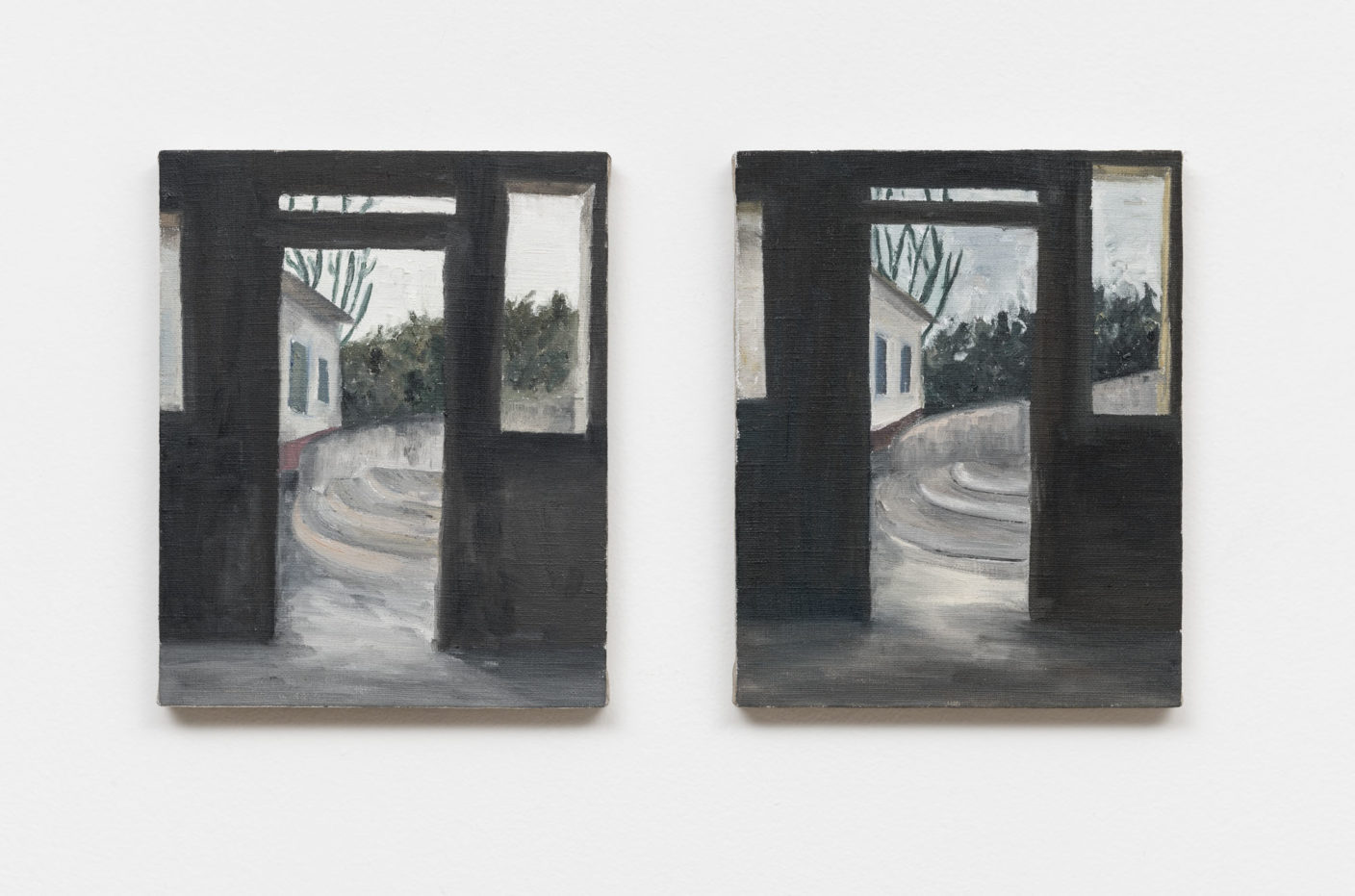
Renata began her career in the early 2000s, appearing among the members of the 2000e8 group, alongside Ana Elisa Egreja, Bruno Dunley, Marcos Brias, Marina Rheingantz, Regina Parra, Rodolpho Parigi and Rodrigo Bivar. Artist and researcher, she graduated in Visual Arts from Fundação Armando Alvares Penteado (FAAP) in 2006, having completed her Doctorate in Processes and Procedures from Universidade Estadual de São Paulo in 2020. She participated in residencies in Germany, Brazil, United States, Netherlands, Italy and Iceland.
The artist works with painting, installations and sound projects, juxtaposing different temporalities, in attempt to promote critical and urgent reflections and apprehensions about our current violent relation with the environment. In 2015 Renata received an award from the Künstlerhaus Lukas, motivating her research on the landscapes of Caspar David Friedrich. She also features in “Pintura Brasileira Séc. XXI”, published by Cobogó.
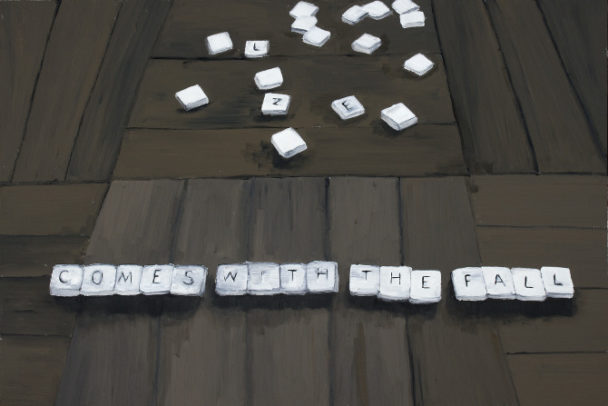

Comes with the fall, 2012
Oil and wax on canvas
60 × 90 cm
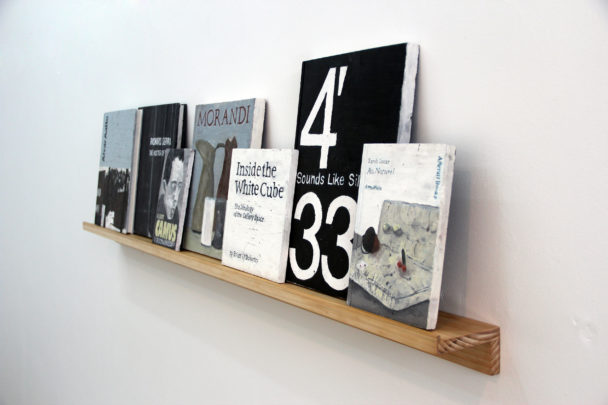
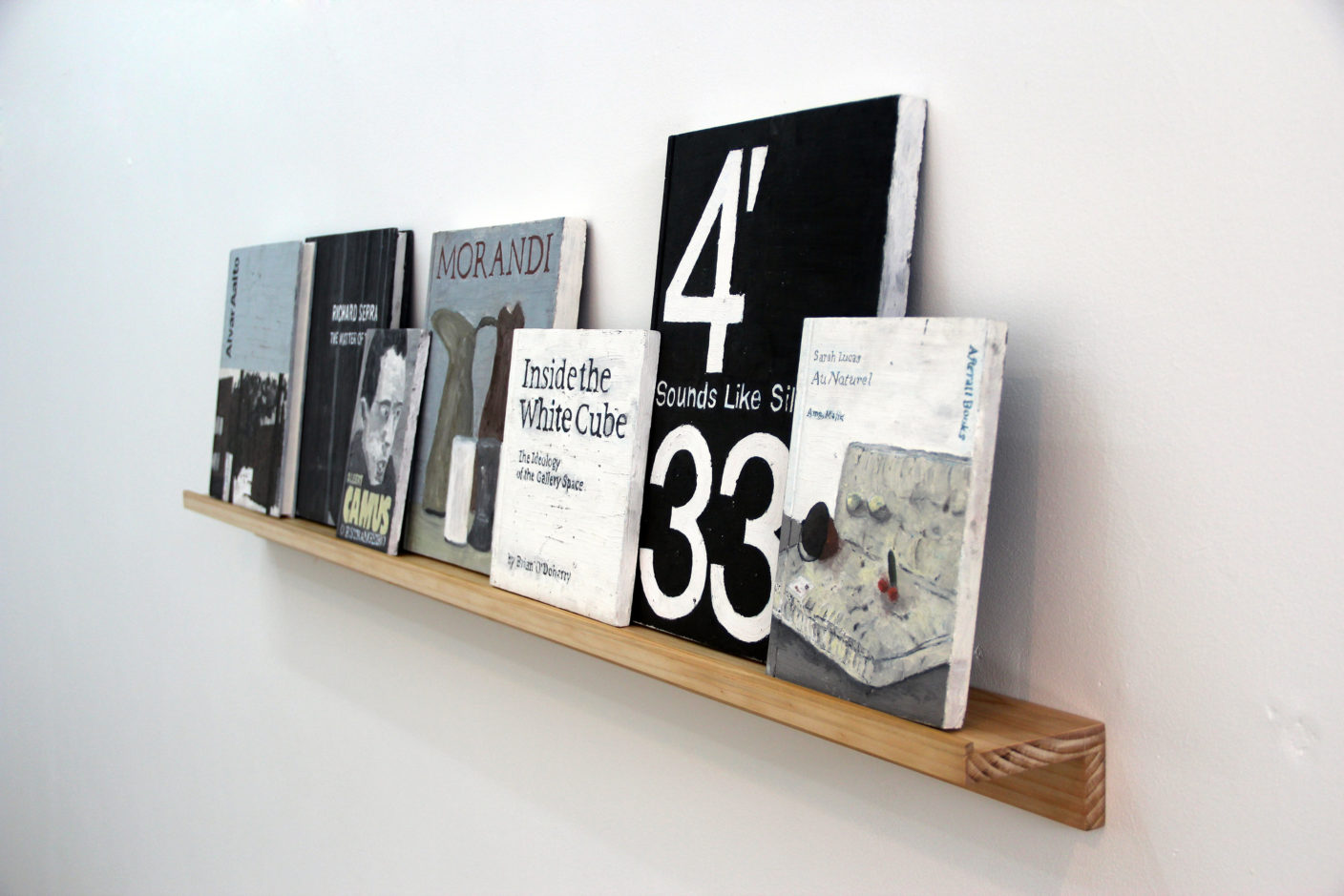
Aalto, Serra, Camus, Morandi, O’Doherty, Cage, Lucas, 2015
Oil and wax on cedar and wooden shelf
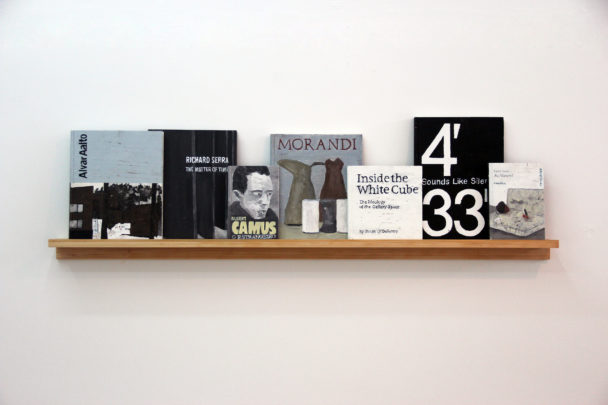
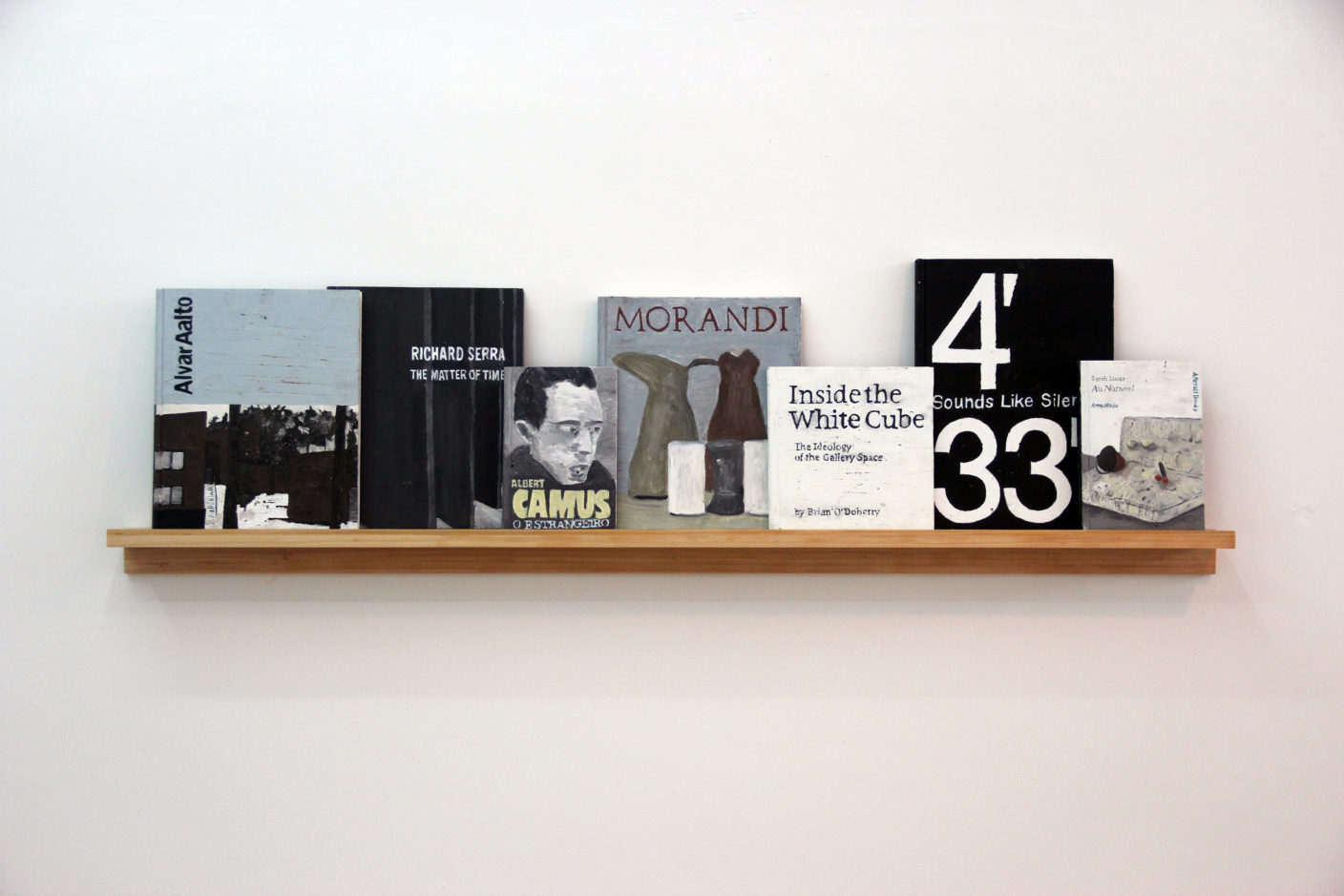
Aalto, Serra, Camus, Morandi, O’Doherty, Cage, Lucas, 2015
Oil and wax on cedar and wooden shelf
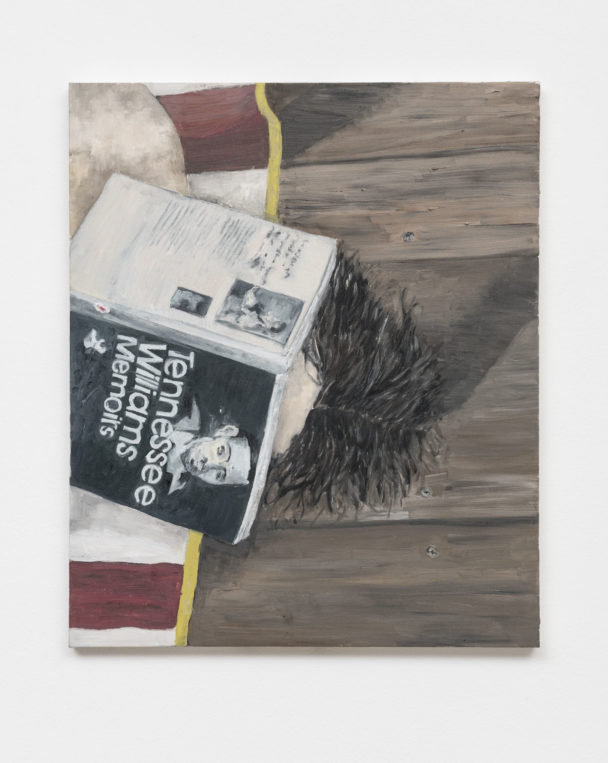
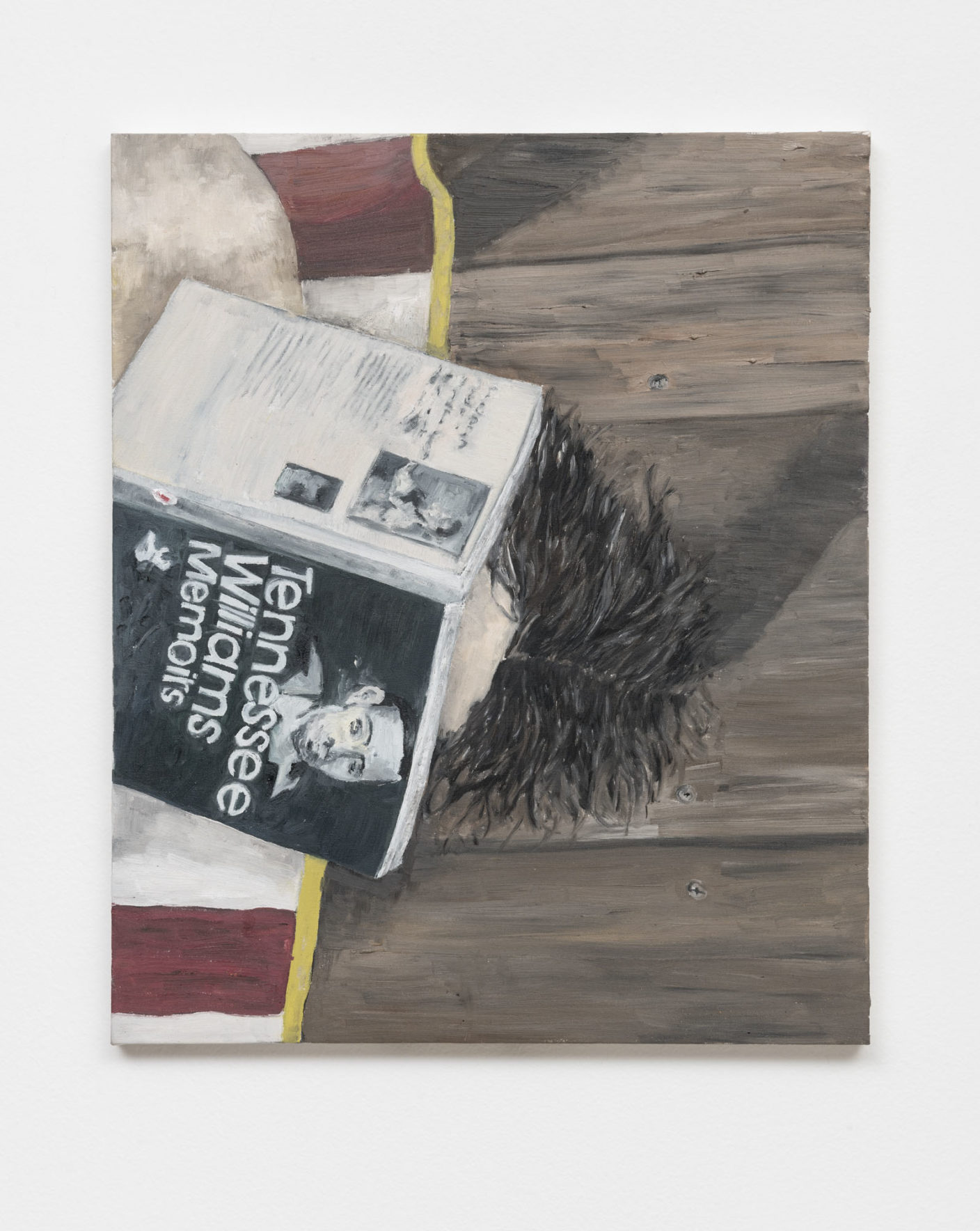
Artun(Memoirs), 2021
Oil and wax on canvas
60 × 50 cm
This work was part of the exhibition “Sono Leve”, at auroras, São Paulo, 2021.
This “Sono Leve” [Light Sleep] was not contaminated by the nightmare, on the contrary, it reflects a luminous well-being; the gaze continues to focus on framing familiar scenes that the environment provides and can linger on them, there is time.
[excerpt from the text written on the occasion of the exhibition]
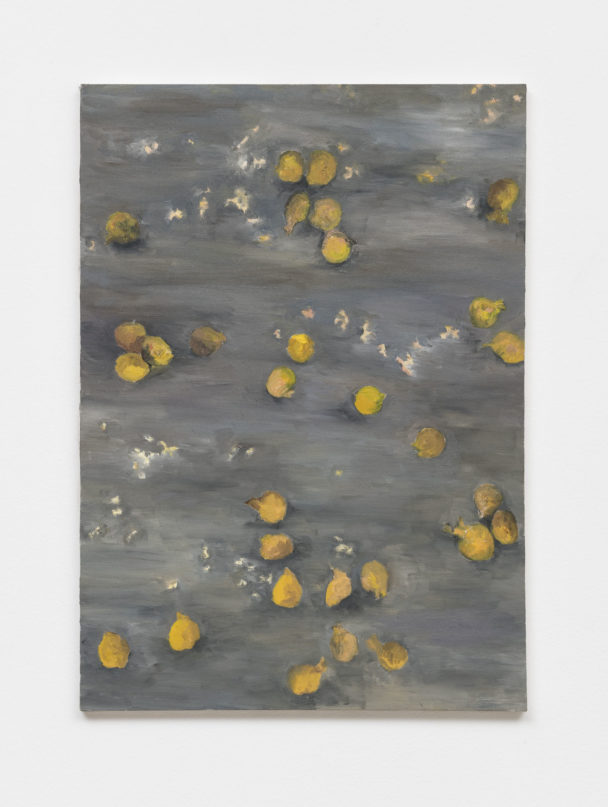

coquinhos, 2021
Oil and wax on canvas
70 × 50 cm
This work was part of the exhibition “Sono Leve”, at auroras, São Paulo, 2021.
This “Sono Leve” [Light Sleep] was not contaminated by the nightmare, on the contrary, it reflects a luminous well-being; the gaze continues to focus on framing familiar scenes that the environment provides and can linger on them, there is time.
[excerpt from the text written on the occasion of the exhibition]

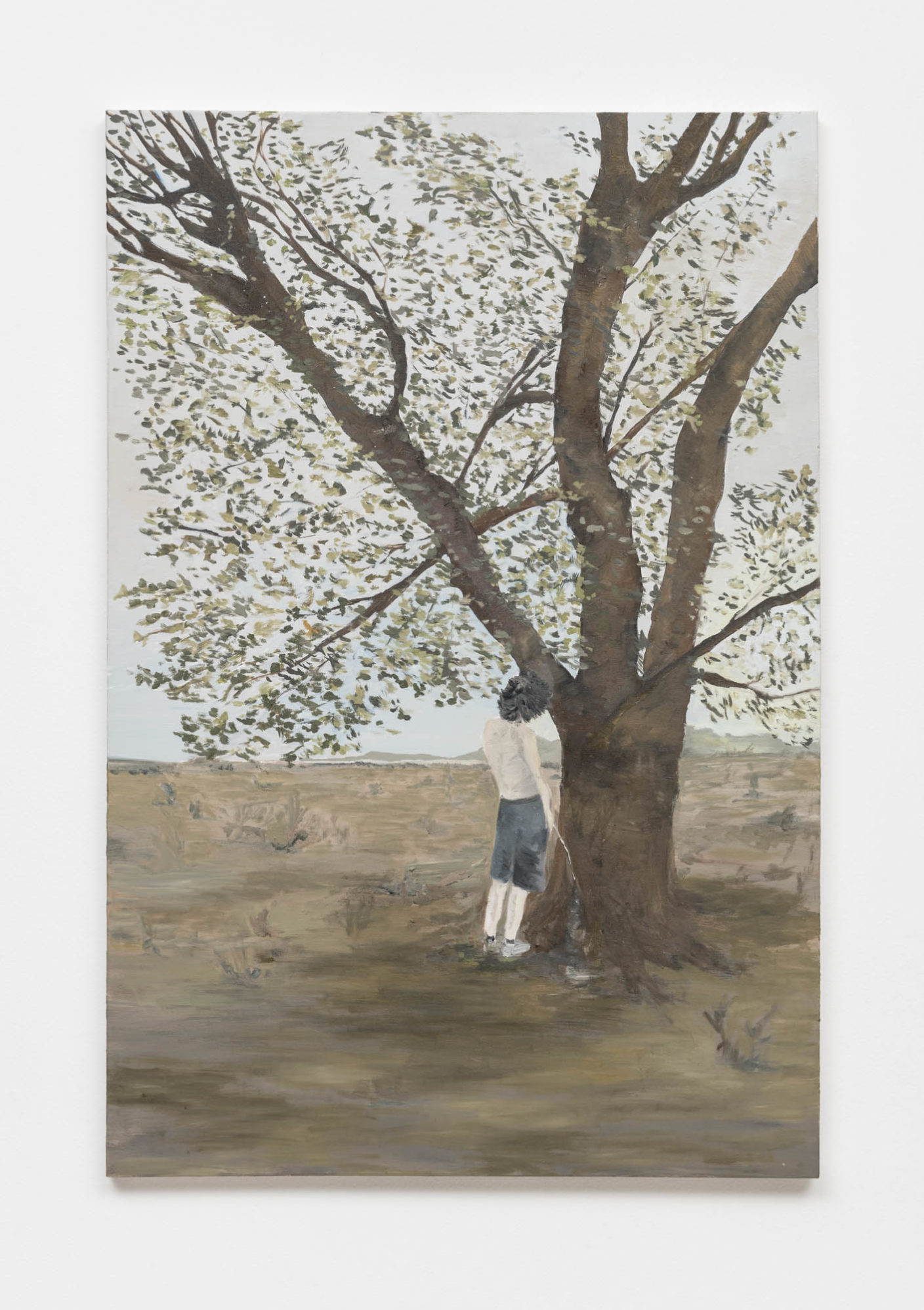
Corner, 2021
Oil and wax on canvas
90 × 60 cm
This work was part of the exhibition “Sono Leve”, at auroras, São Paulo, 2021.
This “Sono Leve” [Light Sleep] was not contaminated by the nightmare, on the contrary, it reflects a luminous well-being; the gaze continues to focus on framing familiar scenes that the environment provides and can linger on them, there is time.
[excerpt from the text written on the occasion of the exhibition]
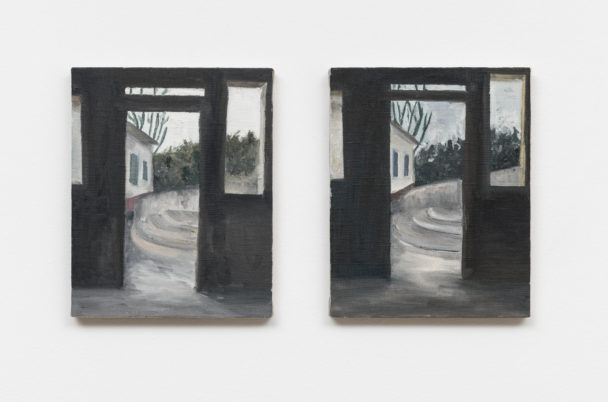

duo, 2021
Oil and wax on canvas
Diptych, 24.5 × 30 cm each
This work was part of the exhibition “Sono Leve”, at auroras, São Paulo, 2021.
This “Sono Leve” [Light Sleep] was not contaminated by the nightmare, on the contrary, it reflects a luminous well-being; the gaze continues to focus on framing familiar scenes that the environment provides and can linger on them, there is time.
[excerpt from the text written on the occasion of the exhibition]

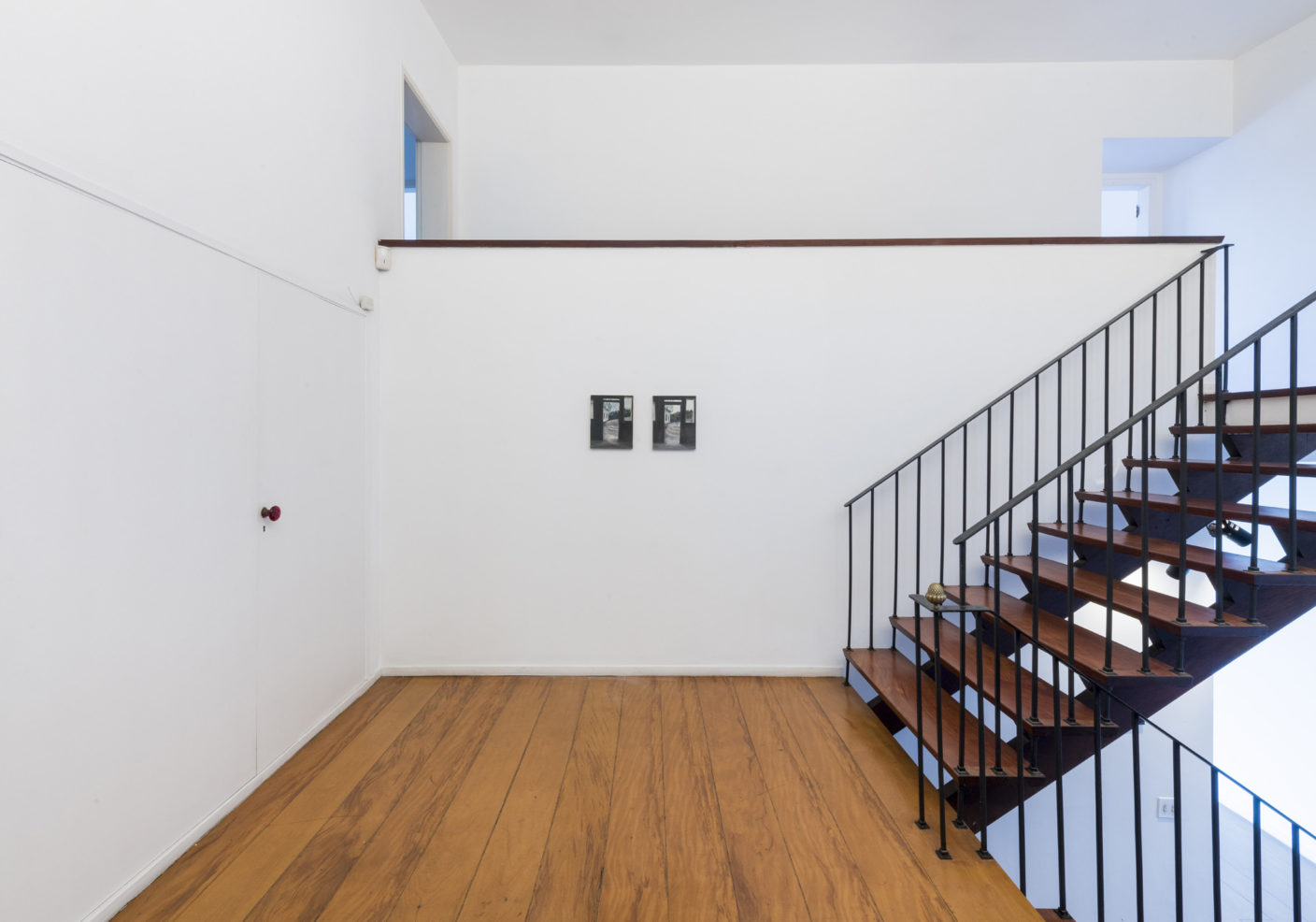
View of the exhibition “Sono Leve”, which took place at auroras, São Paulo, 2021.
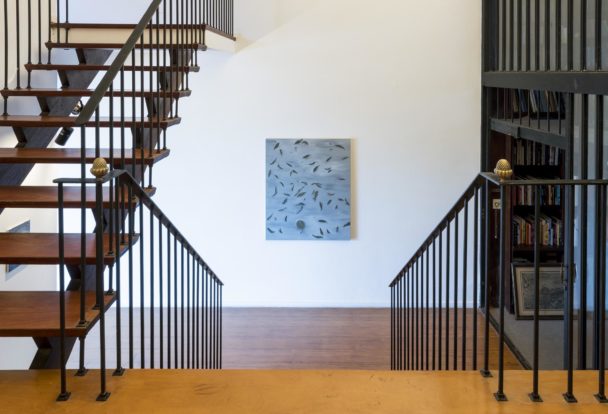
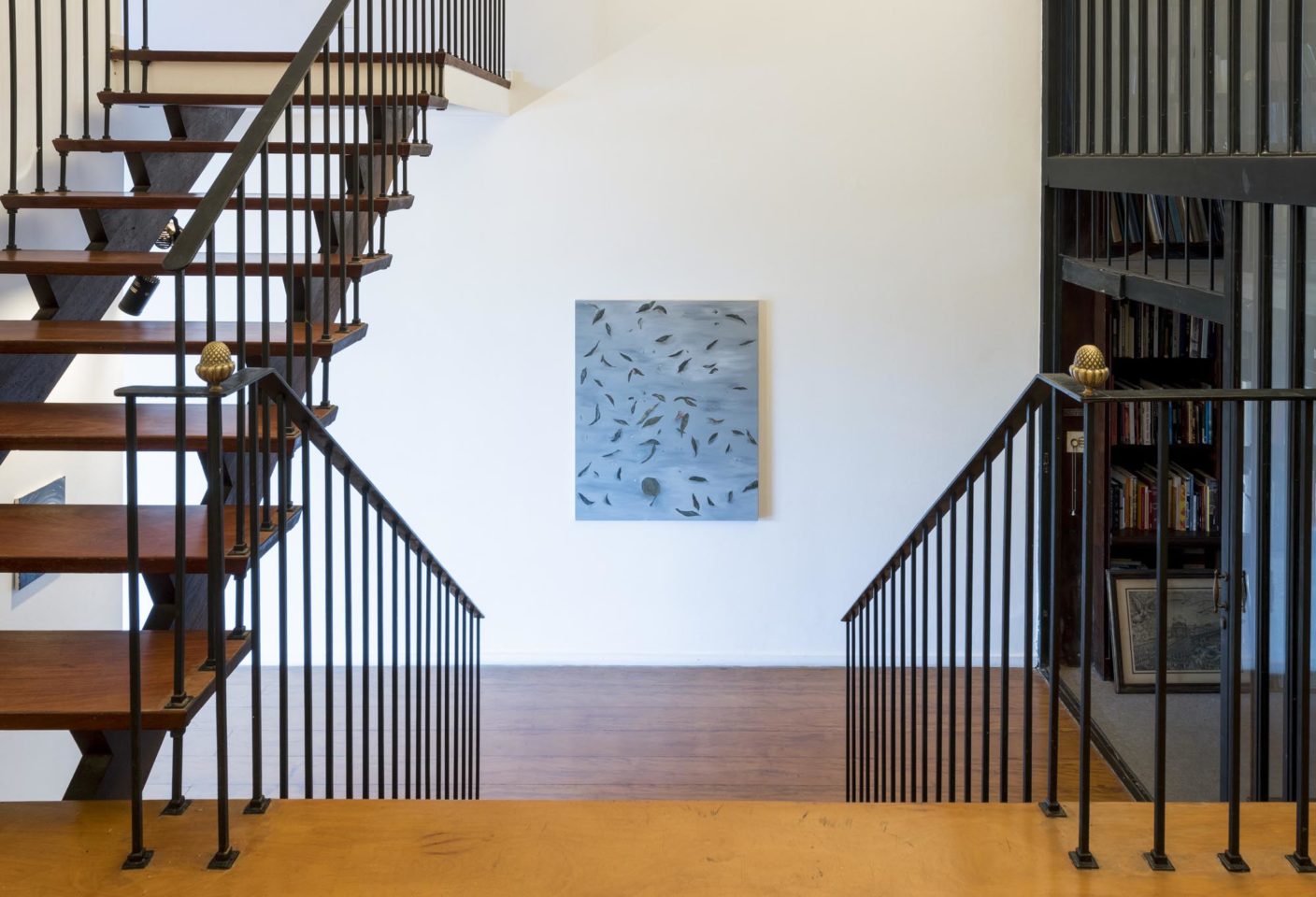
View of the exhibition “Sono Leve”, which took place at auroras, São Paulo, 2021.
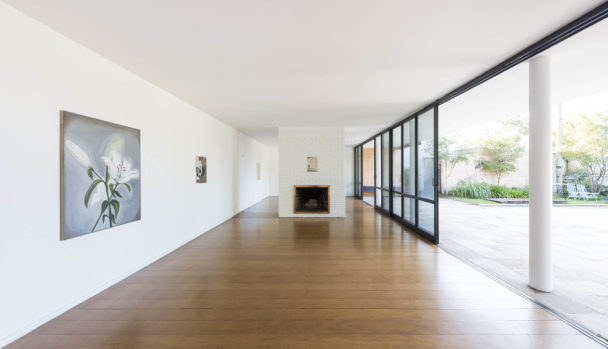

View of the exhibition “Sono Leve”, which took place at auroras, São Paulo, 2021.

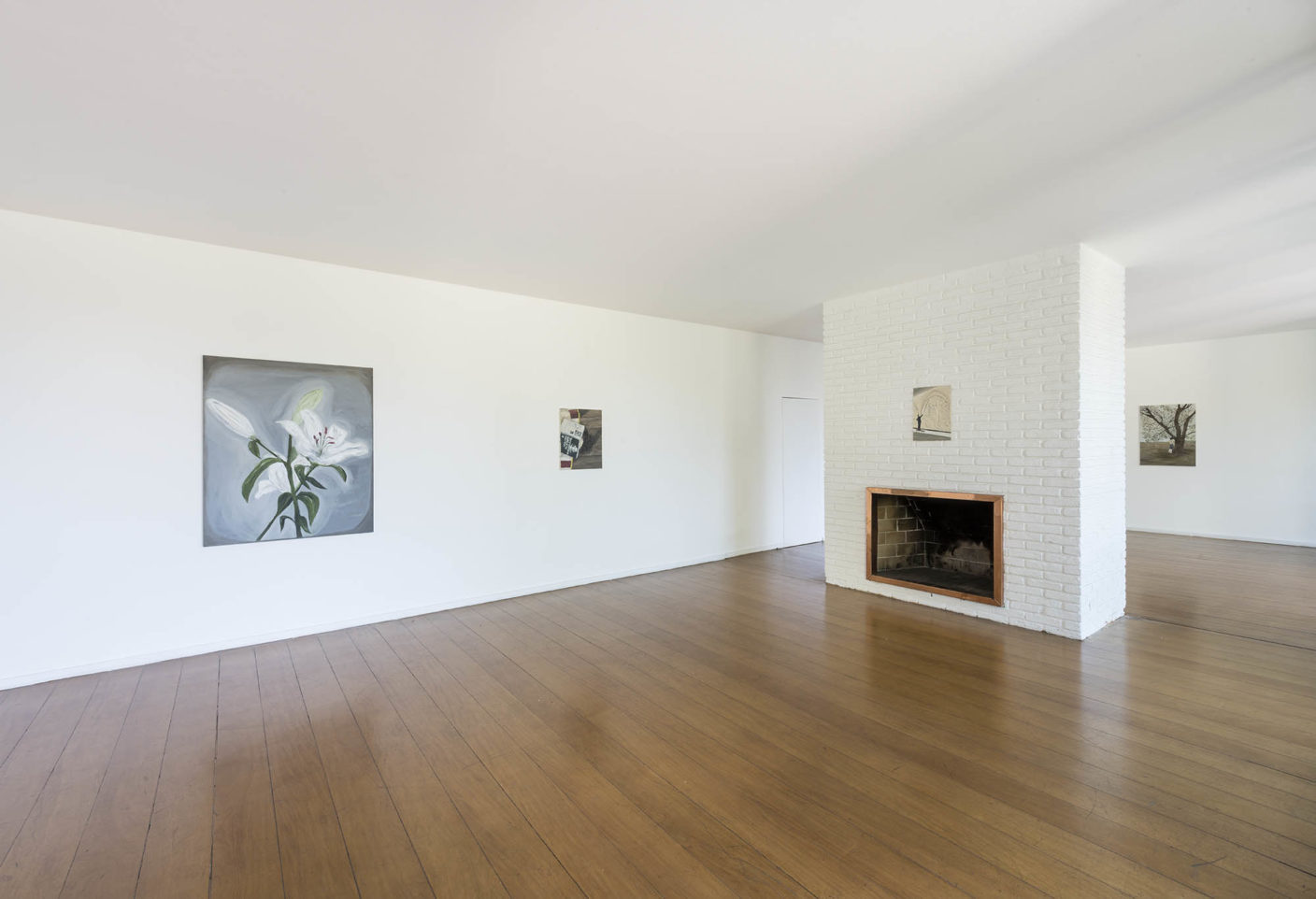
View of the exhibition “Sono Leve”, which took place at auroras, São Paulo, 2021.

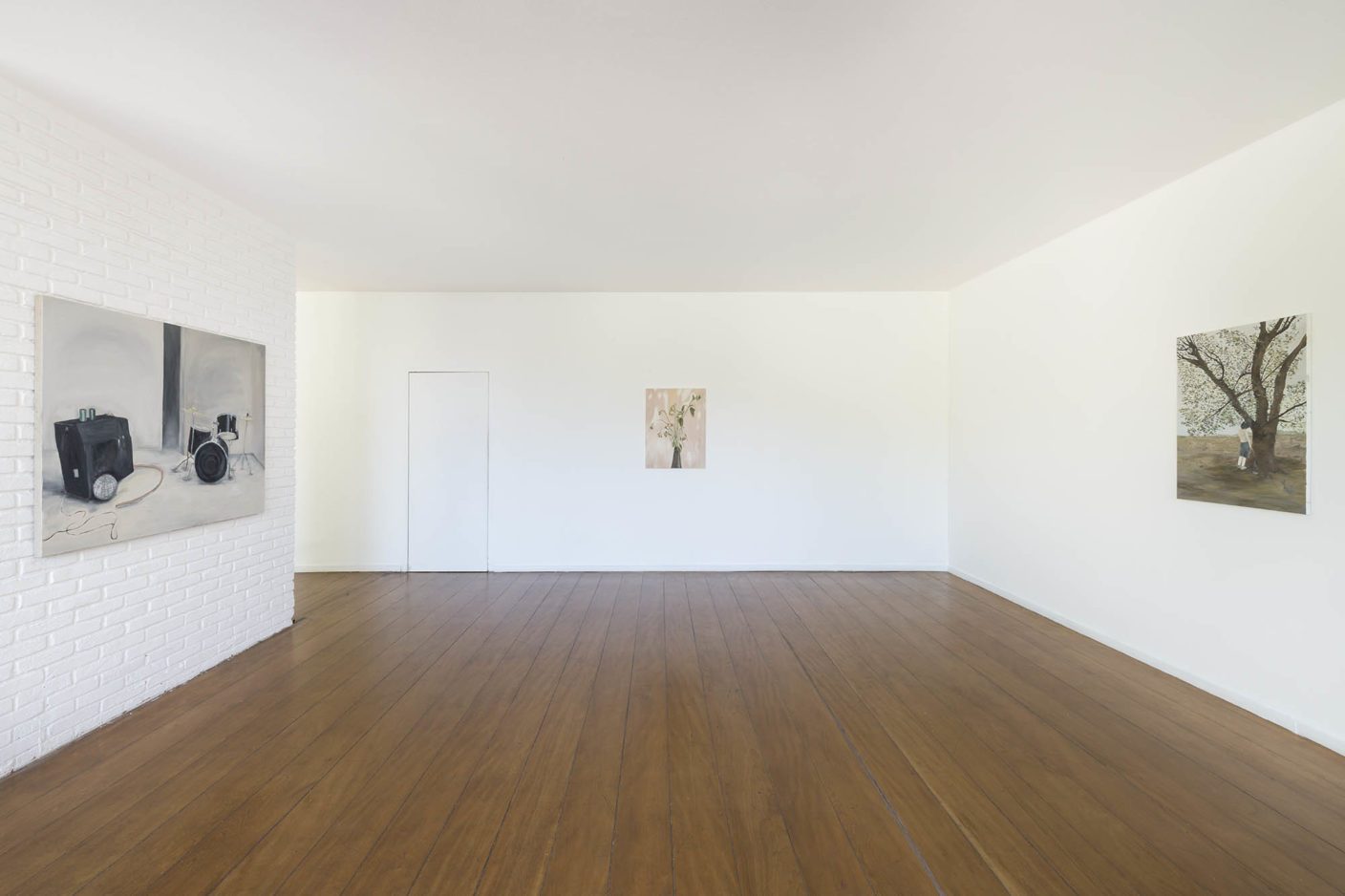
View of the exhibition “Sono Leve”, which took place at auroras, São Paulo, 2021.
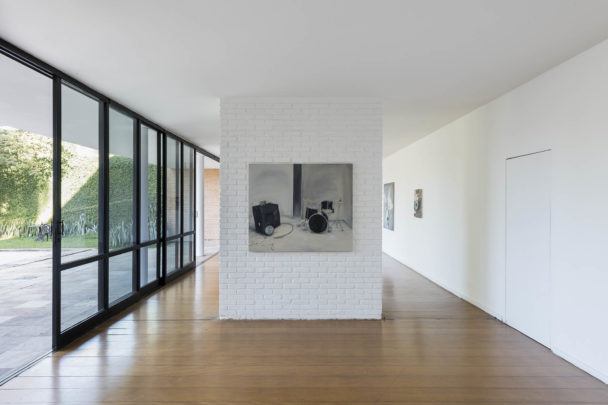
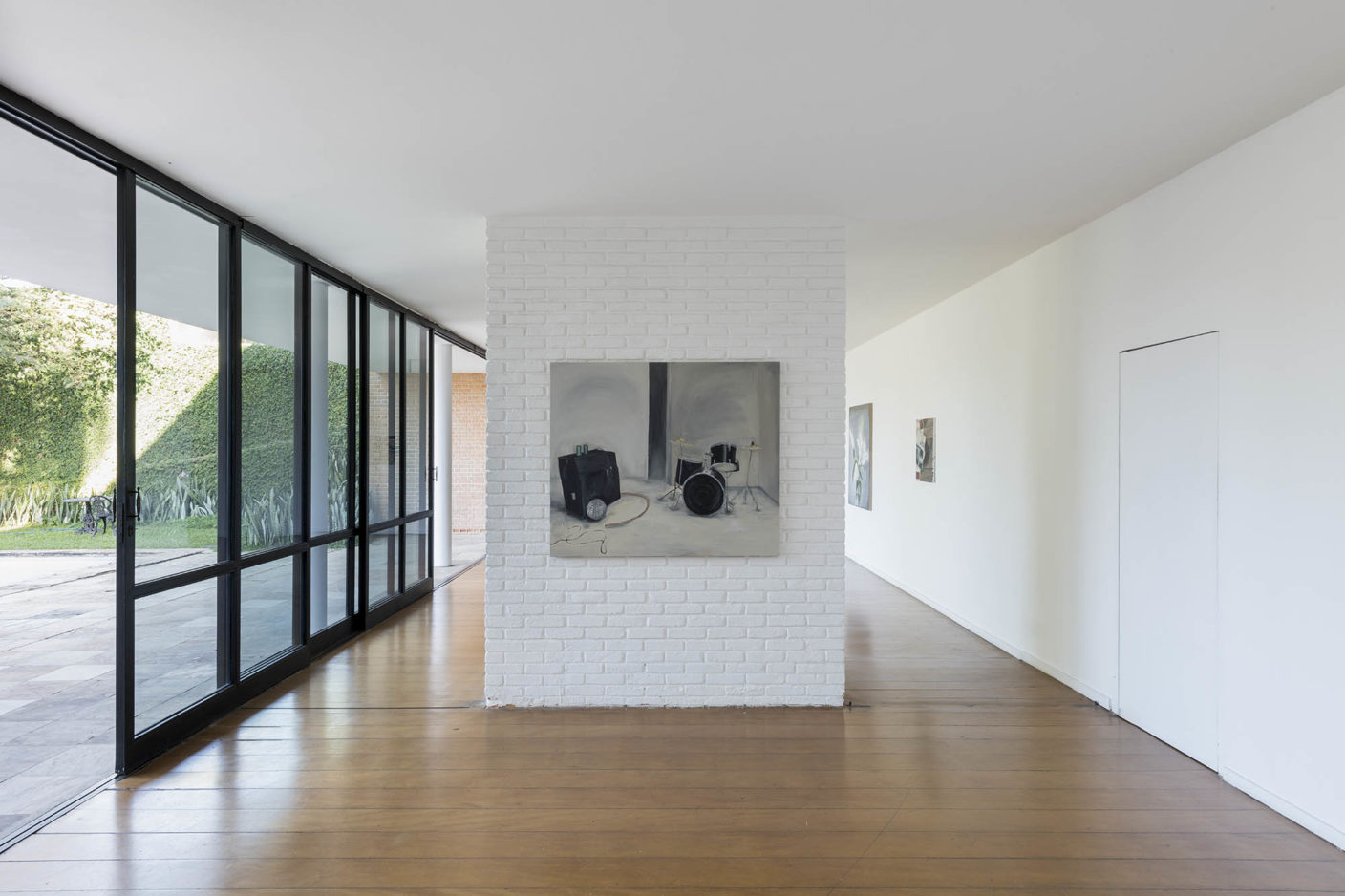
View of the exhibition “Sono Leve”, which took place at auroras, São Paulo, 2021.

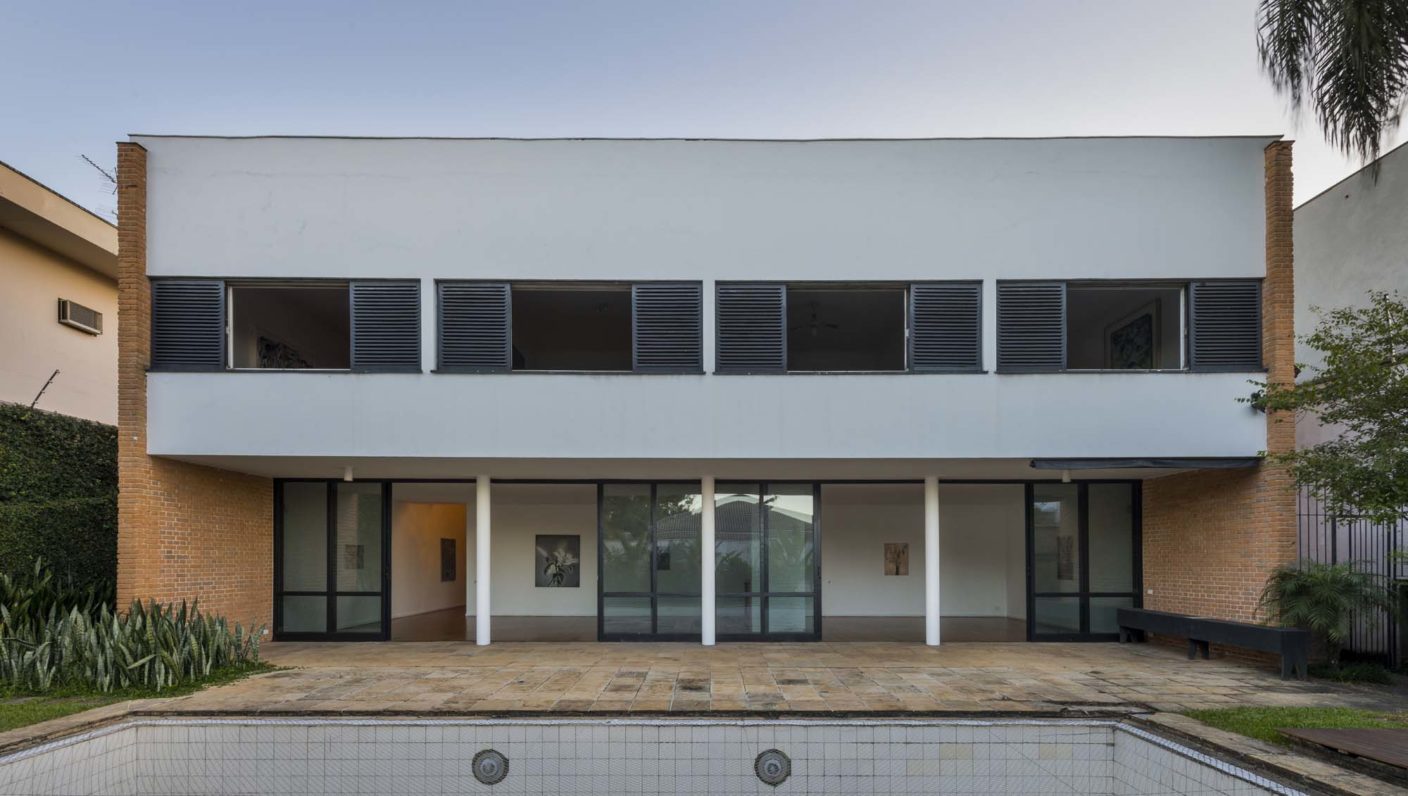
View of the exhibition “Sono Leve”, which took place at auroras, São Paulo, 2021.
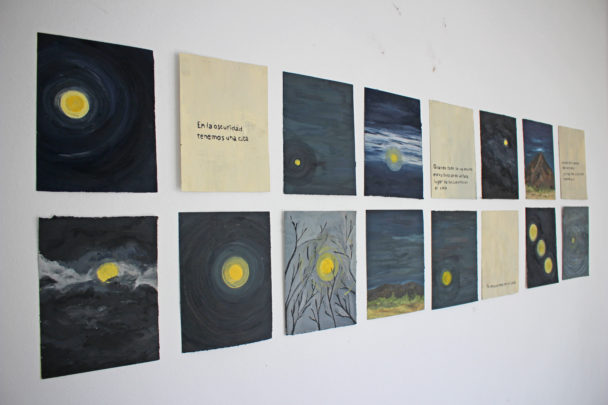
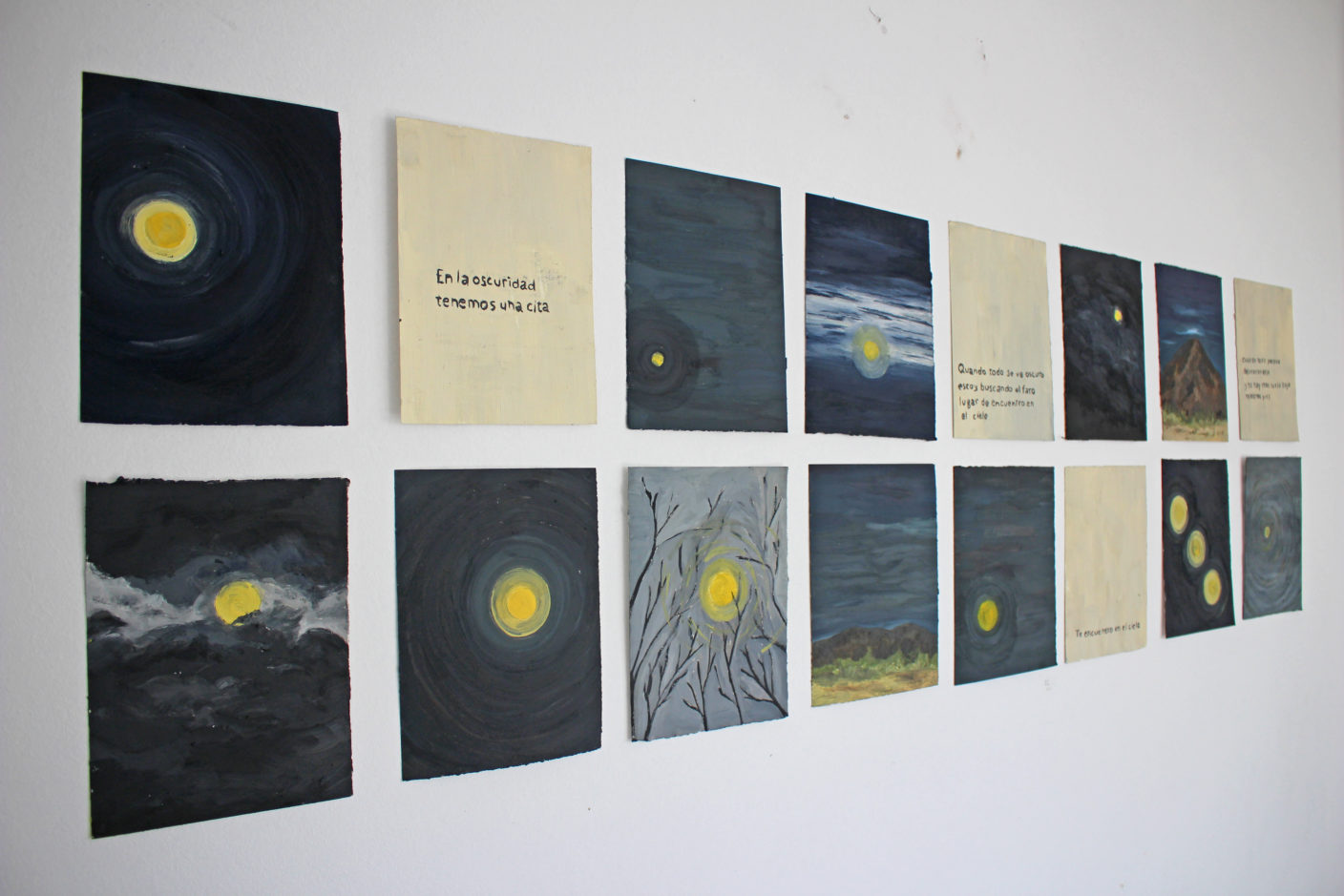
La luna, un faro, 2021
This work was part of the exhibition “Cuando no hay sombra es mediodía”, na Nube Gallery, Santa Cruz de la Sierra, Bolivia, 2021.
The works presented in the exhibition unfold the meanings of dialogue as a curatorial axis, expanding their reflections and revealing other points of view, in a path that questions the contemporary notion of the world and highlights the capacity of the rich natural and cultural universe American in inspiring other social settings and knowledge.
[excerpt from the text written on the occasion of the exhibition]
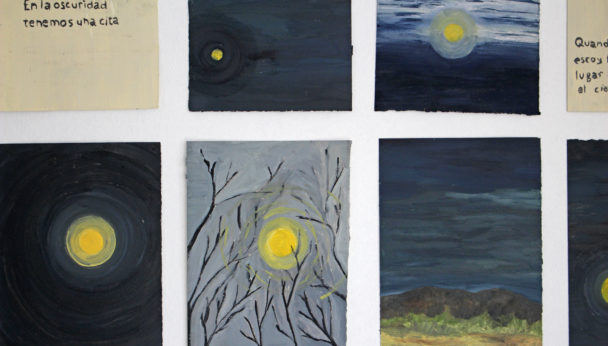

La luna, un faro, 2021
This work was part of the exhibition “Cuando no hay sombra es mediodía”, na Nube Gallery, Santa Cruz de la Sierra, Bolivia, 2021.
The works presented in the exhibition unfold the meanings of dialogue as a curatorial axis, expanding their reflections and revealing other points of view, in a path that questions the contemporary notion of the world and highlights the capacity of the rich natural and cultural universe American in inspiring other social settings and knowledge.
[excerpt from the text written on the occasion of the exhibition]

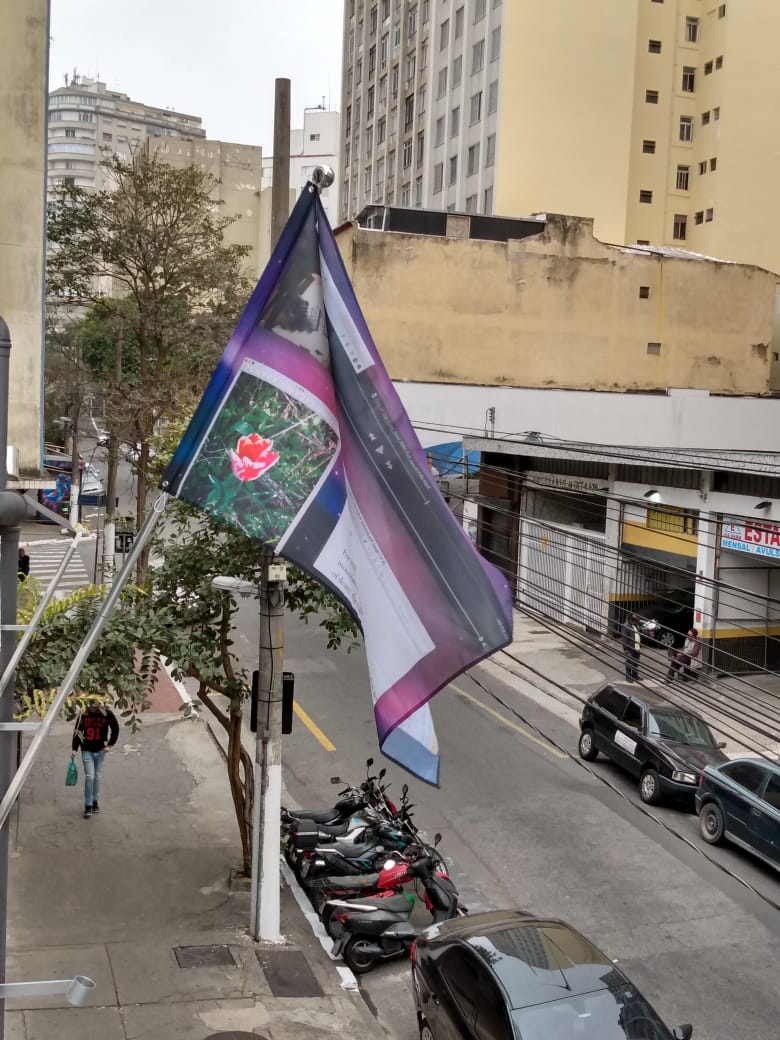
(A lot of) Sorrow / the color of where you are not, 2021
This work was part of the project Four Flags, at Galeria Jaqueline Martins, São Paulo, 2020, and was curated by Julia Mullié and Nick Terra.
For the Four Flags project, De Bonis developed the flag entitled: (A lot of) Sorrow / the color of where you are not. In it we have printed on the semi-transparent fabric the desktop of the artist’s computer, where several windows-stimulus are open at the same time, showing the unique period that we are going through in this pandemic moment, where the computer screen is a window that emits artificial light as a portal that raises new perspectives, solutions, and possibilities, but ends up reflecting our expectations, anxieties and afflictions.
[excerpt from the text written on the occasion of the exhibition]

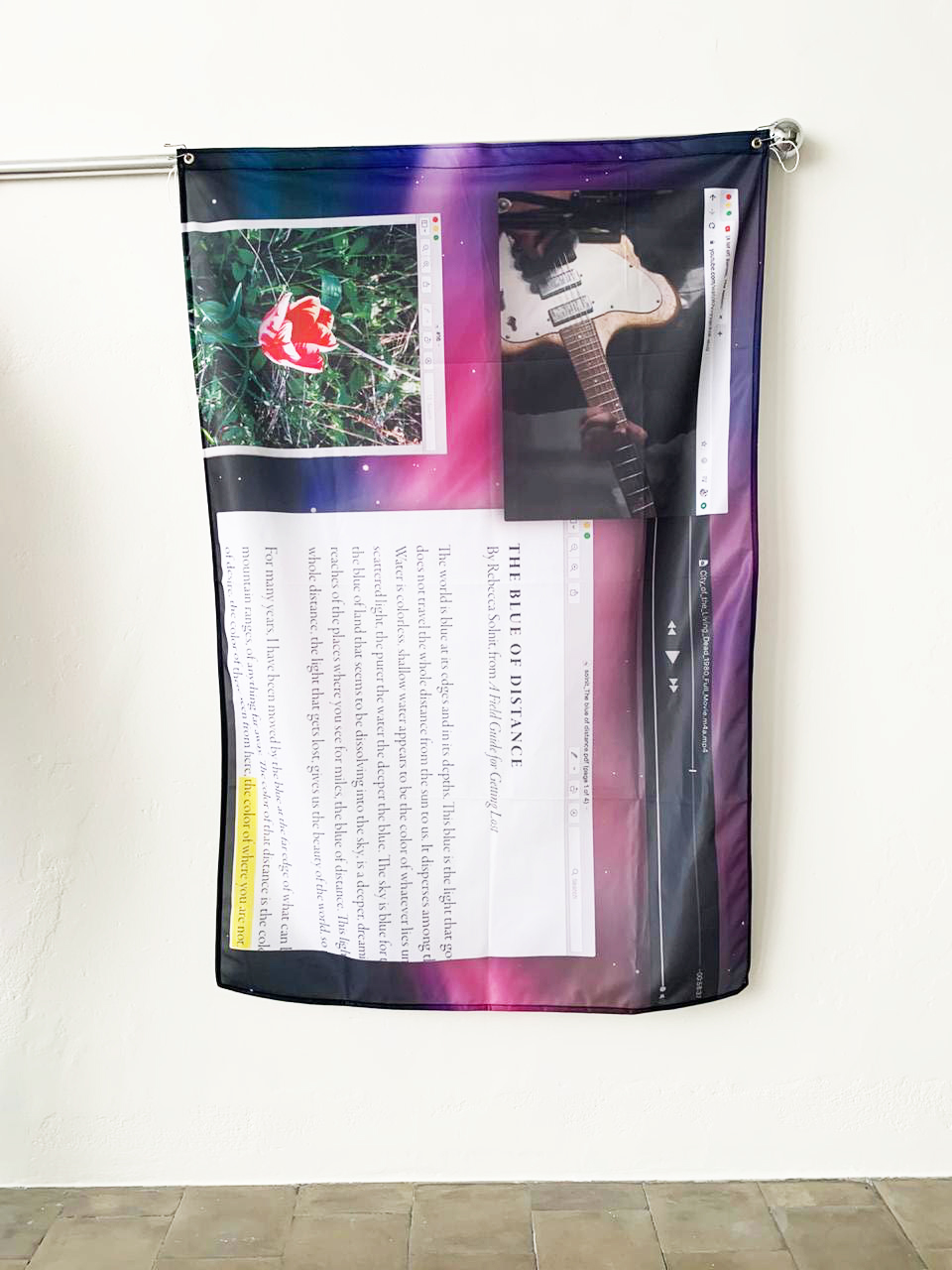
(A lot of) Sorrow / the color of where you are not, 2021
This work was part of the project Four Flags, at Galeria Jaqueline Martins, São Paulo, 2020, and was curated by Julia Mullié and Nick Terra.
For the Four Flags project, De Bonis developed the flag entitled: (A lot of) Sorrow / the color of where you are not. In it we have printed on the semi-transparent fabric the desktop of the artist’s computer, where several windows-stimulus are open at the same time, showing the unique period that we are going through in this pandemic moment, where the computer screen is a window that emits artificial light as a portal that raises new perspectives, solutions, and possibilities, but ends up reflecting our expectations, anxieties and afflictions.
[excerpt from the text written on the occasion of the exhibition]
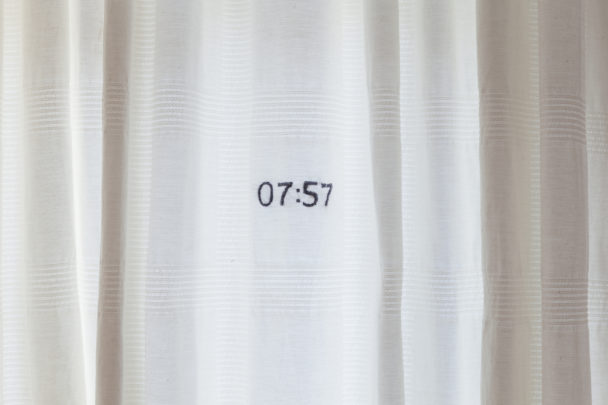
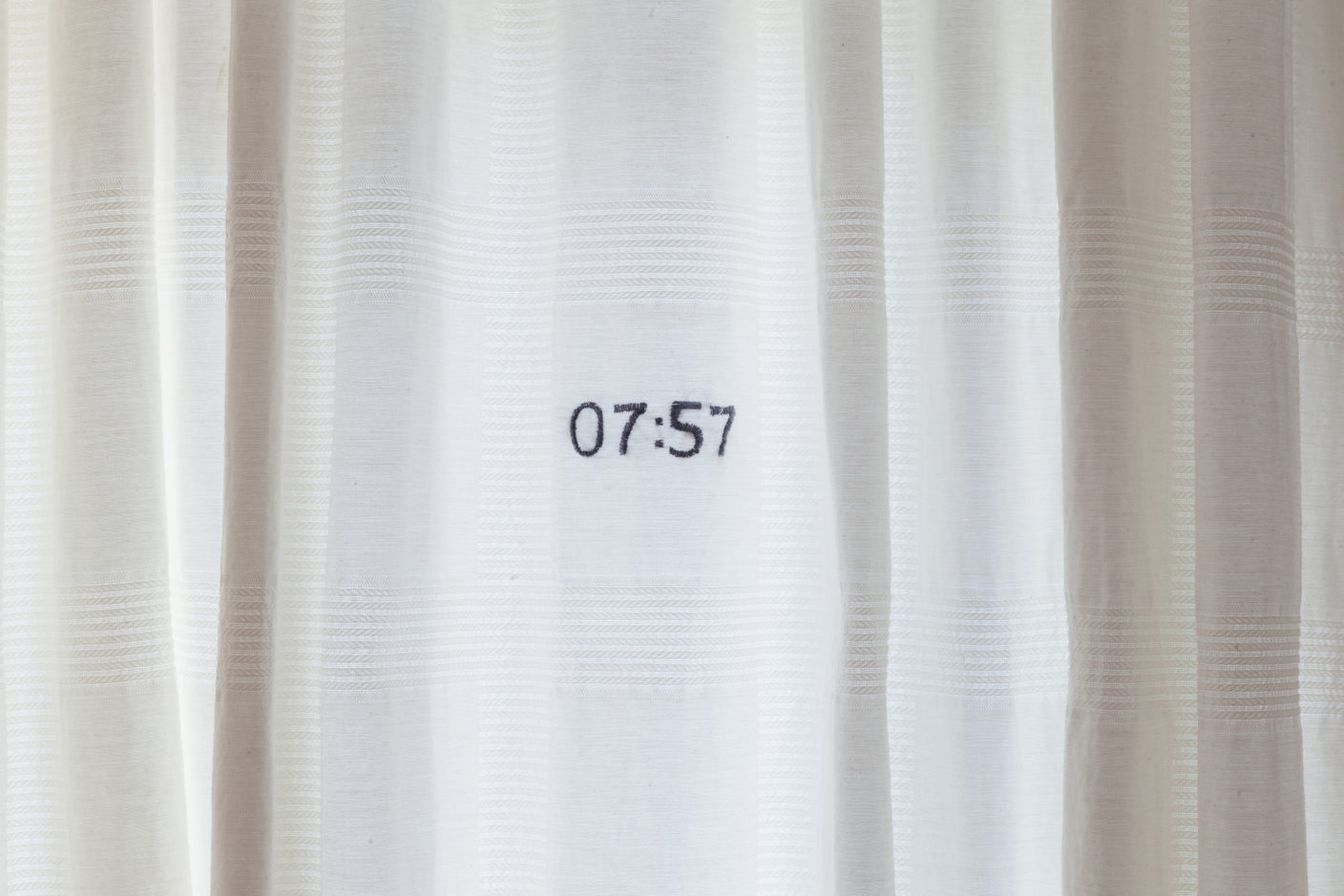
Intervalo, 2020
Emulsified sewing thread with cyanotype exposed to moonlight (from 5:50pm to 7:5am, dark interval on the eve of the opening of the exhibition), hand embroidered on the space’s existing curtains.


Intervalo, 2020
Emulsified sewing thread with cyanotype exposed to moonlight (from 5:50pm to 7:5am, dark interval on the eve of the opening of the exhibition), hand embroidered on the space’s existing curtains.
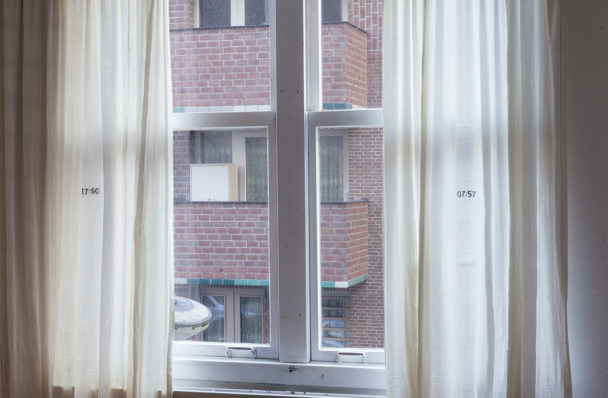
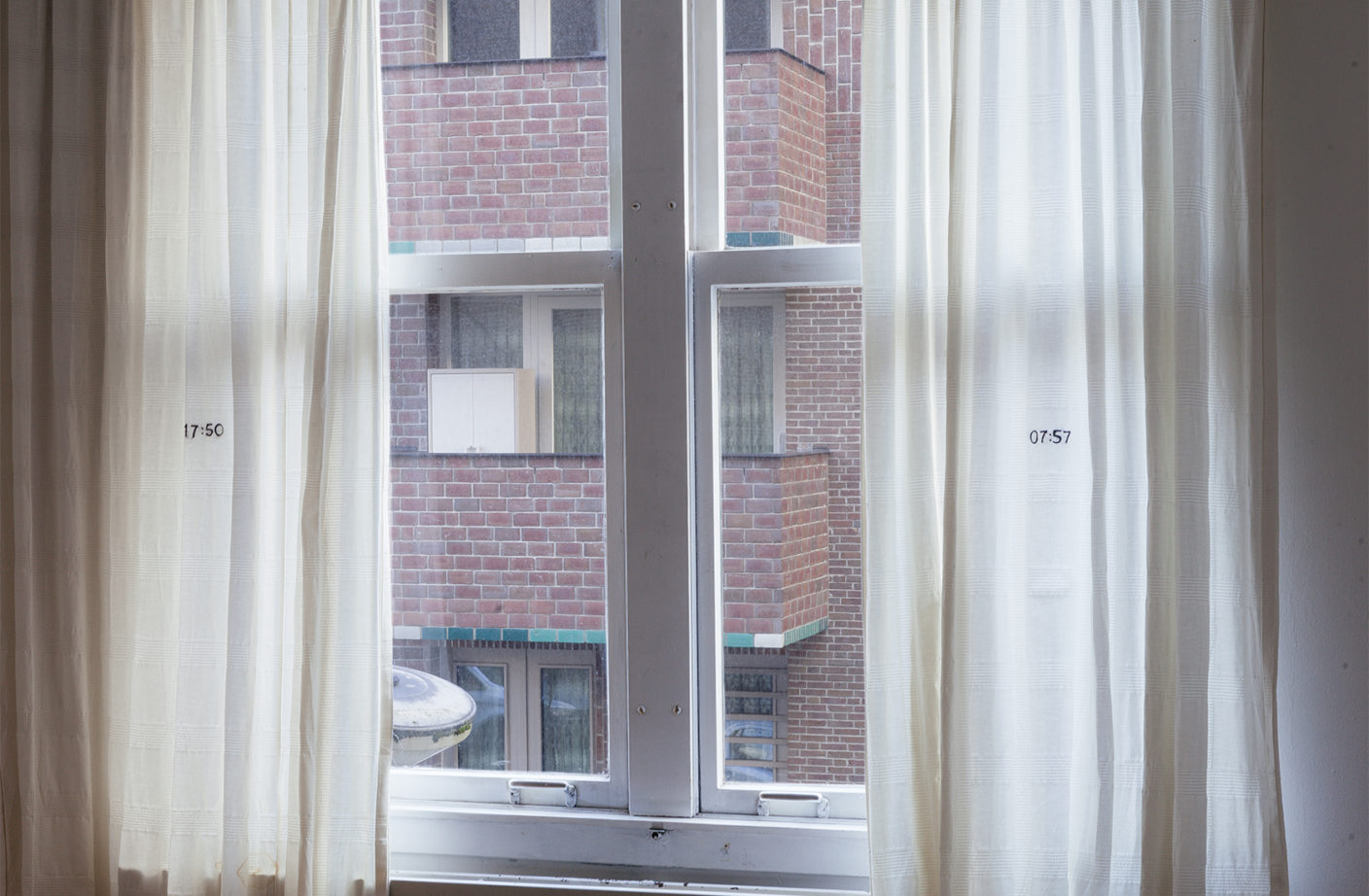
Intervalo, 2020
Emulsified sewing thread with cyanotype exposed to moonlight (from 5:50pm to 7:5am, dark interval on the eve of the opening of the exhibition), hand embroidered on the space’s existing curtains.
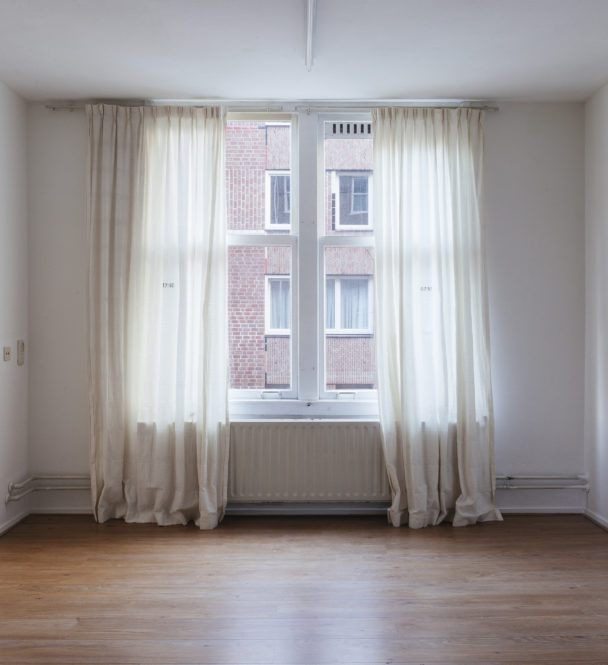
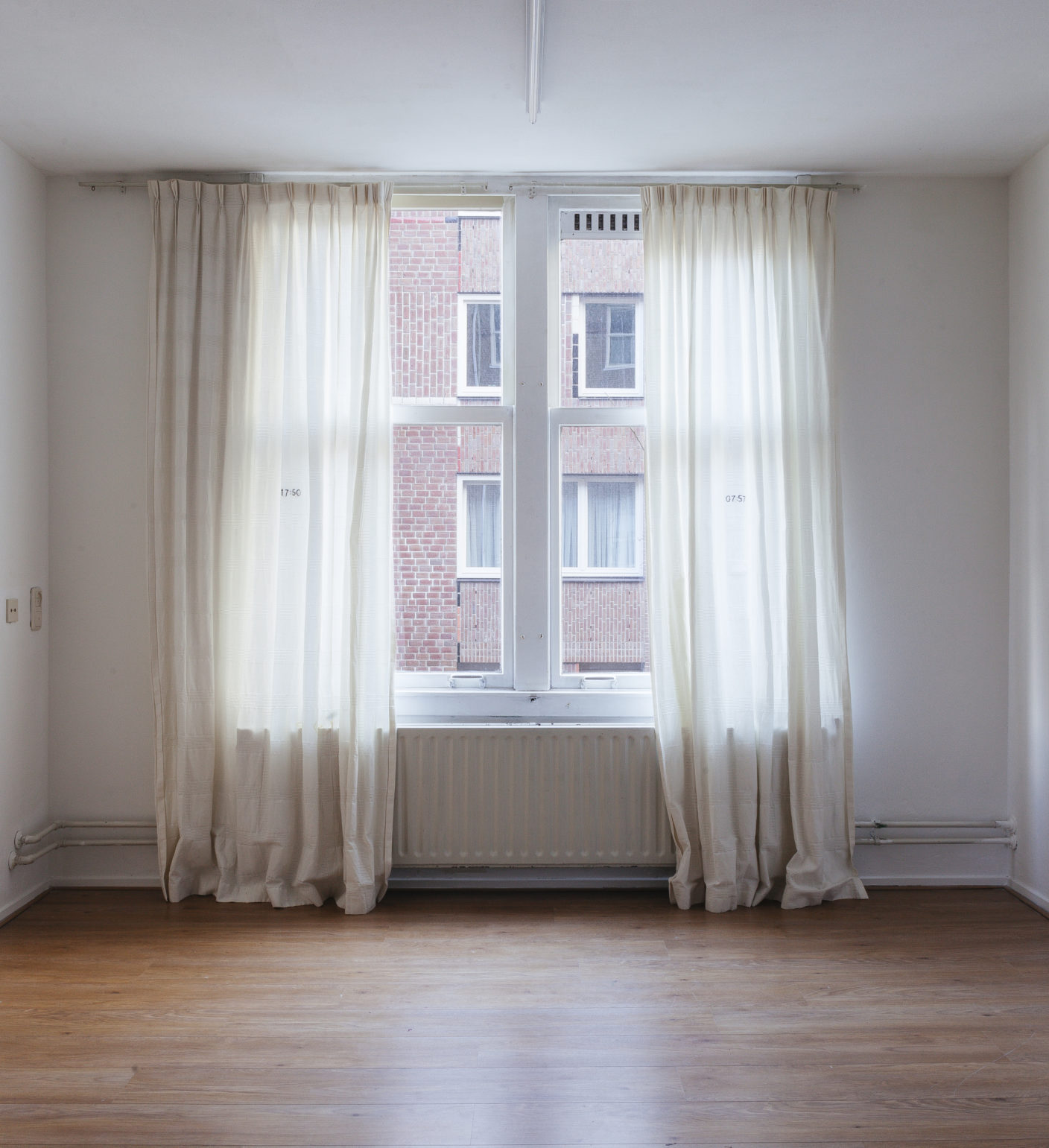
Intervalo, 2020
Emulsified sewing thread with cyanotype exposed to moonlight (from 5:50pm to 7:5am, dark interval on the eve of the opening of the exhibition), hand embroidered on the space’s existing curtains.
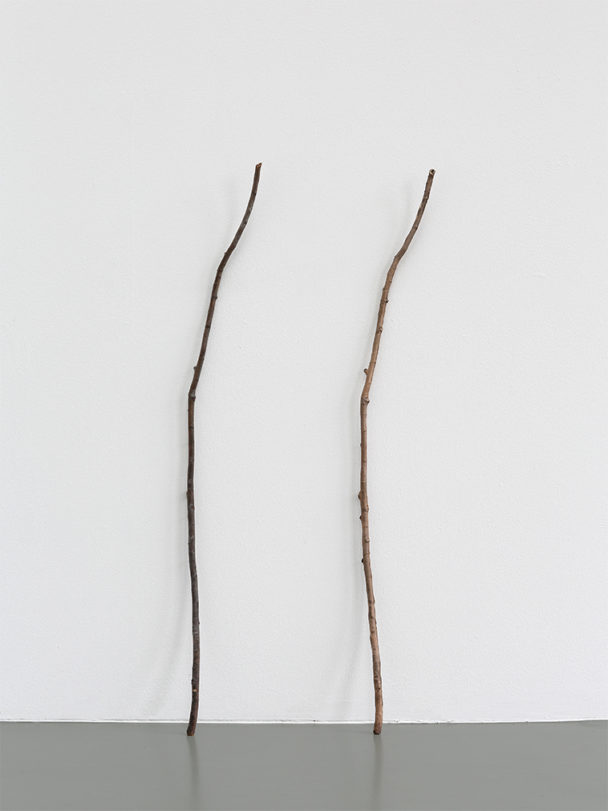
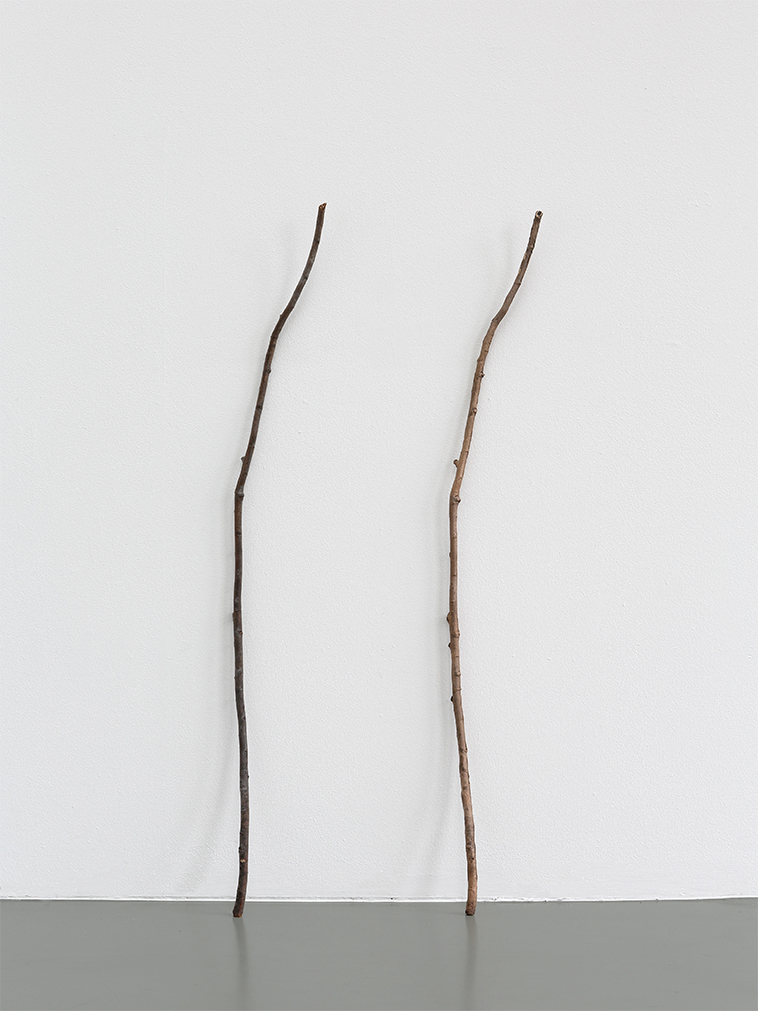
How do I know you are who you say you are?, 2015–2018
Bronze branch and branch copy
The ghostly presence of the bronze replica of a branch placed side by side with the original branch somehow haunts our thoughts regarding mortality, memory and presence. Similar to the space traversed by the fall of a leaf — from the branch to the ground — the gap created between these two almost identical branches portrays the brief sigh that is life. The distinct materiality is also an important content of the work, where the ephemeral nature of the wooden branch is opposed to the monumentality and validity of the bronze branch, a contrast between our fragile constitutions and our attempts to capture and perpetuate them.
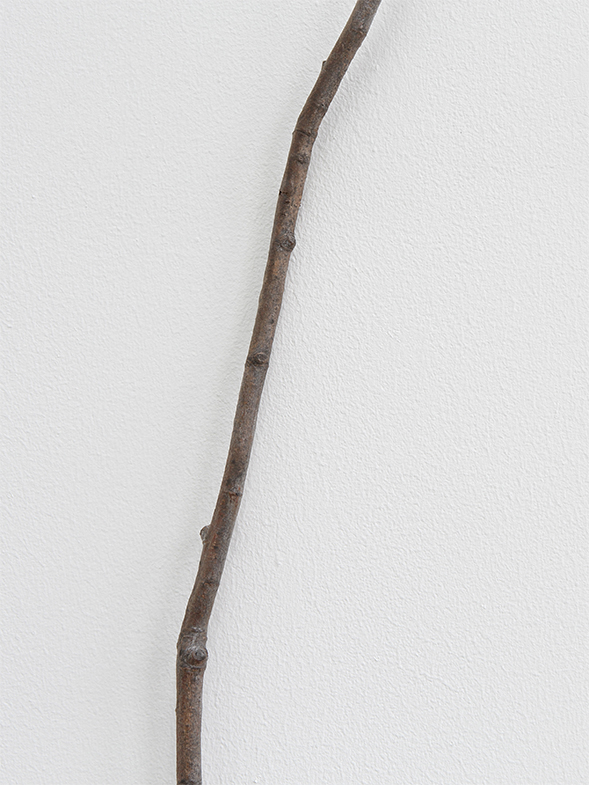

How do I know you are who you say you are?, 2015–2018
Bronze branch and branch copy
The ghostly presence of the bronze replica of a branch placed side by side with the original branch somehow haunts our thoughts regarding mortality, memory and presence. Similar to the space traversed by the fall of a leaf — from the branch to the ground — the gap created between these two almost identical branches portrays the brief sigh that is life. The distinct materiality is also an important content of the work, where the ephemeral nature of the wooden branch is opposed to the monumentality and validity of the bronze branch, a contrast between our fragile constitutions and our attempts to capture and perpetuate them.
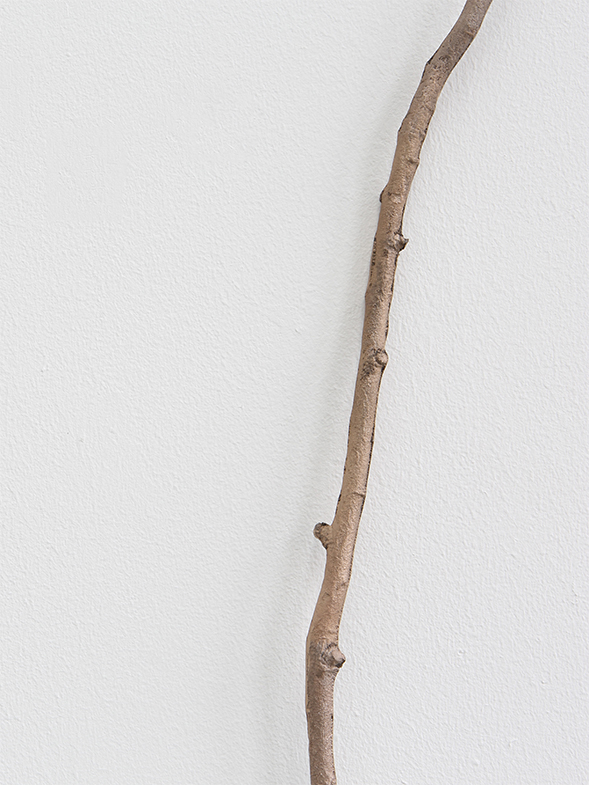

How do I know you are who you say you are?, 2015–2018
Bronze branch and branch copy
The ghostly presence of the bronze replica of a branch placed side by side with the original branch somehow haunts our thoughts regarding mortality, memory and presence. Similar to the space traversed by the fall of a leaf — from the branch to the ground — the gap created between these two almost identical branches portrays the brief sigh that is life. The distinct materiality is also an important content of the work, where the ephemeral nature of the wooden branch is opposed to the monumentality and validity of the bronze branch, a contrast between our fragile constitutions and our attempts to capture and perpetuate them.
How do I know you are who you say you are?, 2015–2018
Bronze branch and branch copy
The ghostly presence of the bronze replica of a branch placed side by side with the original branch somehow haunts our thoughts regarding mortality, memory and presence. Similar to the space traversed by the fall of a leaf — from the branch to the ground — the gap created between these two almost identical branches portrays the brief sigh that is life. The distinct materiality is also an important content of the work, where the ephemeral nature of the wooden branch is opposed to the monumentality and validity of the bronze branch, a contrast between our fragile constitutions and our attempts to capture and perpetuate them.
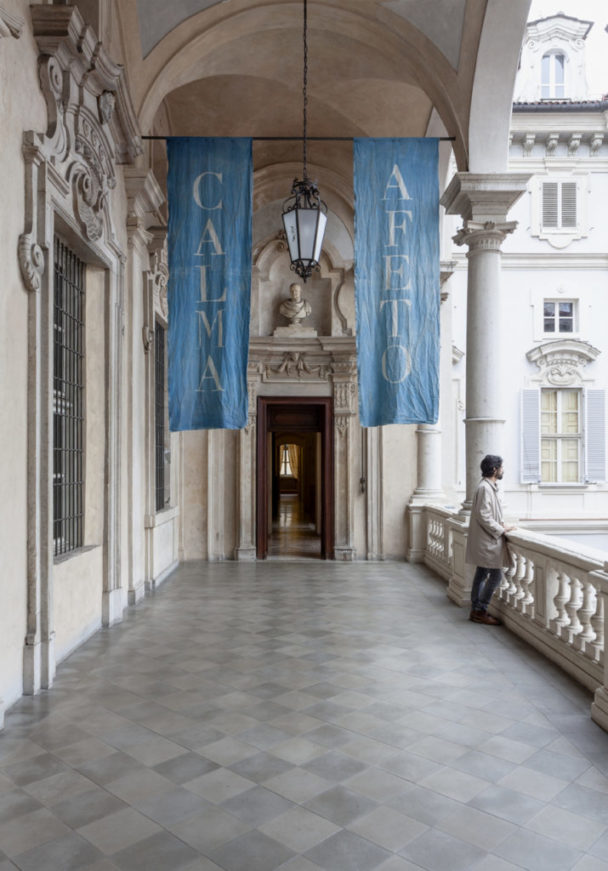
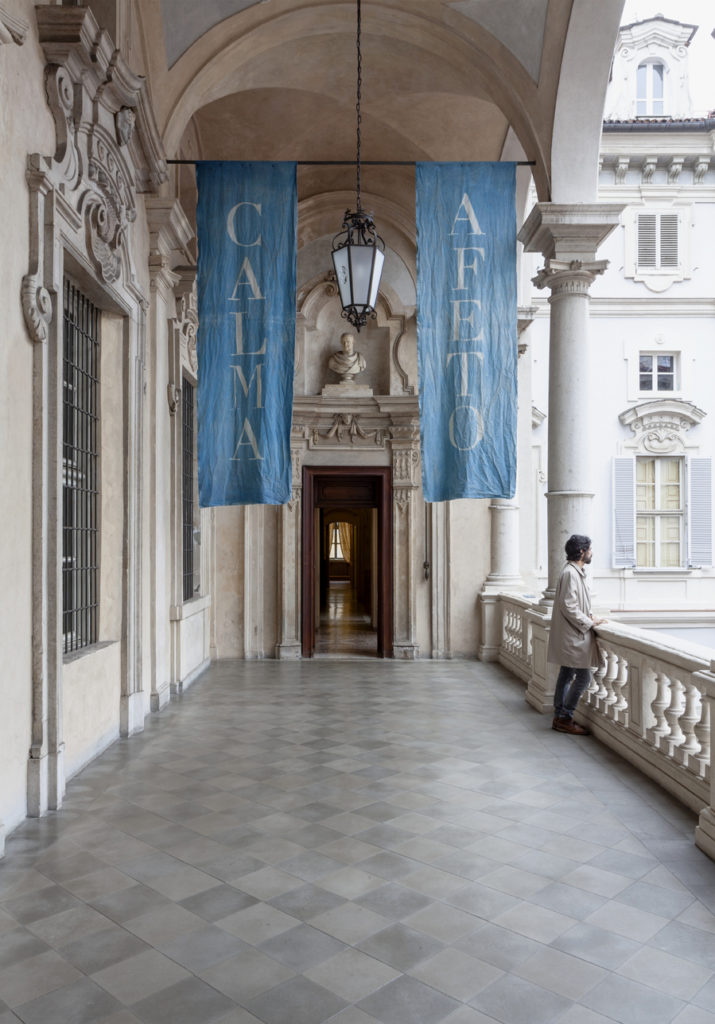
Calma / Afeto, 2018
Cyanotype on cotton
410 × 100 cm
This work was installed at the entrance of the DAMA Art Fair, which took place at the Palazzo Saluzzo, in Turin, Italy, in 2018, in which Renata De Bonis was the winner of the A.R.M. DAMA Prize.
At first glance, visitors felt a moving message entering the Palazzo, in the midst of the Turin Art Week frenzy, but the words Calma [Calm] and Afeto [Affection] referred to an e-mail the artist received from her first gallery owner, more than ten years ago, who for years sold her works for a higher price than she informed the artist. When was confronted by the artist, the gallery owner used these two words: “Let’s resolve this calmly and affectionately”. The work intends to pay attention to the artist’s vulnerability in the art market.
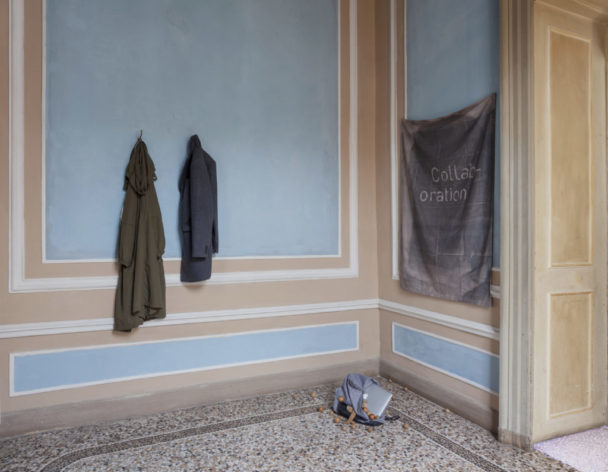
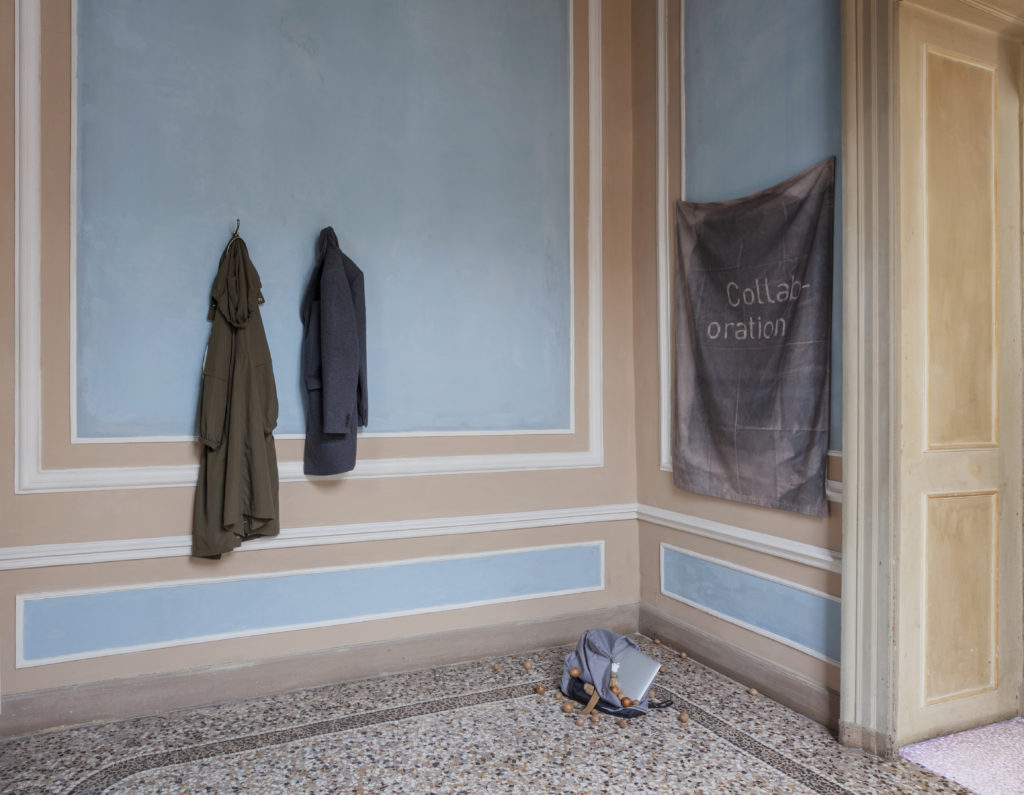
View of the exhibition at Palazzo Saluzzo, Turin, Italy, 2018, the year Renata won the A.R.M. DAMA Prize.
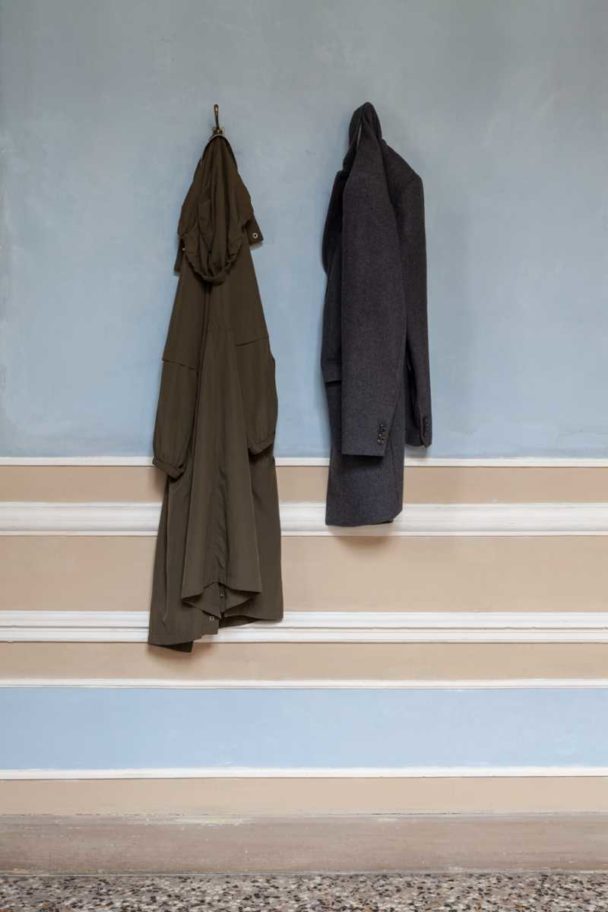
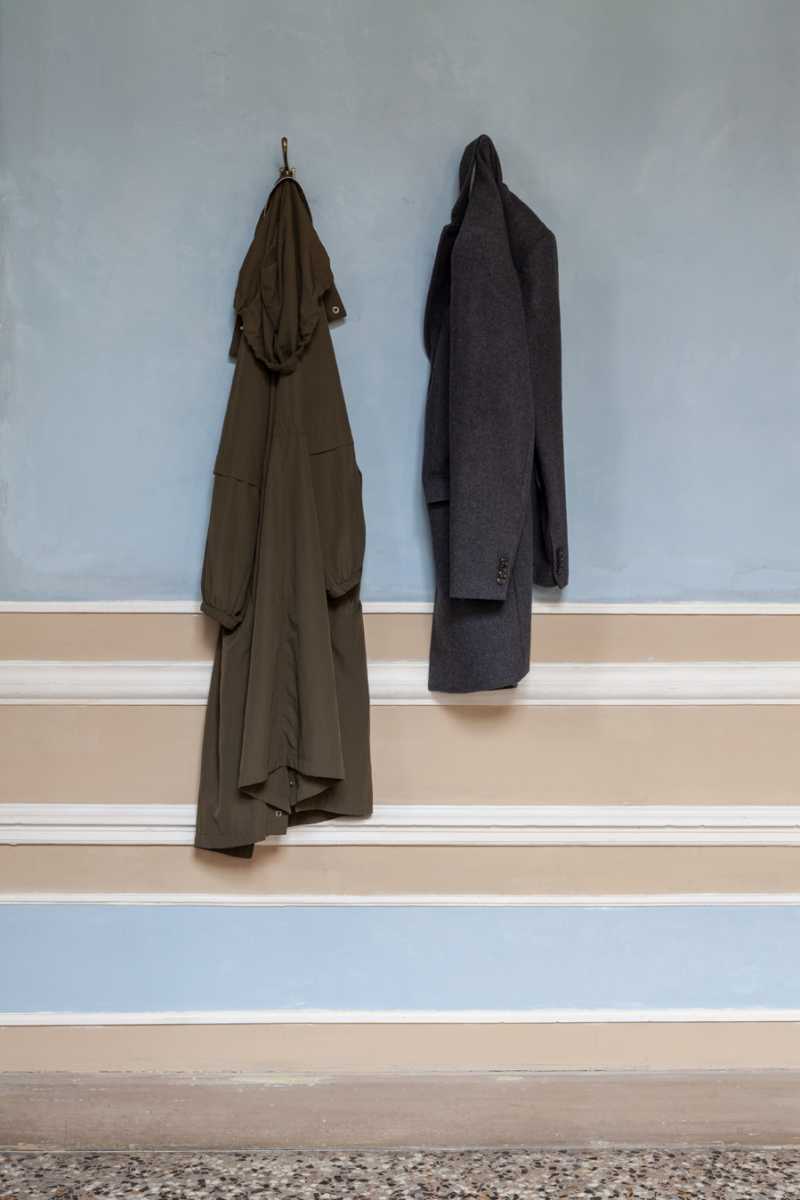
Contract: a conversation piece, 2018
Two coats by gallery owner Giorgio Galotti and artist Renata De Bonis, two wireless speakers that play two audio tracks of their entire e-mail exchange up to the opening day of the show, read and recorded by two actors.
This work was part of the DAMA Art Fair, which took place at the Palazzo Saluzzo, in Turin, Italy, in 2018, in which Renata De Bonis was the winner of the A.R.M. DAMA Prize.
Contract: the conversation piece assumes the Vestibolo room, previously used as the Palazzo Saluzzo’s dressing room, as a starting point to generate a contemplation on professional and social relationships, specifically, in the context of DAMA, as well as in a broader sense, to think about social mediation through work that is more present than ever in our fast-paced contemporary life.
Considering the previous use of the room, and the fact that the space is also the entrance to DAMA, the work is composed of two coats hanging on the wall side by side, mimicking the act of entering a place and hanging jackets. In the pocket of each coat, a wireless Bluetooth speaker was placed (invisible to the public). Each speaker plays a dialogue, recorded by two professional actors, who play the roles of artist and gallery owner, where all the real emails that were exchanged between them are read and made public.

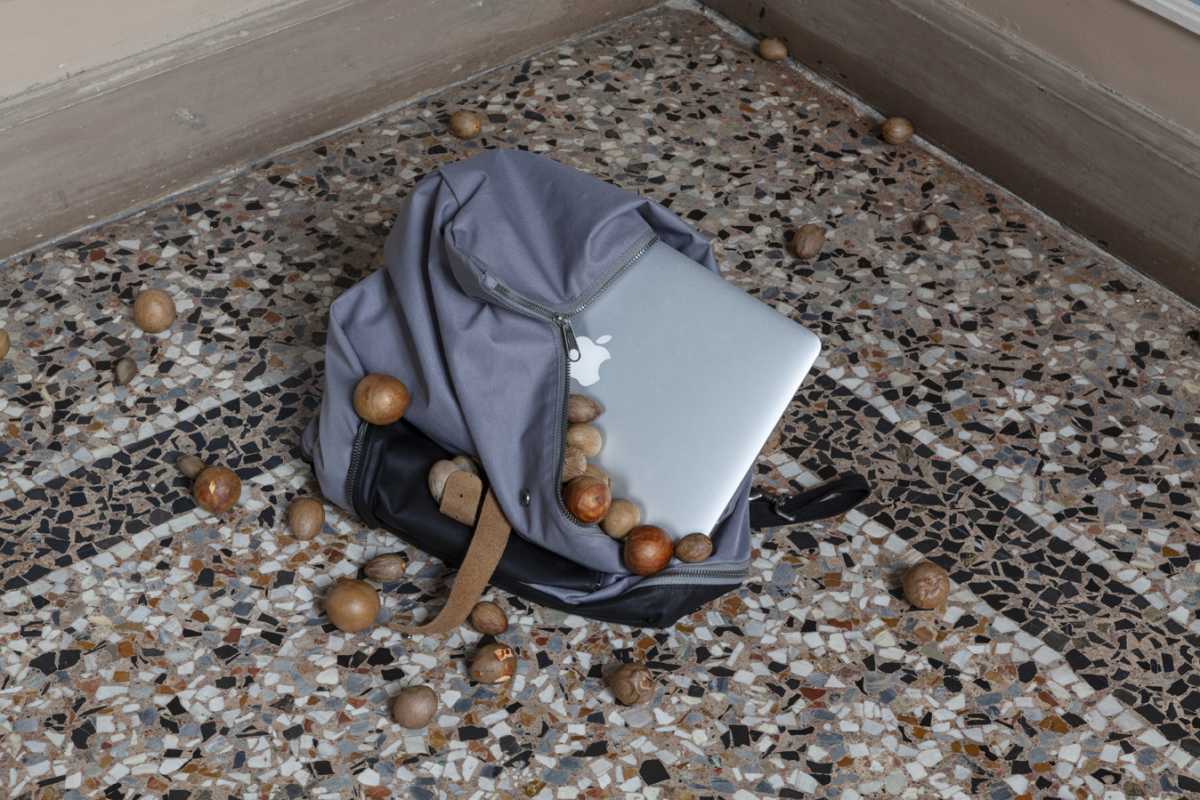
A stone inside a seed, 2018
This work was part of the DAMA Art Fair, which took place at the Palazzo Saluzzo, in Turin, Italy, in 2018, in which Renata De Bonis was the winner of the A.R.M. DAMA Prize.
The stone inside a seed juxtaposes pens, pencils and a laptop used by the project’s curator, Domenico De Chirico, and avocado seeds scattered on the floor of the Vestibolo room in Palazzo Saluzzo. The provenance of such objects indicates the potential for validation that is present in the act of writing, editing, programming and narrating, pointing to the context of DAMA and the specificity of the curatorship, but also expanding the scope of this action to other spheres, finally going back to fabrication of history through writing from a “central” point. Avocado seeds refer to the fact that the Spanish conquerors used avocado seeds (popularly known as stones) to produce a blood-red liquid used as ink to sign official colonial documents (documents that still preserve their information after centuries).
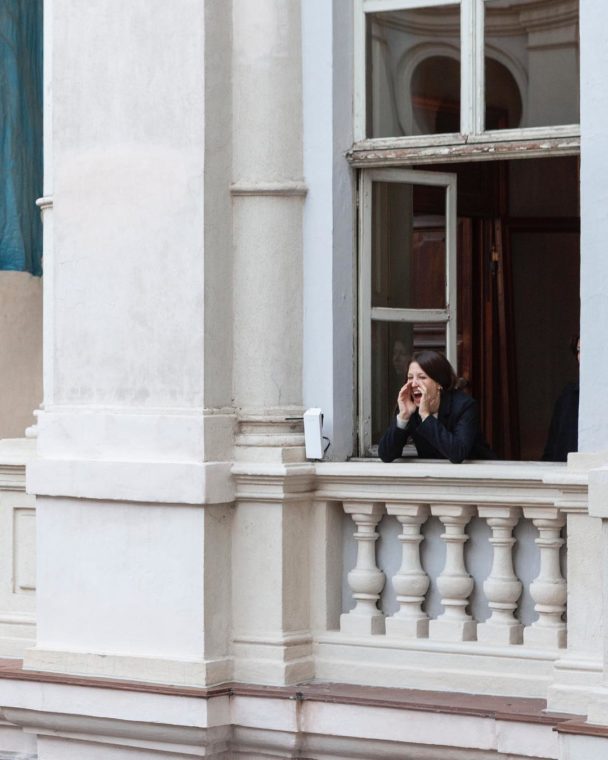
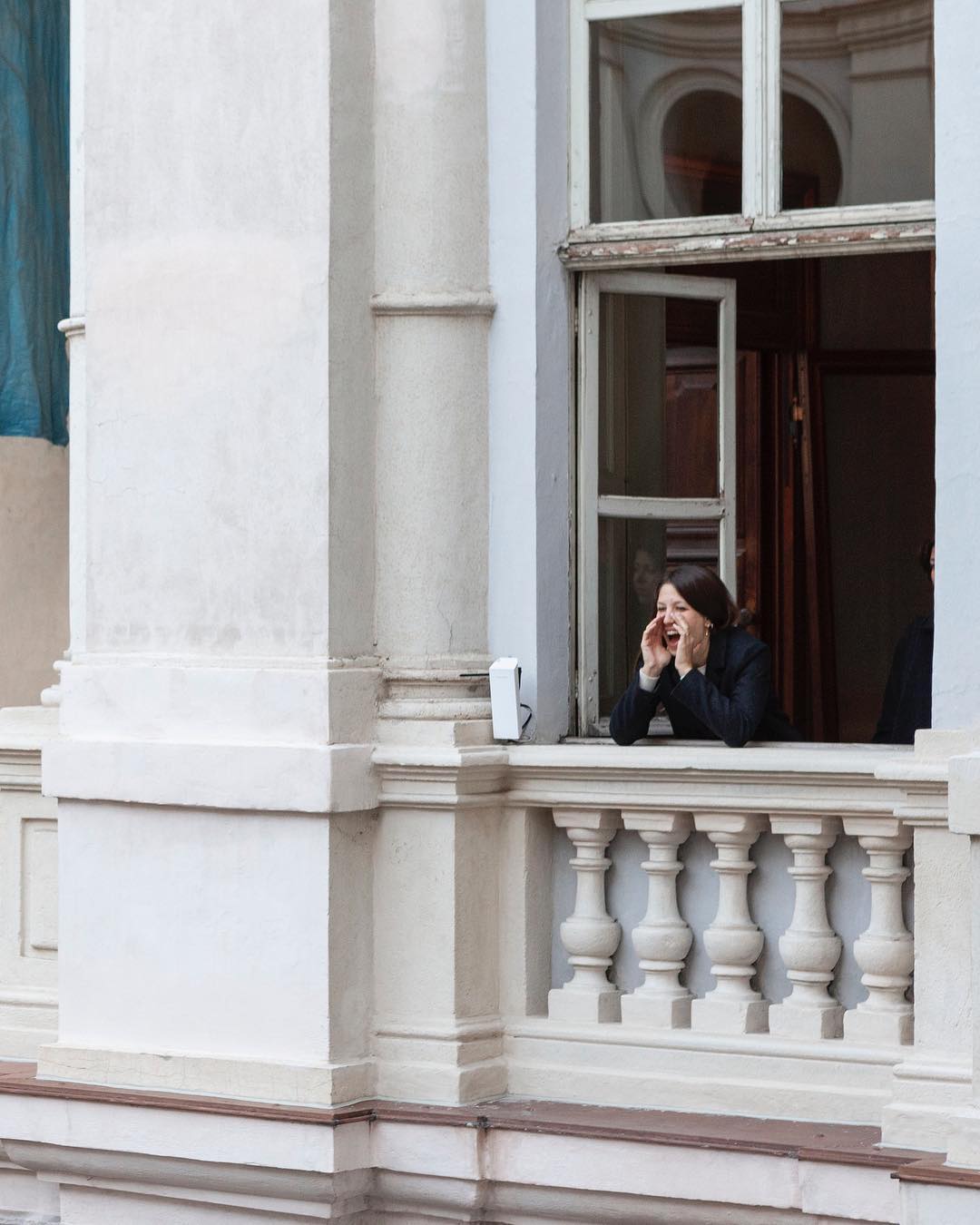
Defenestração, 2018
This performance was part of the DAMA Art Fair, which took place at the Palazzo Saluzzo, in Turin, Italy, in 2018, in which Renata De Bonis was the winner of the A.R.M. DAMA Prize.
Defenestração [Defenestration] is a reconsideration and updating of the concept of defenestration, which means the action of throwing someone out of the window, as well as the process of depriving someone of a position of power or authority. The term, which comes from the Latin de (outside or far from) and fenestra (window or opening), was created at the time of related political conflicts, where adversaries were forcibly removed and literally expelled from their palaces and hierarchical positions, shattering real windows, as well as the bones of those who were once in power. Since its origins, such imagery migrated from political conflict to the realm of pop culture, being endlessly re-enacted in cinema and literature, in addition to its corporate use as a metaphor for the removal of professionals from positions of power within companies.
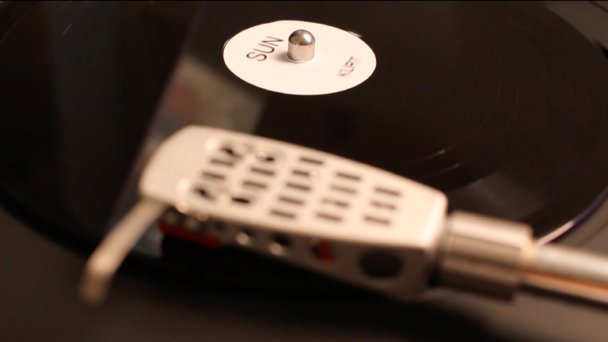

Sun/Moon, 2017
Pressed vinyl sound piece
The Sun/Moon sound piece is composed by the dissection and conjunction of all the moments in which the composer, musician and activist Neil Young uttered the words “Sol” and “Moon” throughout his discography (until 2017).
The countless annunciations point to the ever-present symbols of the Sun and Moon, and of nature itself, in our daily lives, whether through spiritual symbology or through pop music. Furthermore, each side of the register, and the register player mechanism (with its needle and weight), alludes to the cosmic orbit and its gravitational forces, throwing an “astroballad” on each of us we are all forced to dance and contemplate.
Sun: vimeo.com/269515581
Moon: vimeo.com/269516033
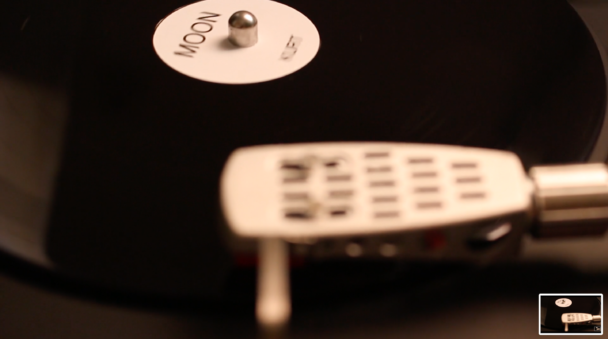
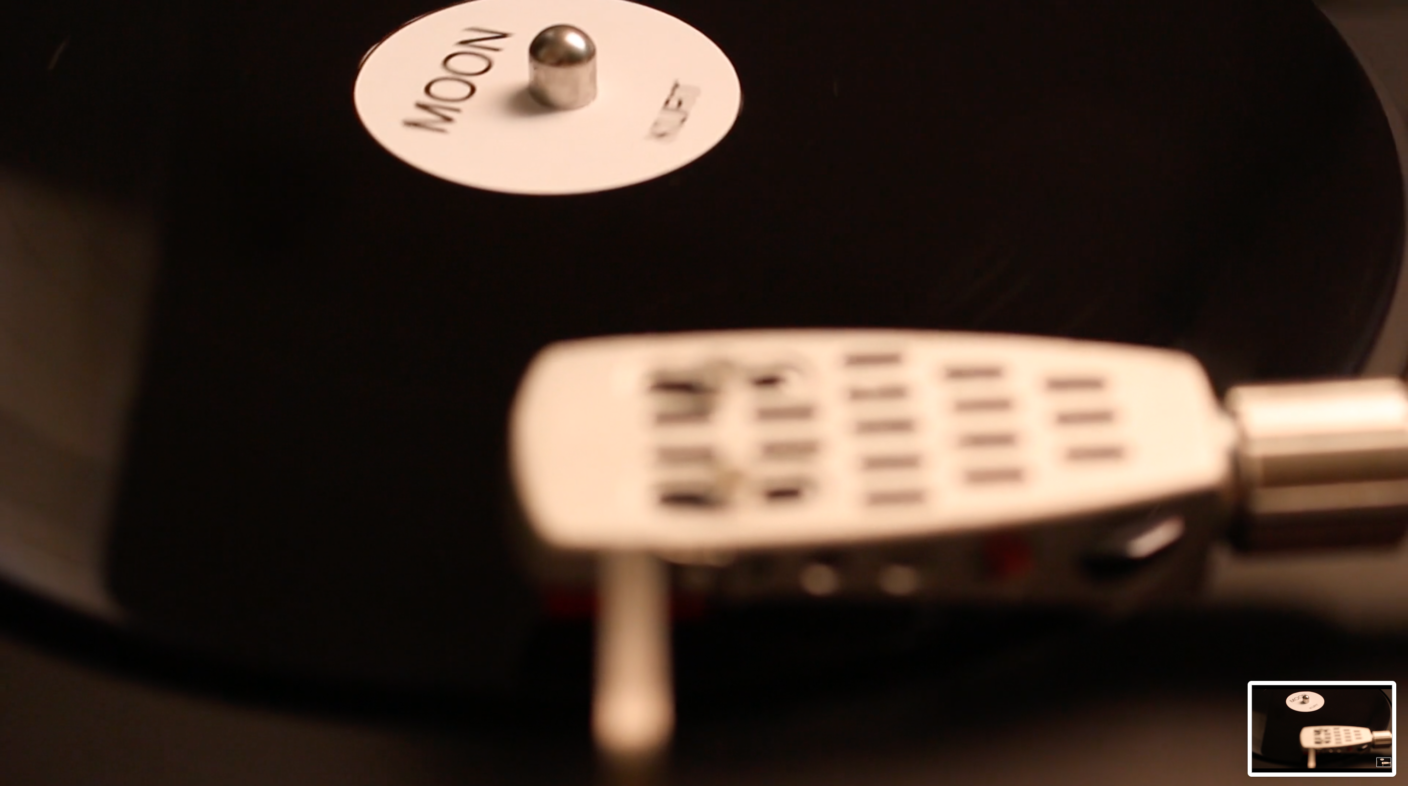
Sun/Moon, 2017
Pressed vinyl sound piece
The Sun/Moon sound piece is composed by the dissection and conjunction of all the moments in which the composer, musician and activist Neil Young uttered the words “Sol” and “Moon” throughout his discography (until 2017).
The countless annunciations point to the ever-present symbols of the Sun and Moon, and of nature itself, in our daily lives, whether through spiritual symbology or through pop music. Furthermore, each side of the register, and the register player mechanism (with its needle and weight), alludes to the cosmic orbit and its gravitational forces, throwing an “astroballad” on each of us we are all forced to dance and contemplate.
Sun: vimeo.com/269515581
Moon: vimeo.com/269516033
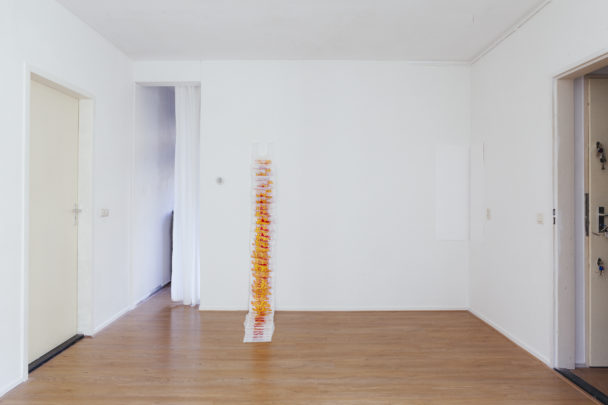
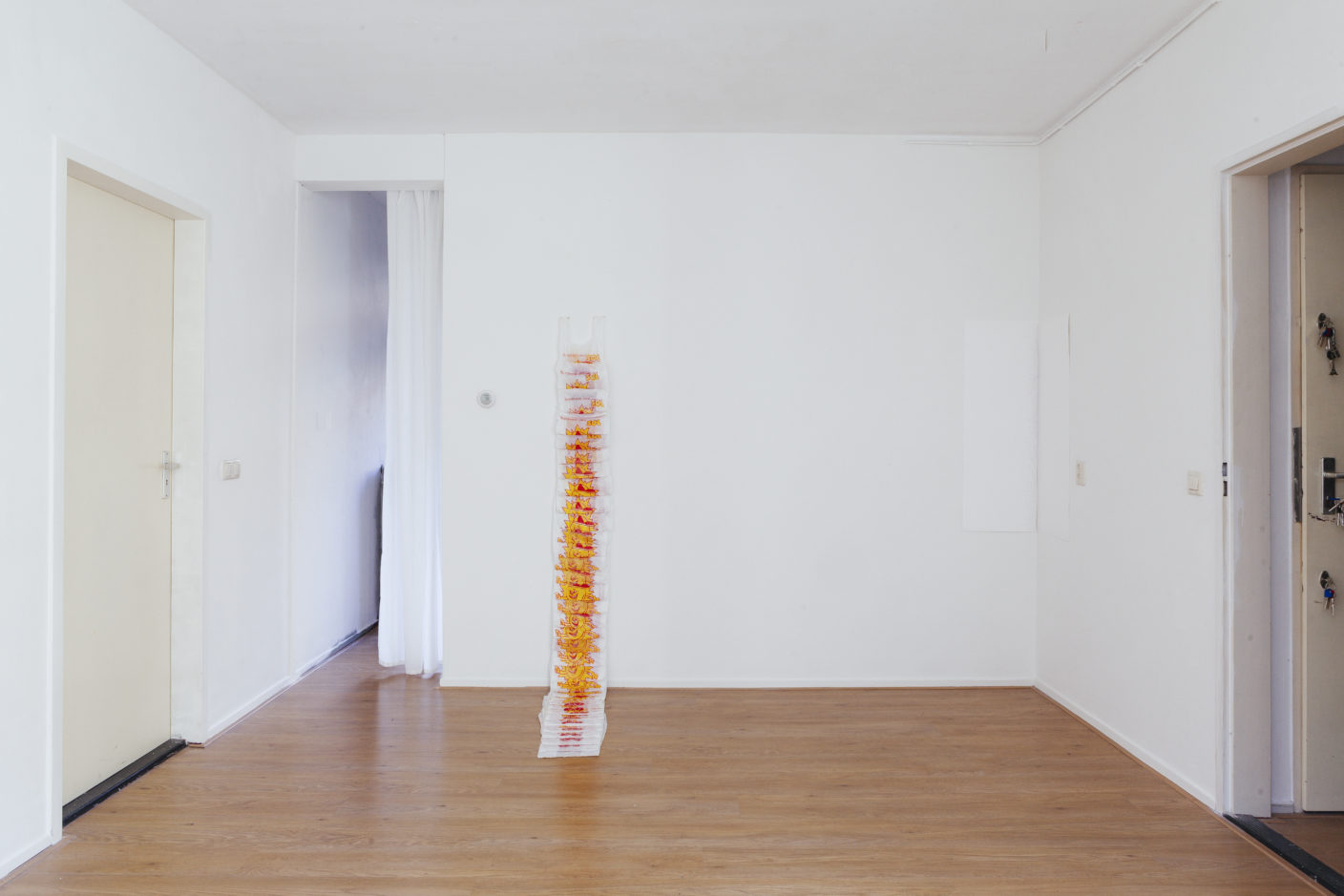
Setting Sun, 2017
Work exhibited in the project space Tilde Ams, in Amsterdam, Netherlands, 2017.


Setting Sun, 2017
Work exhibited in the project space Tilde Ams, in Amsterdam, Netherlands, 2017.
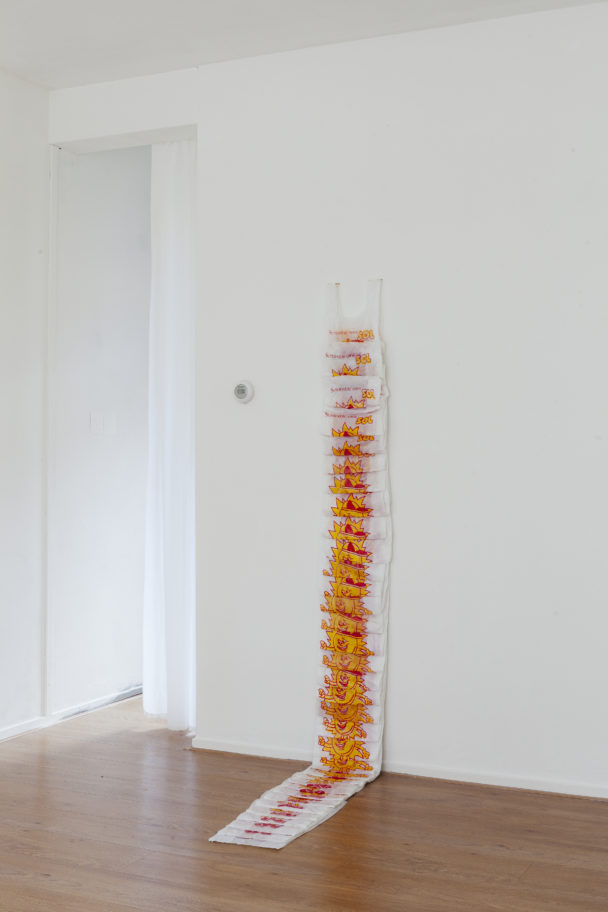
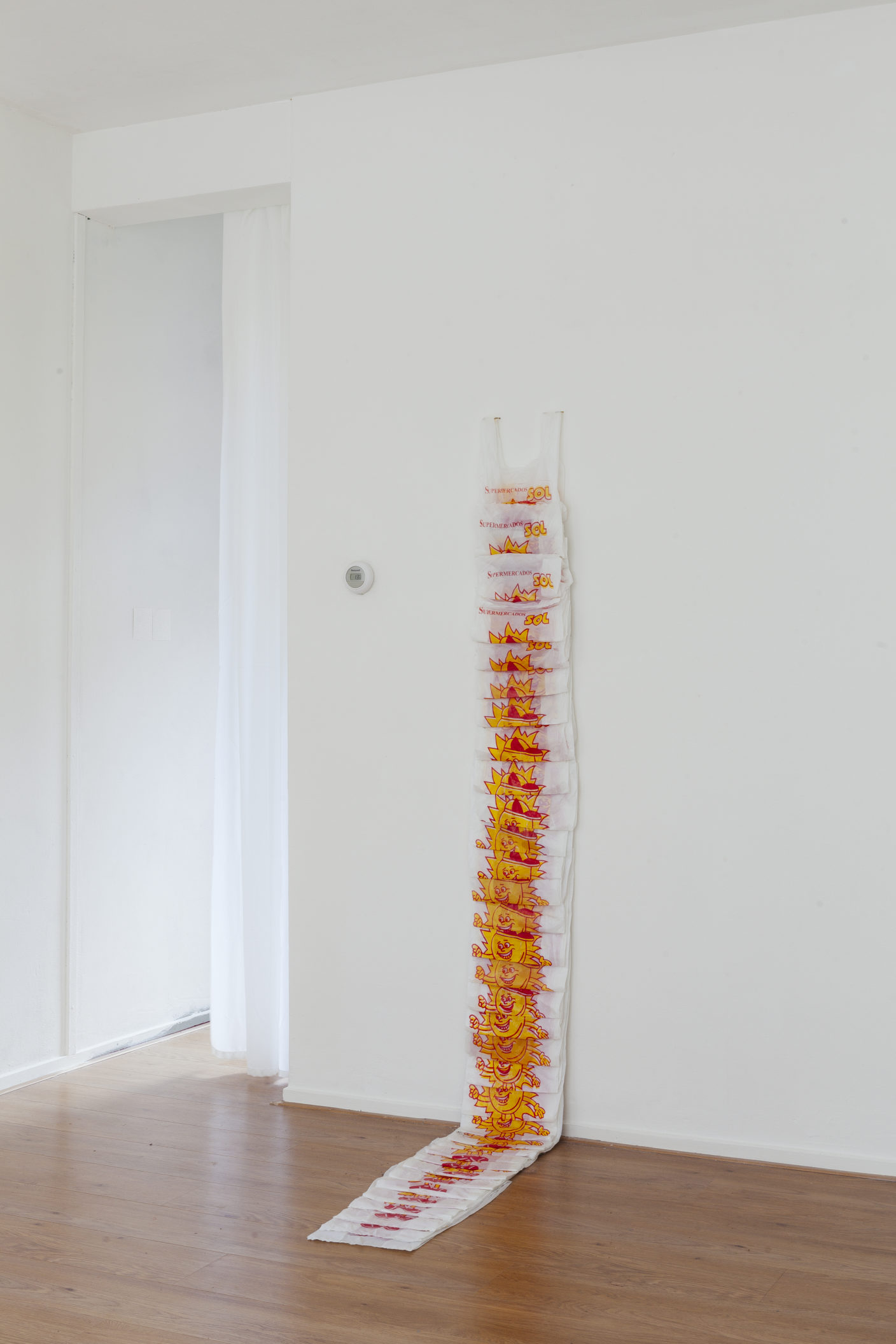
Setting Sun, 2017
Work exhibited in the project space Tilde Ams, in Amsterdam, Netherlands, 2017.
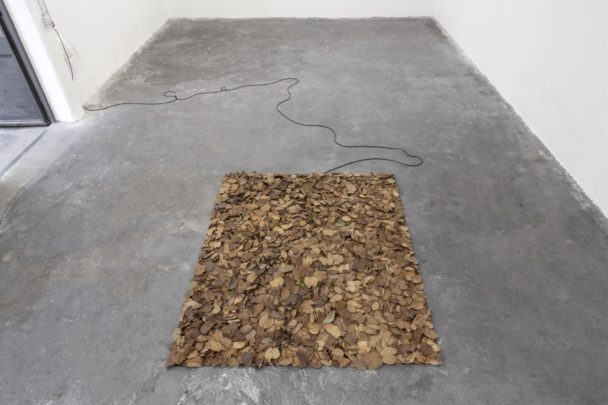

O estranho (24°C), 2017
This work was part of the exhibition Aurora, at Giorgio Galotti Gallery, Turin, Italy, 2017.
O estranho (24°C) [The strange (24°C)] is the result of a natural process that alludes to the artificial heat transfer mechanism. A selection of dried leaves, collected a few weeks before her trip to Turin, in front of her home in São Paulo — where it was autumn — were loaded onto the plane and placed inside the gallery. Shown as an unpretentious concentration of fallen leaves, the crumbling mass shelters beneath it a working heated domestic rug, precisely tuned to reproduce the temperature and atmosphere of São Paulo on the exact same day the leaves were collected. The work addresses the artist’s affection for her own environment through an effort of relocation, where any element, even if artificial, can stimulate the acclimatization instinct, composing a familiar environment capable of reactivating native sensations from a distant place.


View of the exhibition Aurora, at Giorgio Galotti Gallery, Turin, Italy, 2017.
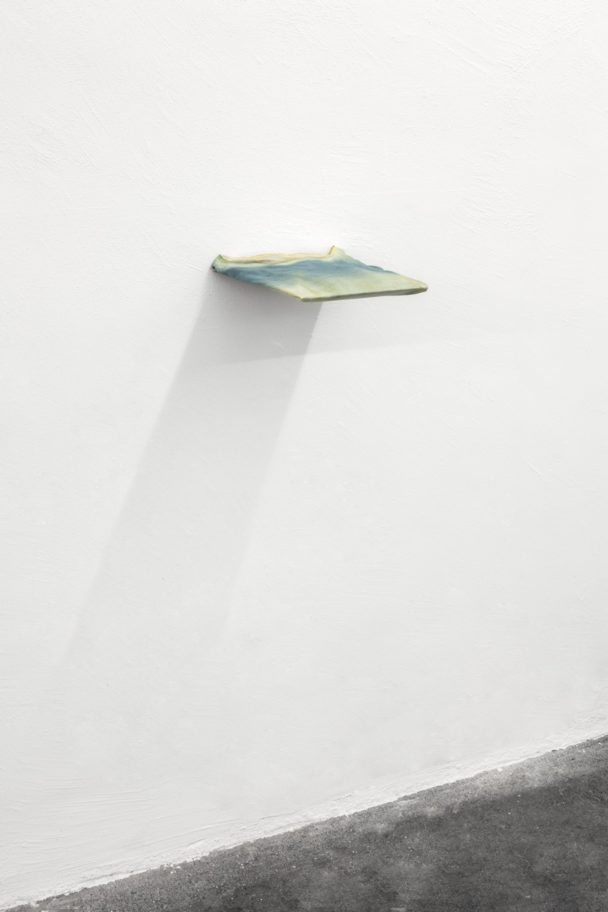

6h35 / 20h04 (16 de abril de 2017), 2017
This work was part of the exhibition Aurora, at Giorgio Galotti Gallery, Turin, Italy, 2017.
The work has its origins in a chromatic and daily interpretation of dawn and dusk. During her residency in Turin, Renata wore two distinct white shirts at two different times of the day: one at dawn and the other at dusk. A photosensitive substance — historically used to create cyanotypes — was applied to shirts, retaining the luminosity of sunlight that appears and fades, while simultaneously recording the shapes and elements that occur between the light source and the support, consequently measuring the daily development of a subject through light intensity. The two shirts, colored by the sun, were oriented at two opposite poles of the gallery space: one to the east and the other to the west, to recreate an autonomous life cycle of sunrise and sunset, in an aseptic environment.
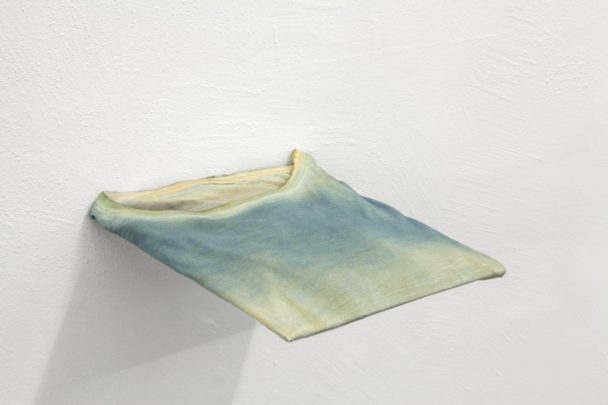

6h35 / 20h04 (16 de abril de 2017), 2017
This work was part of the exhibition Aurora, at Giorgio Galotti Gallery, Turin, Italy, 2017.
The work has its origins in a chromatic and daily interpretation of dawn and dusk. During her residency in Turin, Renata wore two distinct white shirts at two different times of the day: one at dawn and the other at dusk. A photosensitive substance — historically used to create cyanotypes — was applied to shirts, retaining the luminosity of sunlight that appears and fades, while simultaneously recording the shapes and elements that occur between the light source and the support, consequently measuring the daily development of a subject through light intensity. The two shirts, colored by the sun, were oriented at two opposite poles of the gallery space: one to the east and the other to the west, to recreate an autonomous life cycle of sunrise and sunset, in an aseptic environment.
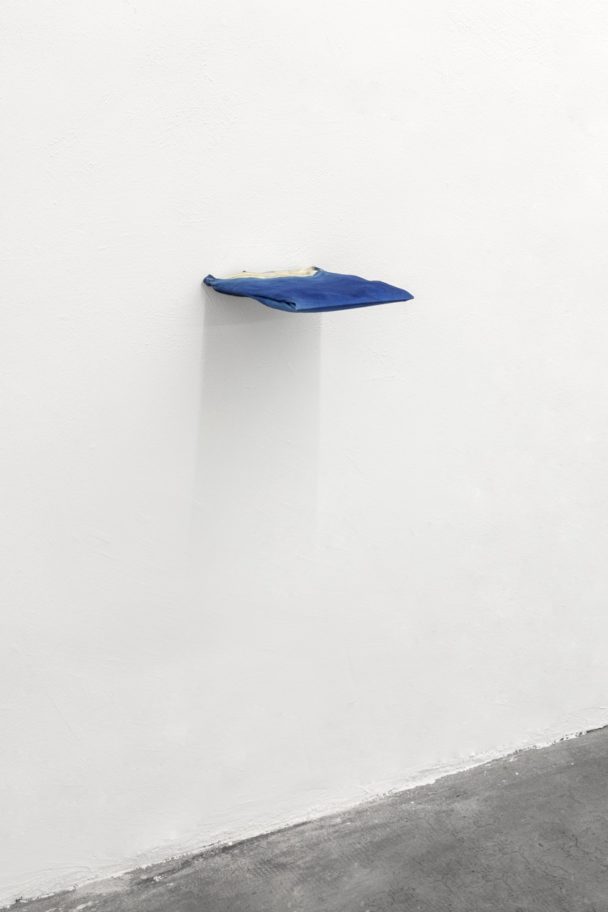

6h35 / 20h04 (16 de abril de 2017), 2017
This work was part of the exhibition Aurora, at Giorgio Galotti Gallery, Turin, Italy, 2017.
The work has its origins in a chromatic and daily interpretation of dawn and dusk. During her residency in Turin, Renata wore two distinct white shirts at two different times of the day: one at dawn and the other at dusk. A photosensitive substance — historically used to create cyanotypes — was applied to shirts, retaining the luminosity of sunlight that appears and fades, while simultaneously recording the shapes and elements that occur between the light source and the support, consequently measuring the daily development of a subject through light intensity. The two shirts, colored by the sun, were oriented at two opposite poles of the gallery space: one to the east and the other to the west, to recreate an autonomous life cycle of sunrise and sunset, in an aseptic environment.
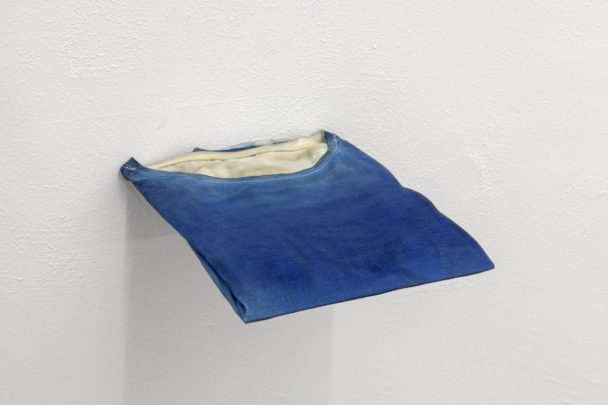

6h35 / 20h04 (16 de abril de 2017), 2017
This work was part of the exhibition Aurora, at Giorgio Galotti Gallery, Turin, Italy, 2017.
The work has its origins in a chromatic and daily interpretation of dawn and dusk. During her residency in Turin, Renata wore two distinct white shirts at two different times of the day: one at dawn and the other at dusk. A photosensitive substance — historically used to create cyanotypes — was applied to shirts, retaining the luminosity of sunlight that appears and fades, while simultaneously recording the shapes and elements that occur between the light source and the support, consequently measuring the daily development of a subject through light intensity. The two shirts, colored by the sun, were oriented at two opposite poles of the gallery space: one to the east and the other to the west, to recreate an autonomous life cycle of sunrise and sunset, in an aseptic environment.


Redoma (2,08 mt)
This work was part of the exhibition Aurora, at Giorgio Galotti Gallery, Turin, Italy, 2017.
The work Redoma (2.08 mt), the Portuguese word for “dome”, is composed of simulating and stopping a banal action, that of trapping a mosquito inside a glass on the wall to move and release it. The mosquito was found dead inside an exhibition space, an art exhibition being its last experience. The position of the cup on the wall, magically held at 2.08m high, is established in relation to the artist’s dimensions and the maximum height she can reach, demonstrating the triviality of the situation. The work also makes reference to the Vanitas theme, emphasizing the cycles of life and death within an everyday space and time.


Redoma (2,08 mt)
This work was part of the exhibition Aurora, at Giorgio Galotti Gallery, Turin, Italy, 2017.
The work Redoma (2.08 mt), the Portuguese word for “dome”, is composed of simulating and stopping a banal action, that of trapping a mosquito inside a glass on the wall to move and release it. The mosquito was found dead inside an exhibition space, an art exhibition being its last experience. The position of the cup on the wall, magically held at 2.08m high, is established in relation to the artist’s dimensions and the maximum height she can reach, demonstrating the triviality of the situation. The work also makes reference to the Vanitas theme, emphasizing the cycles of life and death within an everyday space and time.
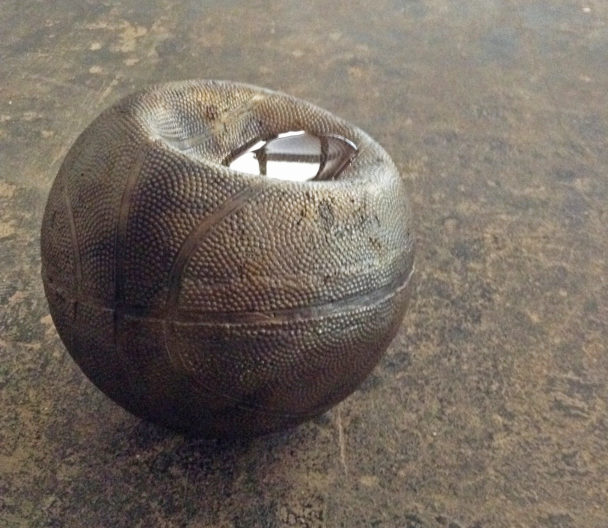
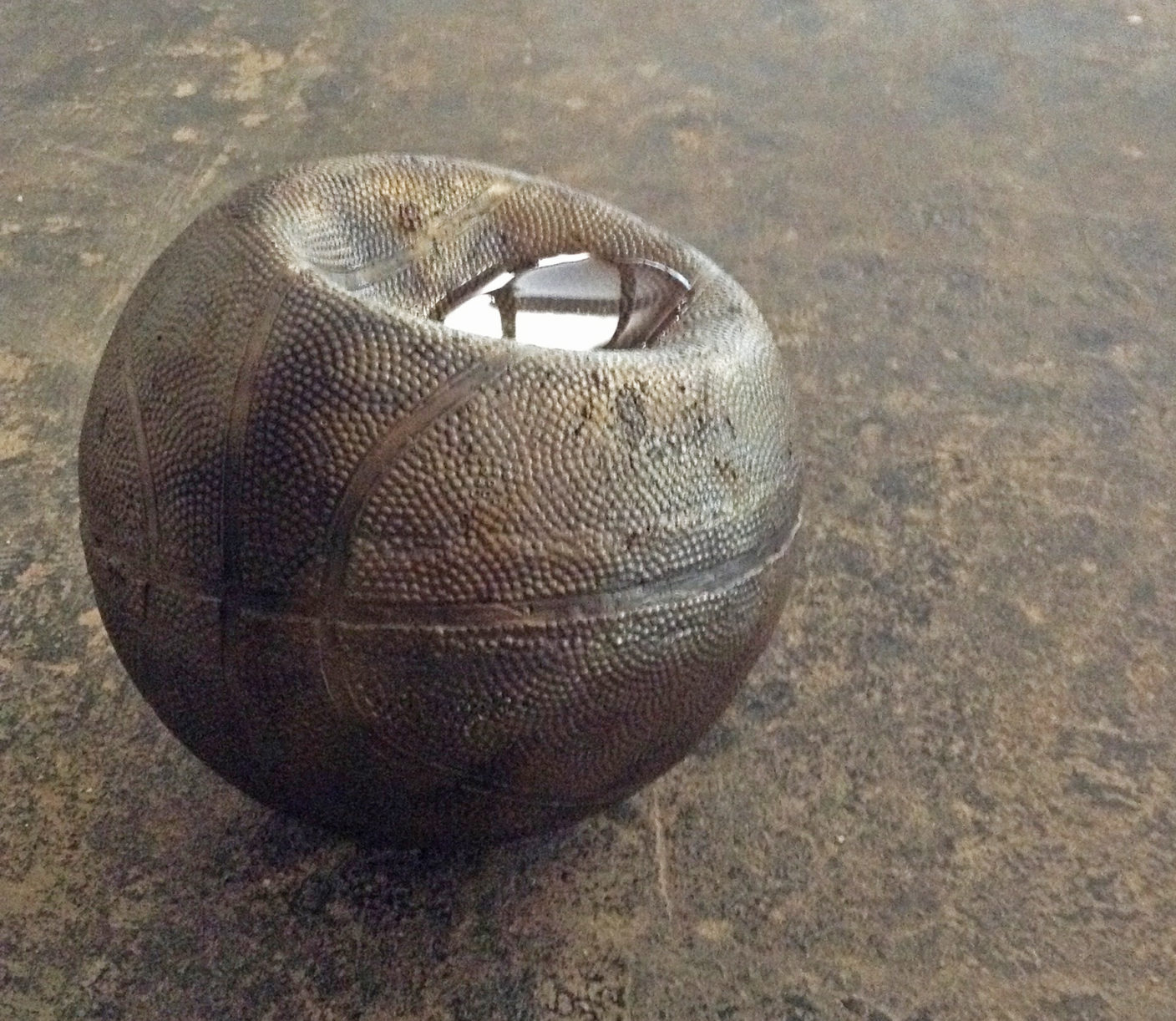
Puddle, 2016
Bronze and rainwater
Puddle appropriates an everyday and banal situation, that of the encounter of a passerby with a deflated basketball that sadly finds itself in a public sports court and without a roof. This scene is reinforced by the presence of a puddle of rainwater on the irregular surface of the sphere. The juxtaposition of materials, the withered bronze basketball and the resting rainwater act as a reflector for the brevity of our efforts, where our actions, even when monumentalized by symbolic gestures like a bronze statue, are equal , or less present, than the ephemeral manifestations of nature.

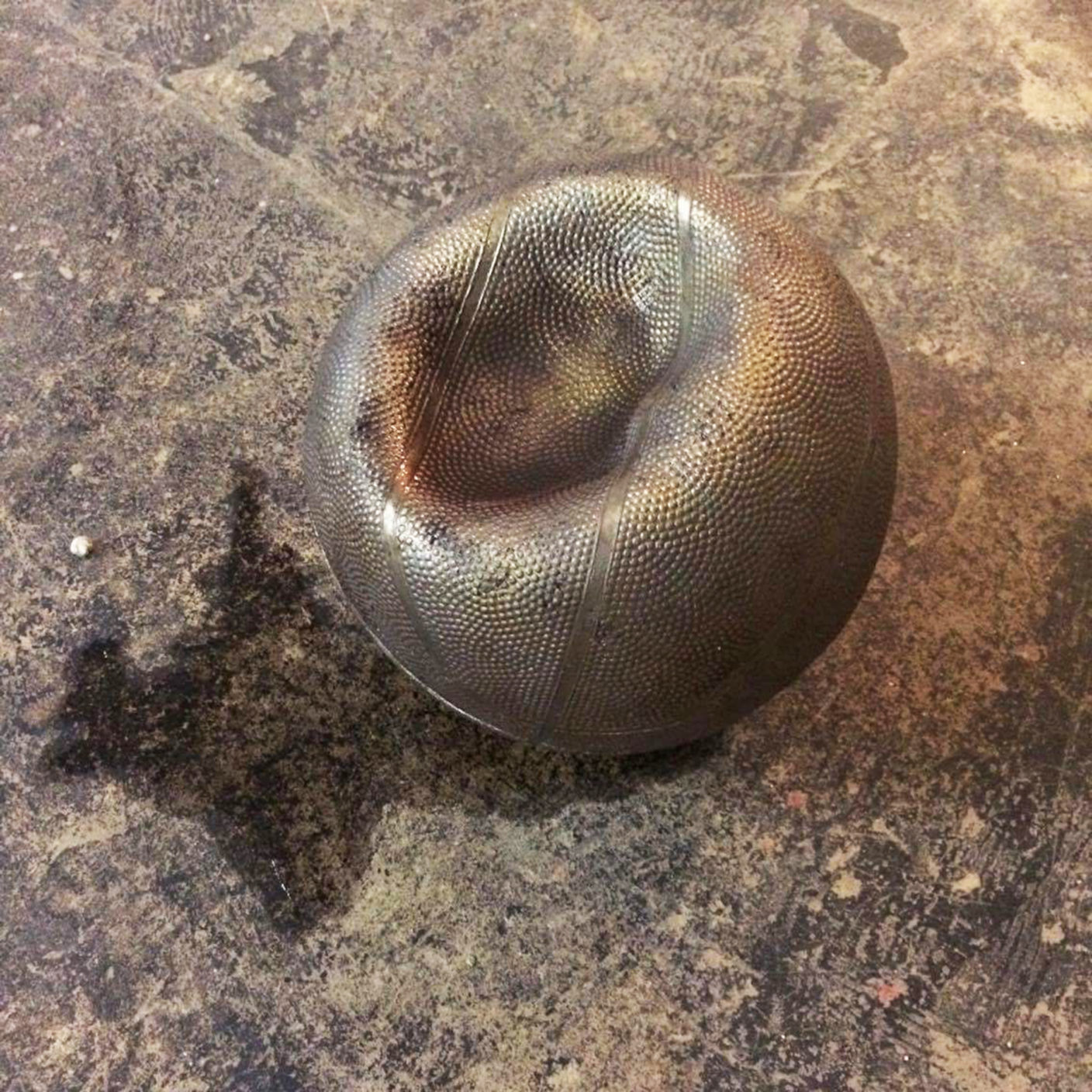
Puddle, 2016
Bronze and rainwater
Puddle appropriates an everyday and banal situation, that of the encounter of a passerby with a deflated basketball that sadly finds itself in a public sports court and without a roof. This scene is reinforced by the presence of a puddle of rainwater on the irregular surface of the sphere. The juxtaposition of materials, the withered bronze basketball and the resting rainwater act as a reflector for the brevity of our efforts, where our actions, even when monumentalized by symbolic gestures like a bronze statue, are equal , or less present, than the ephemeral manifestations of nature.


Puddle, 2016
Bronze and rainwater
Puddle appropriates an everyday and banal situation, that of the encounter of a passerby with a deflated basketball that sadly finds itself in a public sports court and without a roof. This scene is reinforced by the presence of a puddle of rainwater on the irregular surface of the sphere. The juxtaposition of materials, the withered bronze basketball and the resting rainwater act as a reflector for the brevity of our efforts, where our actions, even when monumentalized by symbolic gestures like a bronze statue, are equal , or less present, than the ephemeral manifestations of nature.
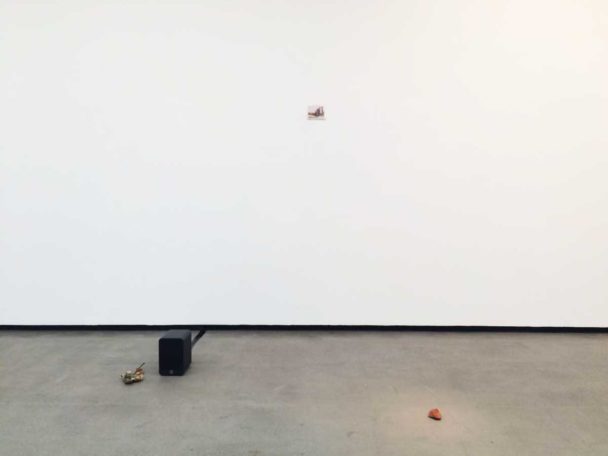
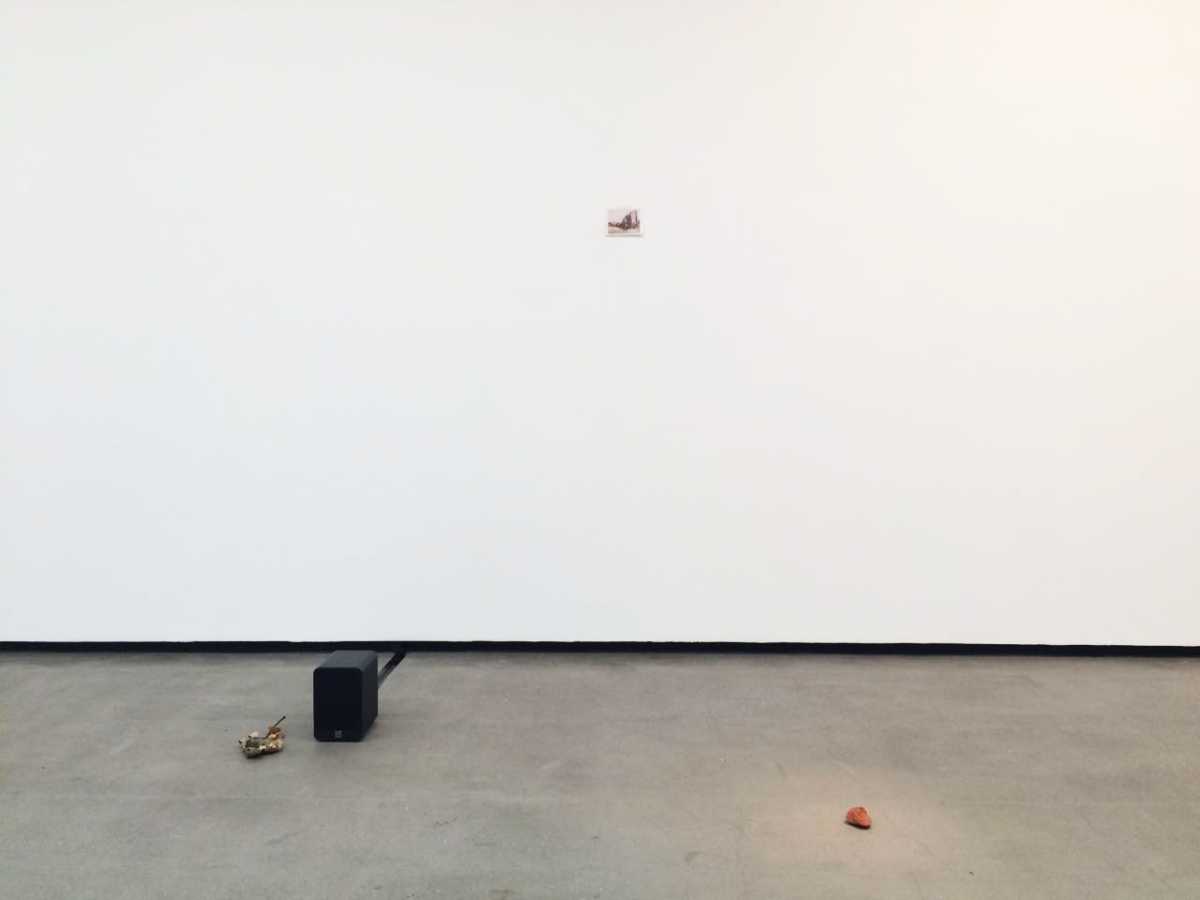
Anotações a partir de Caspar David Friedrich, 2016
View of the work Sounds after Caspar David Friedrich, which was part of the exhibition Quadro, Desquadro, Requadro, second edition of Arte Atual Festival, at Instituto Tomie Ohtake, 2016.
During a residency Renata held in Germany, the artist mapped, located and visited several of the scenarios in which Caspar David Friedrich had made his paintings in order to come across these landscapes and all the imagery that was built around them.
Renata captured the sound of these environments, precisely their most elusive and evanescent dimension. The recorded sound was edited into tracks that correspond to the specific locations of Friedrich’s works. Loudspeakers scattered throughout the space played one track at a time, updating, with about a century and a half away, the acoustic ambience of that place.
[excerpt from the text written on the occasion of the exhibition]
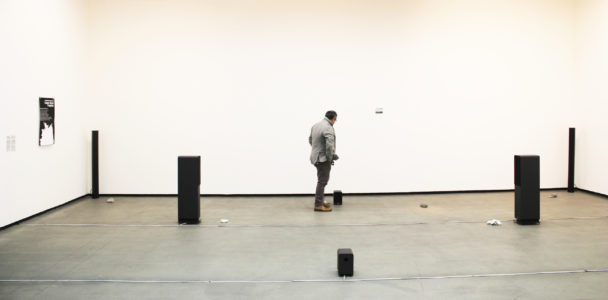
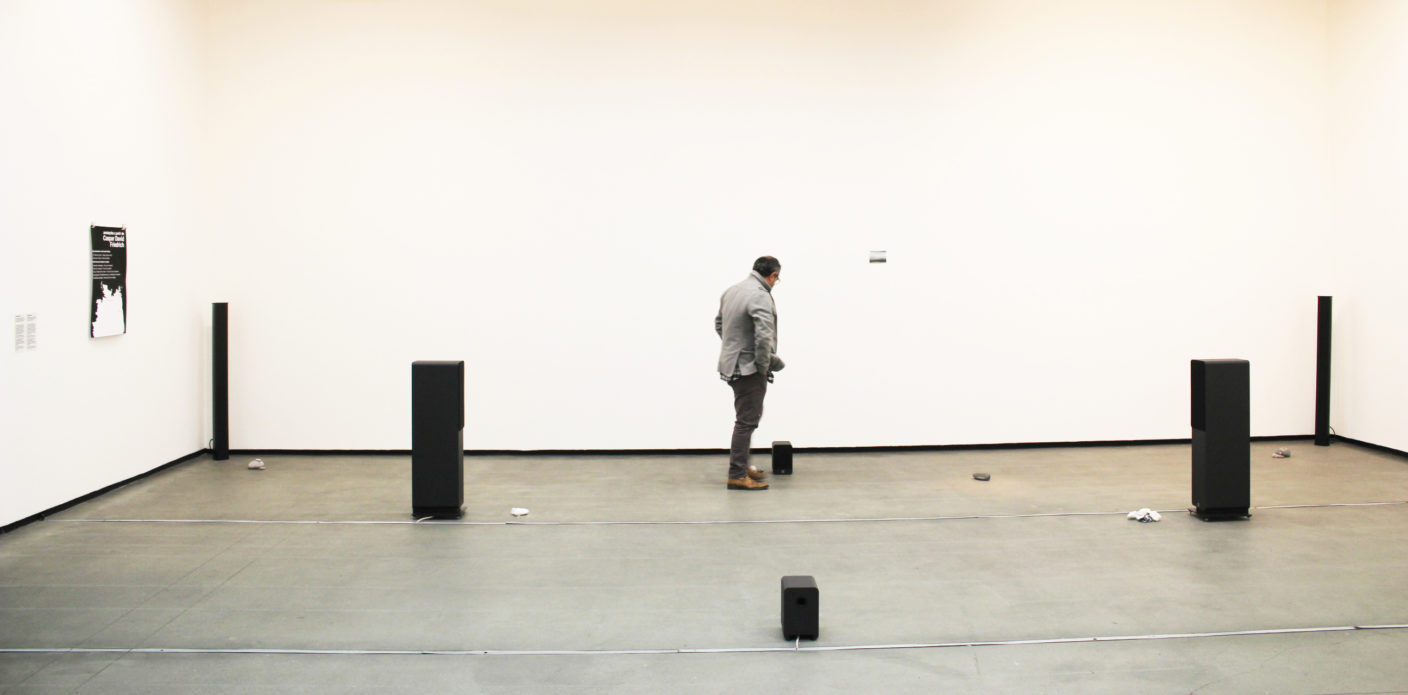
Anotações a partir de Caspar David Friedrich, 2016
View of the work Sounds after Caspar David Friedrich, which was part of the exhibition Quadro, Desquadro, Requadro, second edition of Arte Atual Festival, at Instituto Tomie Ohtake, 2016.
During a residency Renata held in Germany, the artist mapped, located and visited several of the scenarios in which Caspar David Friedrich had made his paintings in order to come across these landscapes and all the imagery that was built around them.
Renata captured the sound of these environments, precisely their most elusive and evanescent dimension. The recorded sound was edited into tracks that correspond to the specific locations of Friedrich’s works. Loudspeakers scattered throughout the space played one track at a time, updating, with about a century and a half away, the acoustic ambience of that place.
[excerpt from the text written on the occasion of the exhibition]

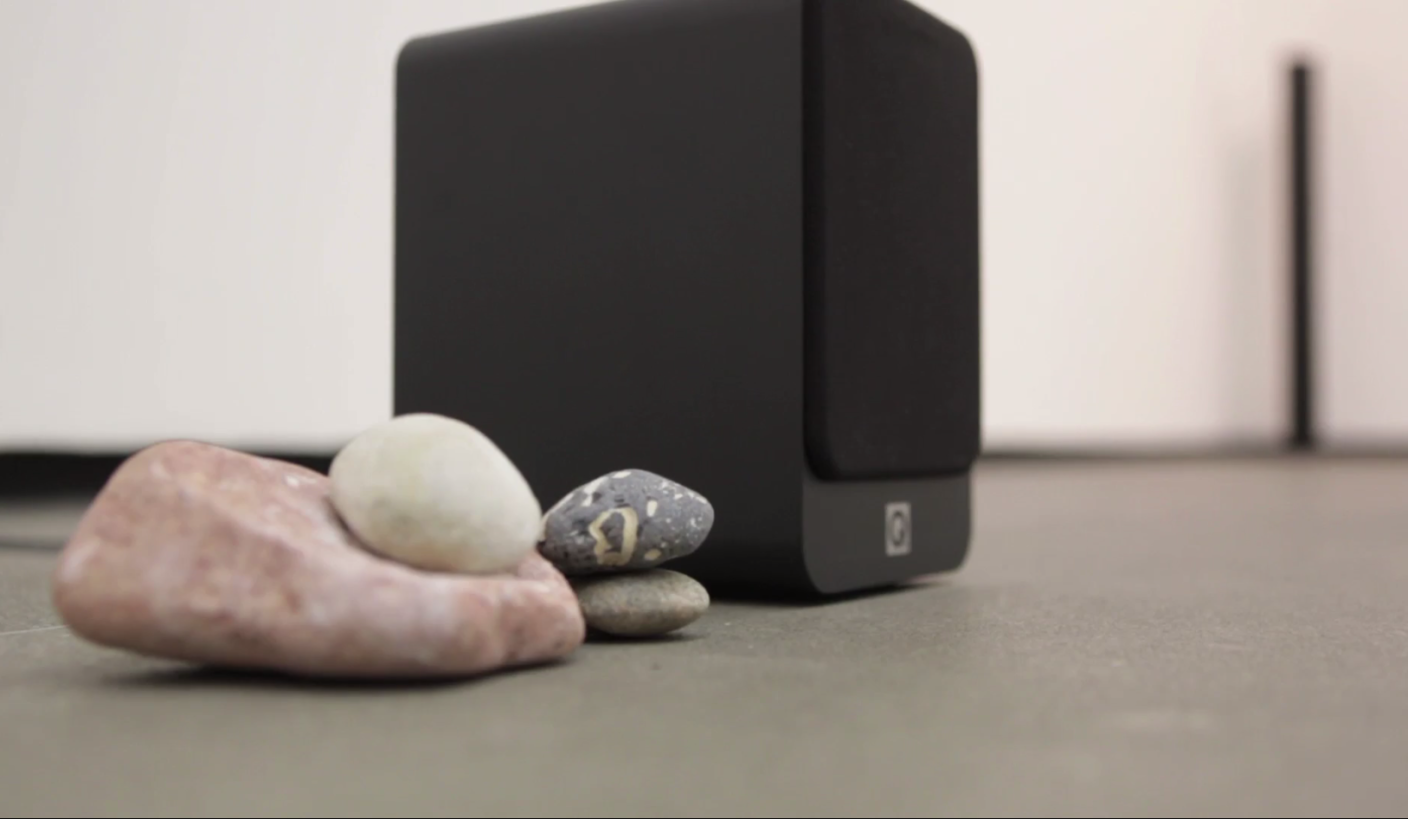
Anotações a partir de Caspar David Friedrich, 2016
Detail of the work Sounds after Caspar David Friedrich, which was part of the exhibition Quadro, Desquadro, Requadro, second edition of Arte Atual Festival, at Instituto Tomie Ohtake, 2016.
During a residency Renata held in Germany, the artist mapped, located and visited several of the scenarios in which Caspar David Friedrich had made his paintings in order to come across these landscapes and all the imagery that was built around them.
Renata captured the sound of these environments, precisely their most elusive and evanescent dimension. The recorded sound was edited into tracks that correspond to the specific locations of Friedrich’s works. Loudspeakers scattered throughout the space played one track at a time, updating, with about a century and a half away, the acoustic ambience of that place.
[excerpt from the text written on the occasion of the exhibition]
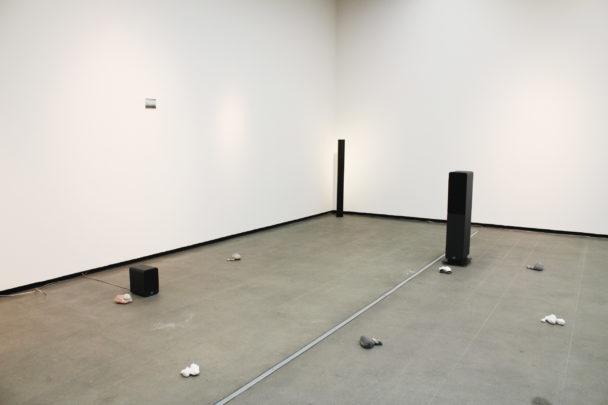
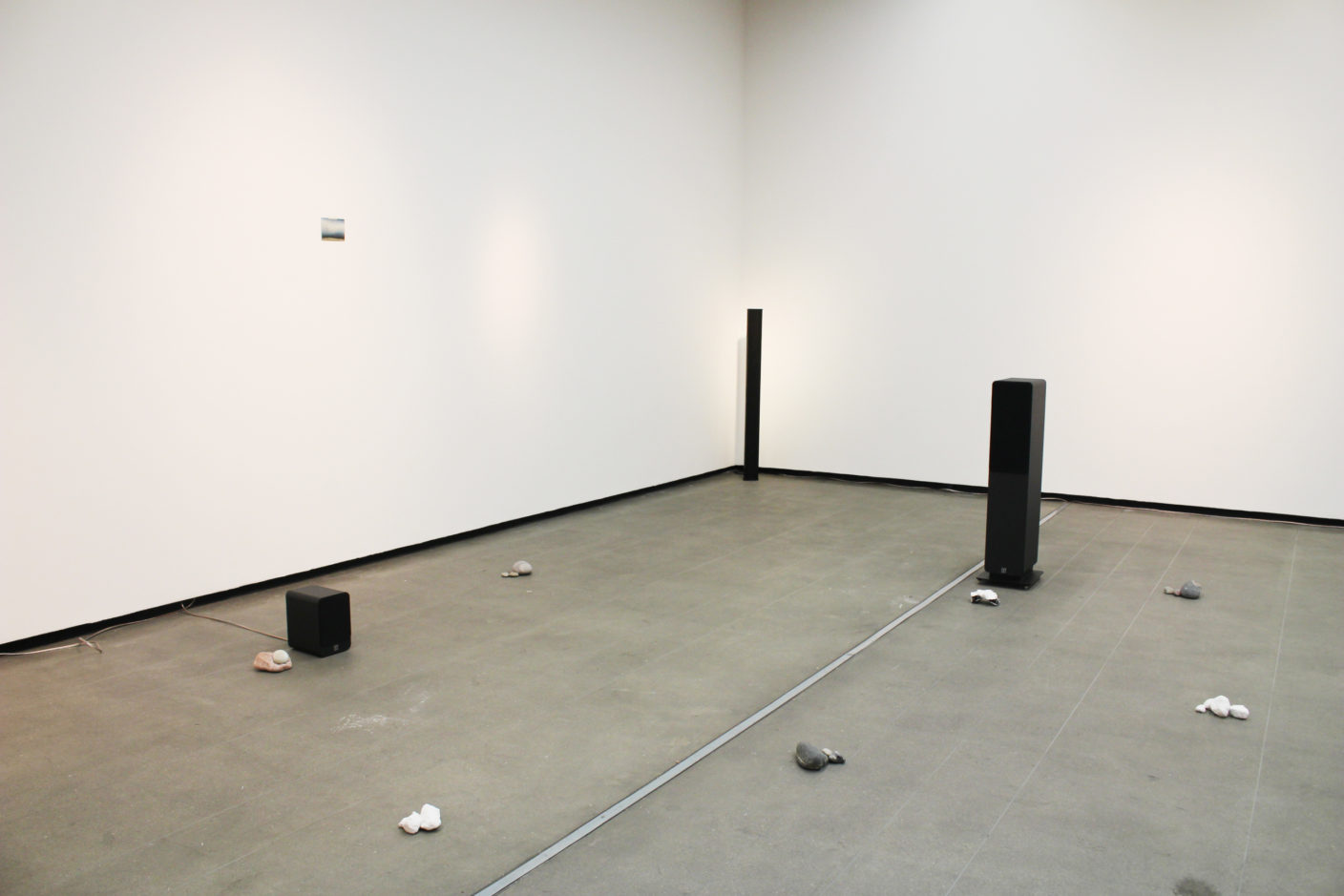
Anotações a partir de Caspar David Friedrich, 2016
View of the work Sounds after Caspar David Friedrich, which was part of the exhibition Quadro, Desquadro, Requadro, second edition of Arte Atual Festival, at Instituto Tomie Ohtake, 2016.
During a residency Renata held in Germany, the artist mapped, located and visited several of the scenarios in which Caspar David Friedrich had made his paintings in order to come across these landscapes and all the imagery that was built around them.
Renata captured the sound of these environments, precisely their most elusive and evanescent dimension. The recorded sound was edited into tracks that correspond to the specific locations of Friedrich’s works. Loudspeakers scattered throughout the space played one track at a time, updating, with about a century and a half away, the acoustic ambience of that place.
[excerpt from the text written on the occasion of the exhibition]
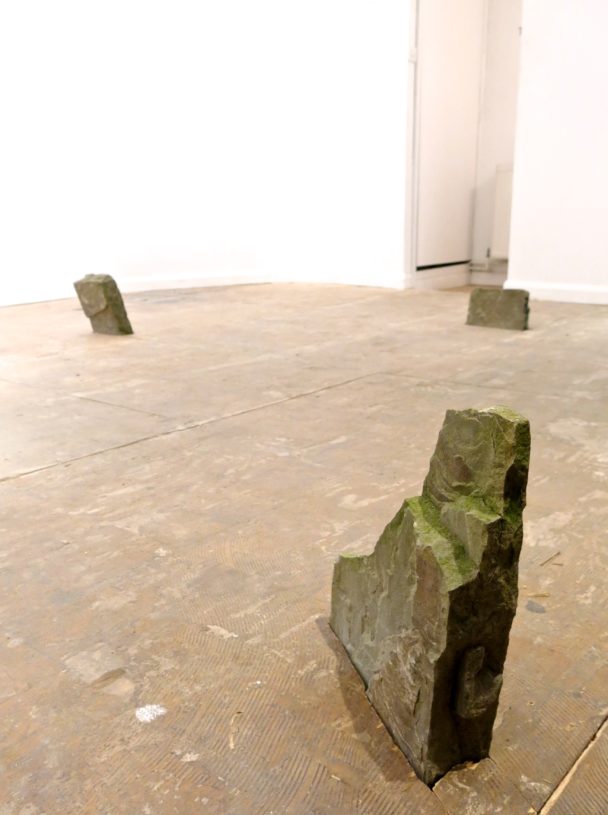

Suspended groundfloor, 2015
This work was part of the exhibition Mapping Continents, at LAMB, London, 2015.
De Bonis collected the rocks we notice when entering the exhibition space during an excursion she made into the English countryside. Usually used as pavement curbs, here the stones assume a poetic function as they pierce the floor and reveal itself on the ceiling of the space directly below. The aggressive gesture of piercing a hole through the gallery floor is counteracted by the stability of the stones that unites the exhibition spaces, creating is beauty in this delicate balance.
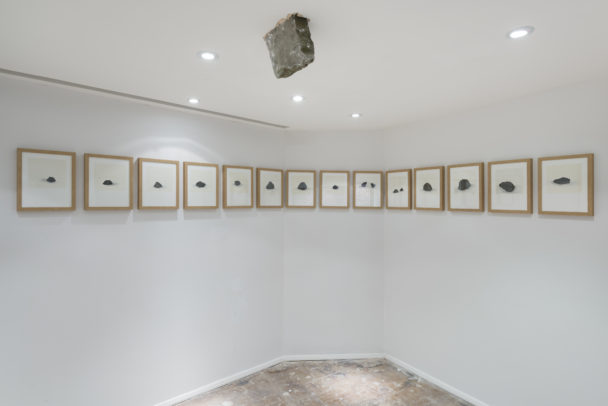

Suspended basement, 2015
This work was part of the exhibition Mapping Continents, at LAMB, London, 2015.
De Bonis collected the rocks we notice when entering the exhibition space during an excursion she made into the English countryside. Usually used as pavement curbs, here the stones assume a poetic function as they pierce the floor and reveal itself on the ceiling of the space directly below. The aggressive gesture of piercing a hole through the gallery floor is counteracted by the stability of the stones that unites the exhibition spaces, creating is beauty in this delicate balance.
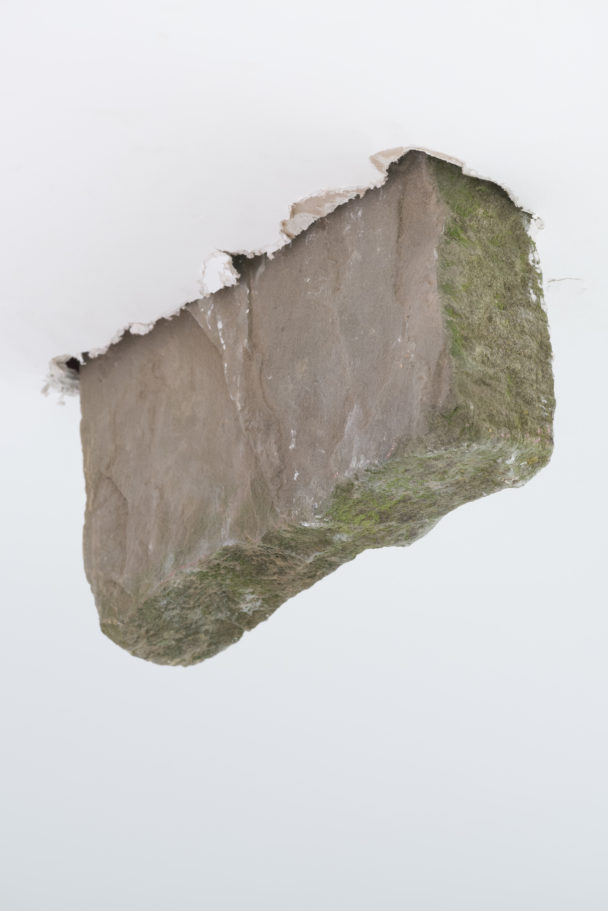
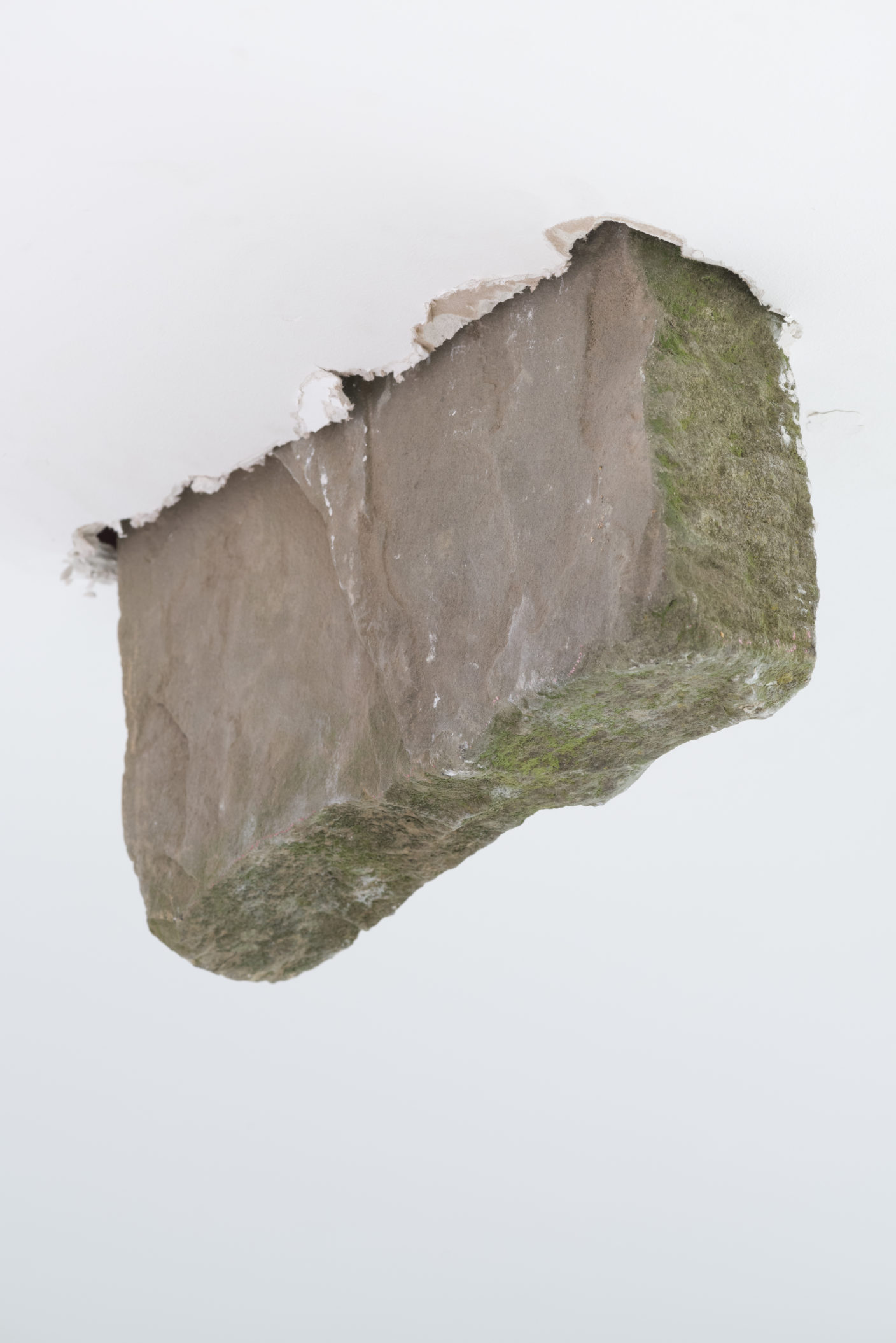
Suspended basement, 2015
This work was part of the exhibition Mapping Continents, at LAMB, London, 2015.
De Bonis collected the rocks we notice when entering the exhibition space during an excursion she made into the English countryside. Usually used as pavement curbs, here the stones assume a poetic function as they pierce the floor and reveal itself on the ceiling of the space directly below. The aggressive gesture of piercing a hole through the gallery floor is counteracted by the stability of the stones that unites the exhibition spaces, creating is beauty in this delicate balance.
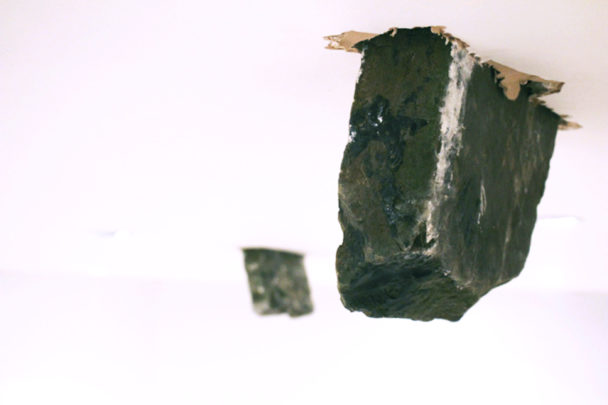

Suspended basement, 2015
This work was part of the exhibition Mapping Continents, at LAMB, London, 2015.
De Bonis collected the rocks we notice when entering the exhibition space during an excursion she made into the English countryside. Usually used as pavement curbs, here the stones assume a poetic function as they pierce the floor and reveal itself on the ceiling of the space directly below. The aggressive gesture of piercing a hole through the gallery floor is counteracted by the stability of the stones that unites the exhibition spaces, creating is beauty in this delicate balance.
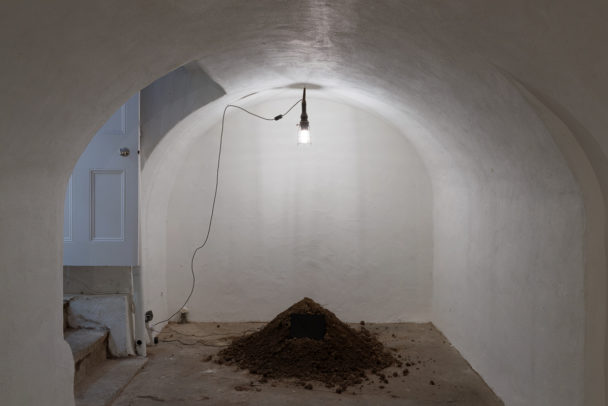
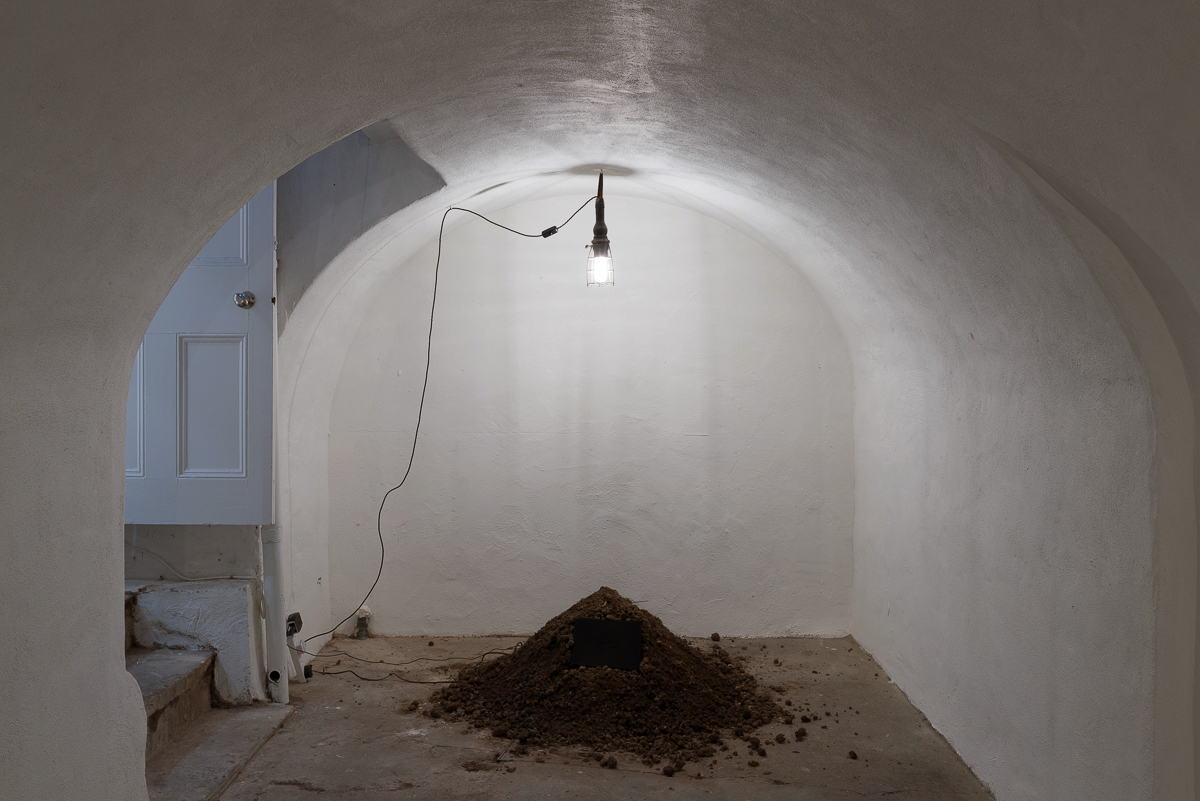
9508 km of geographical distance south, 2015
This work was part of the exhibition Mapping Continents, at LAMB, London, 2015.
Renata presents the installation 9508km of geographical distance (Itapevi/Binfield); two piles of soil with a speaker in each are positioned on the floor. The stack on the north side was collected at Billingbear Farm outside of London, the speakers reproducing the artists heartbeat while the south pile was gathered in Brazil and reproduces the heartbeat of Renataʼs soul mate back in Brazil. This work acts as a metaphor expressing that, despite the geographical distance between the two bodies, they are connected on a meta-physical level, showing that it is not modern communication tools that allows us to sustain long distance relationships.
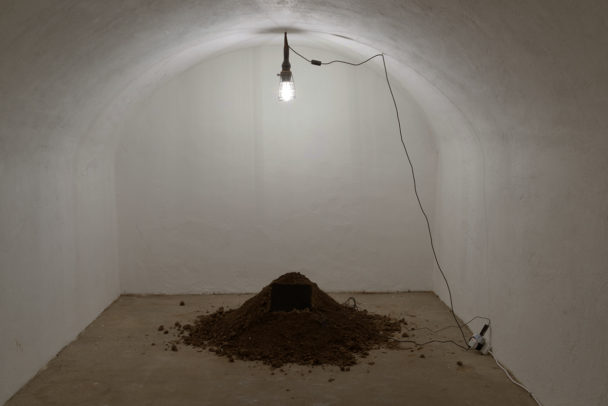

9508 km of geographical distance north, 2015
This work was part of the exhibition Mapping Continents, at LAMB, London, 2015.
Renata presents the installation 9508km of geographical distance (Itapevi/Binfield); two piles of soil with a speaker in each are positioned on the floor. The stack on the north side was collected at Billingbear Farm outside of London, the speakers reproducing the artists heartbeat while the south pile was gathered in Brazil and reproduces the heartbeat of Renataʼs soul mate back in Brazil. This work acts as a metaphor expressing that, despite the geographical distance between the two bodies, they are connected on a meta-physical level, showing that it is not modern communication tools that allows us to sustain long distance relationships.
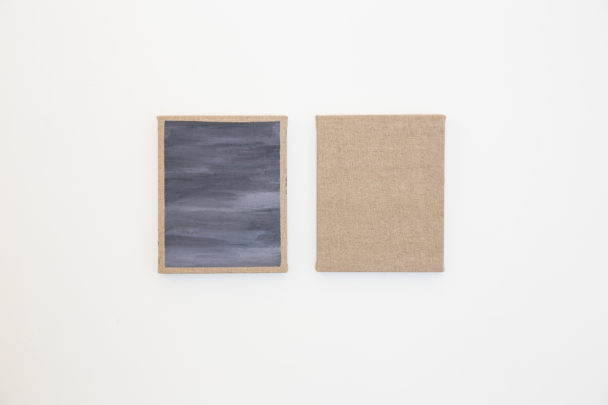

duas noites, 2015
Oil and wax on linen
Diptych, 24 × 30 cm each
A painting of the color of the night sky before the opening of the exhibition and a painting of the color of the night sky after the close of the same exhibition.
This work was part of the exhibition “, preencher o interlúdio sem quebrá-lo,”, at BFA Boatos Fine Artes, São Paulo, 2015.


Dormente V, 2015
Plaster
Variable dimensions
This work was part of the exhibition “, preencher o interlúdio sem quebrá-lo,”, at BFA Boatos Fine Artes, São Paulo, 2015.

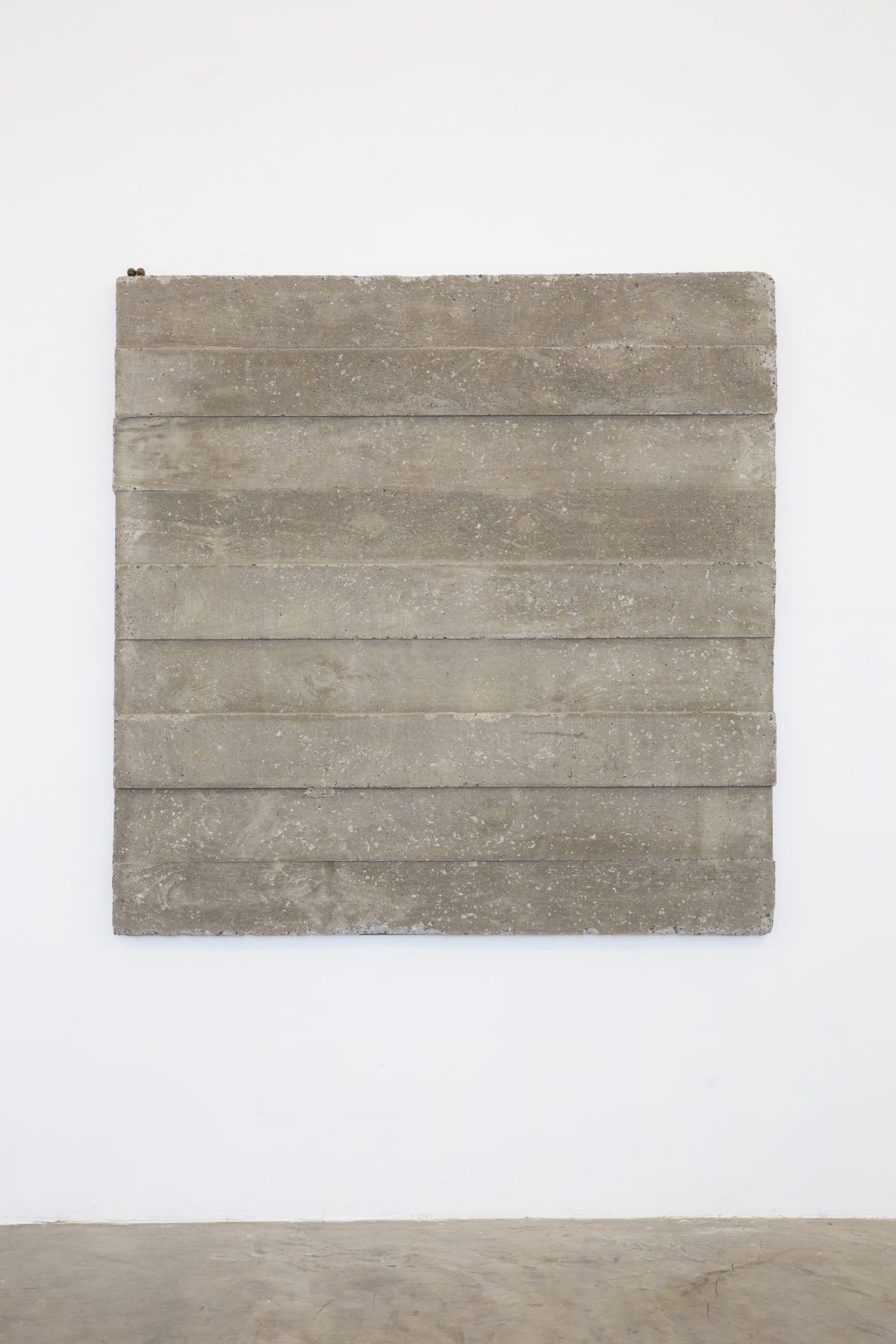
Estrado, 2015
Concret
135 × 135 × 5 cm
This work was part of the exhibition “, preencher o interlúdio sem quebrá-lo,”, at BFA Boatos Fine Artes, São Paulo, 2015.
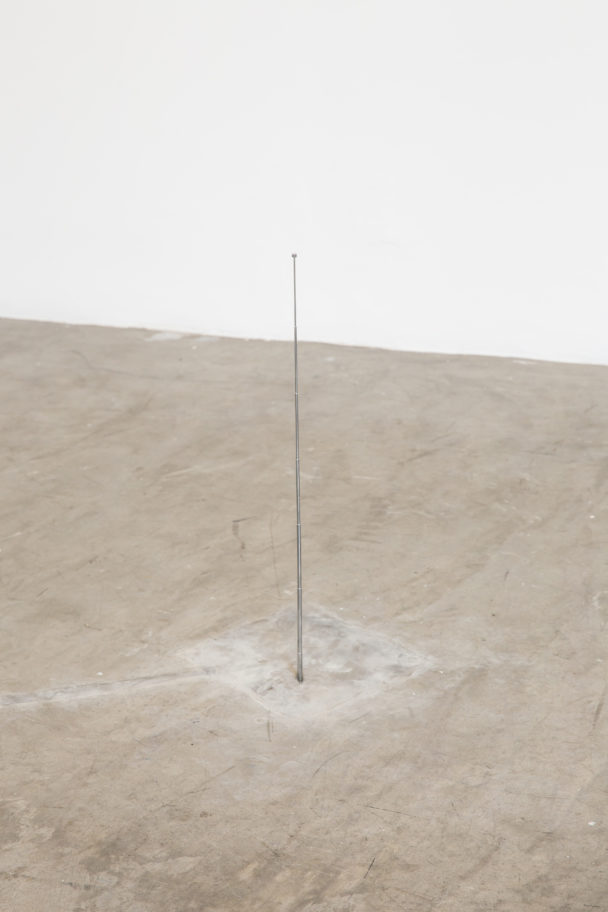
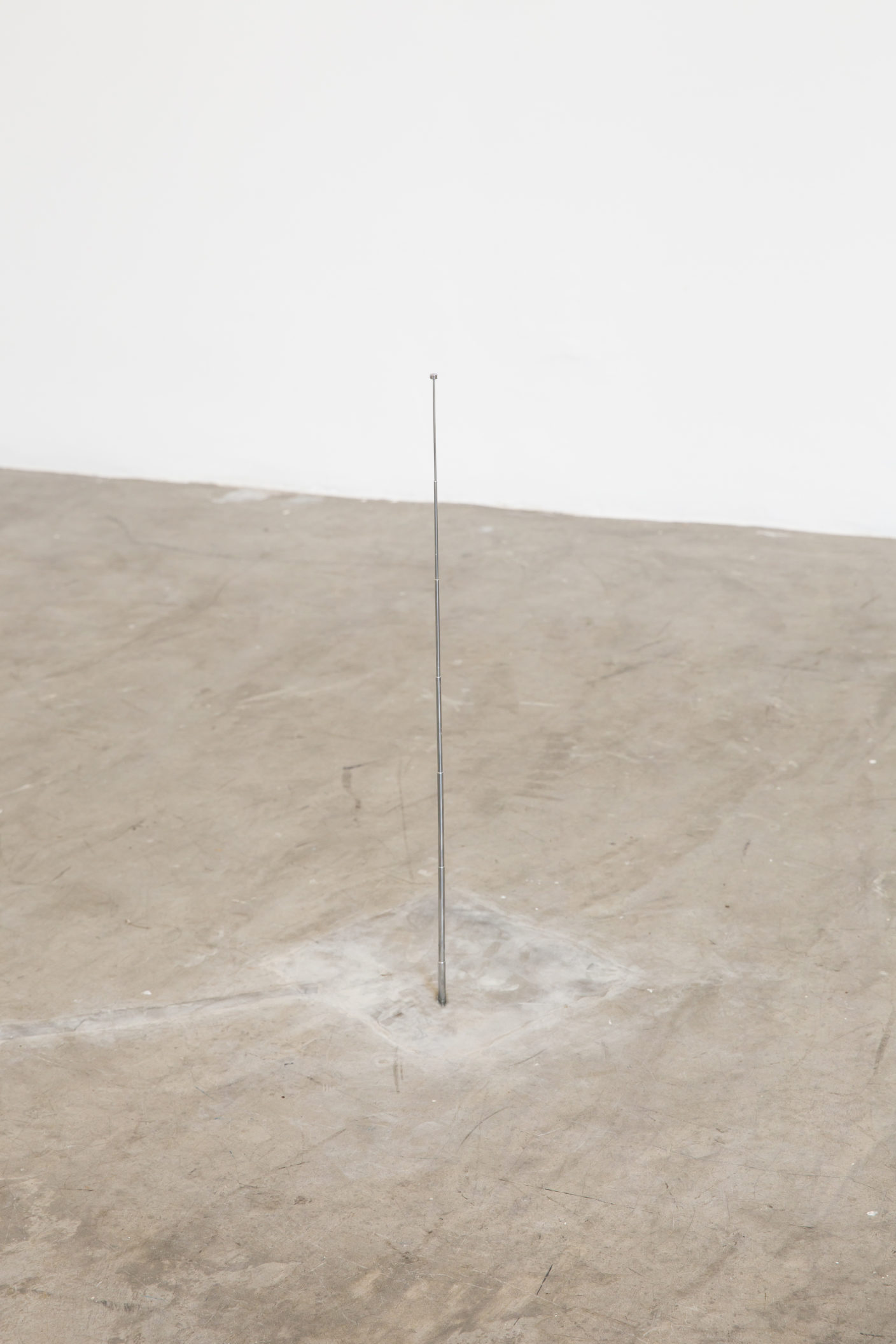
Naufrágio, 2015
Turned on radio tuned on news channel buried underground
Variable dimensions
This work was part of the exhibition “, preencher o interlúdio sem quebrá-lo,”, at BFA Boatos Fine Artes, São Paulo, 2015.


Big bang bang baang bang bang-bang., 2015
Cement, resin, sea shells filled with cement and lead
Variable dimensions
This work was part of the exhibition “, preencher o interlúdio sem quebrá-lo,”, at BFA Boatos Fine Artes, São Paulo, 2015.

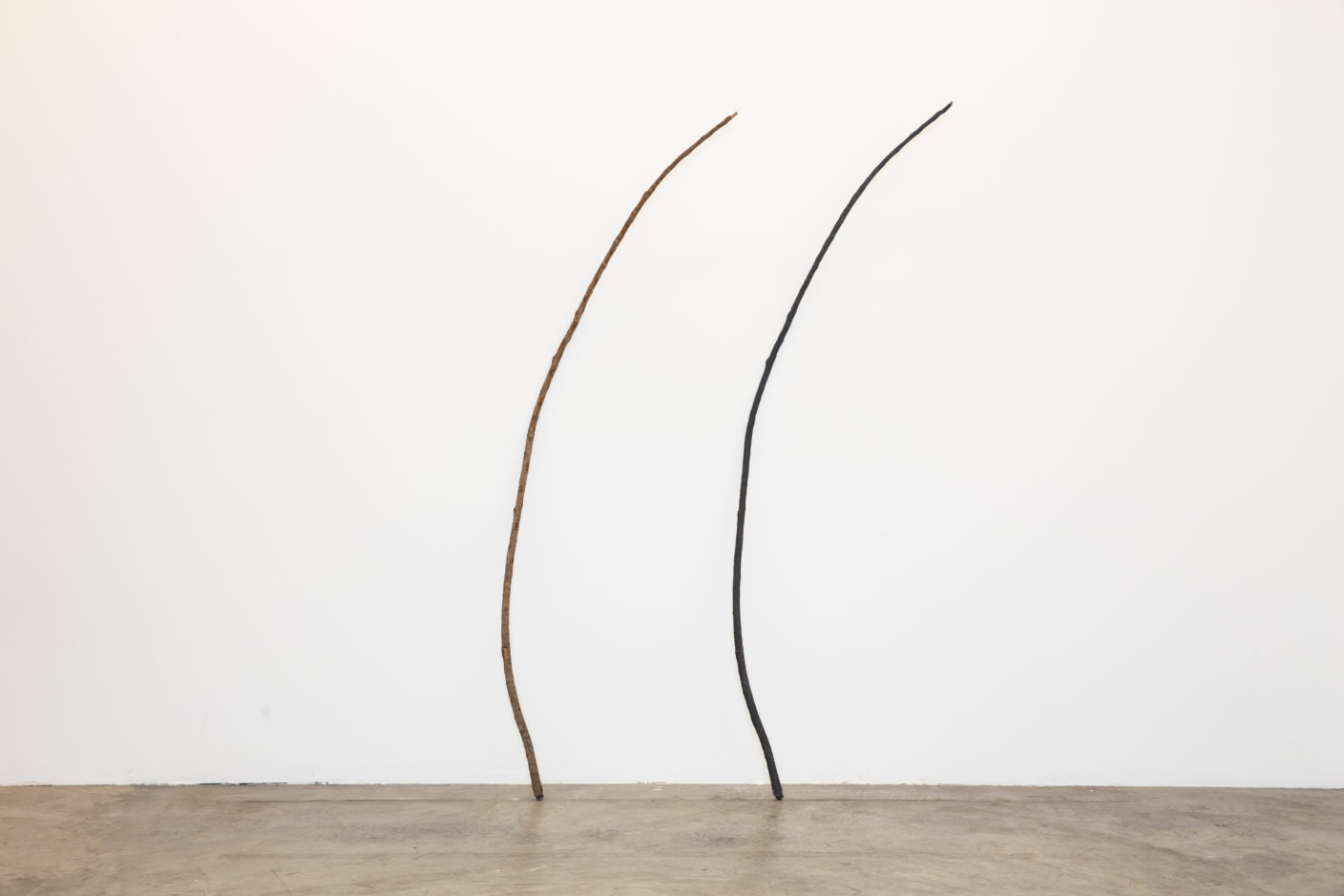
How do I know you are who you say you are?, 2015
Branch and copy of the branch in bronze
Variable dimensions
This work was part of the exhibition “, preencher o interlúdio sem quebrá-lo,”, at BFA Boatos Fine Artes, São Paulo, 2015.
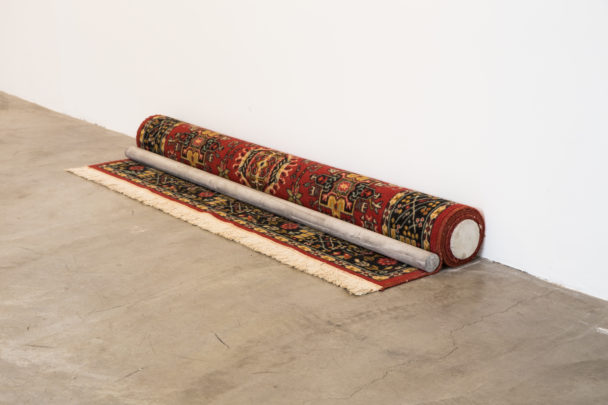

Ressaca, 2015
This work was part of the exhibition “, preencher o interlúdio sem quebrá-lo,”, at BFA Boatos Fine Artes, São Paulo, 2015.
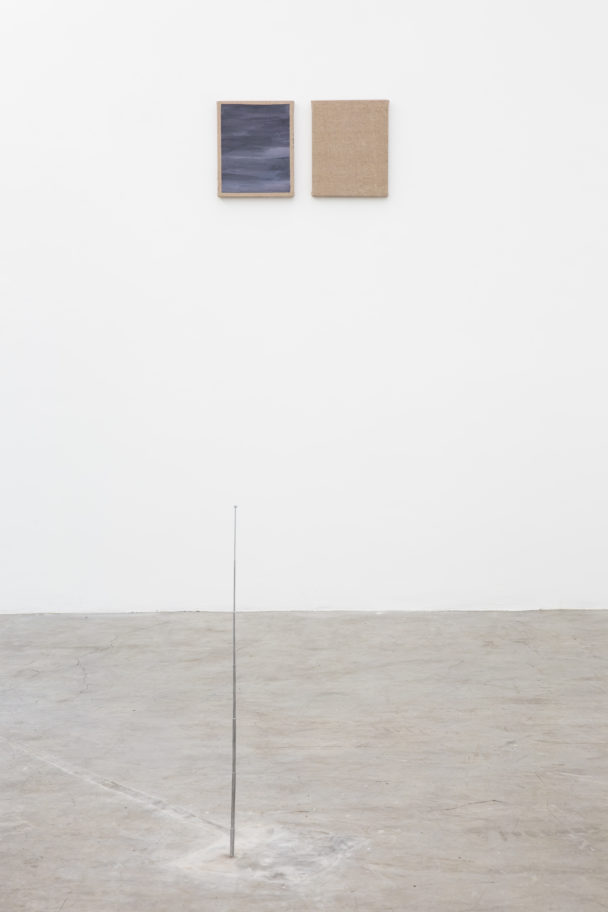
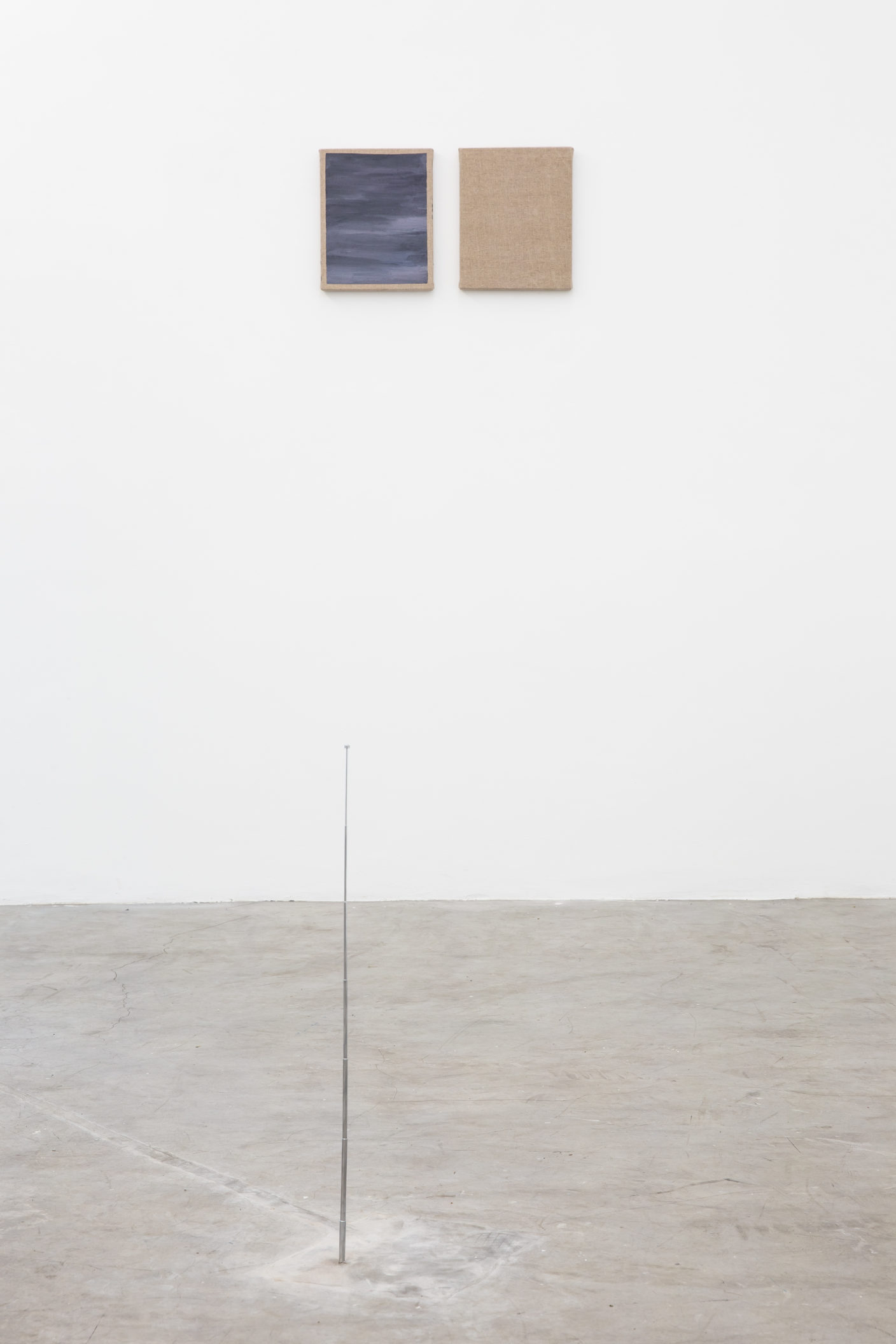
View of the exhibition “, preencher o interlúdio sem quebrá-lo,”, which took place at BFA Boatos Fine Artes, São Paulo, 2015.


View of the exhibition “, preencher o interlúdio sem quebrá-lo,”, which took place at BFA Boatos Fine Artes, São Paulo, 2015.
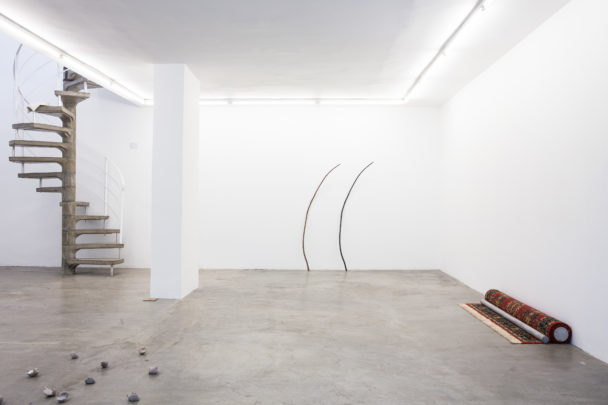

View of the exhibition “, preencher o interlúdio sem quebrá-lo,”, which took place at BFA Boatos Fine Artes, São Paulo, 2015.
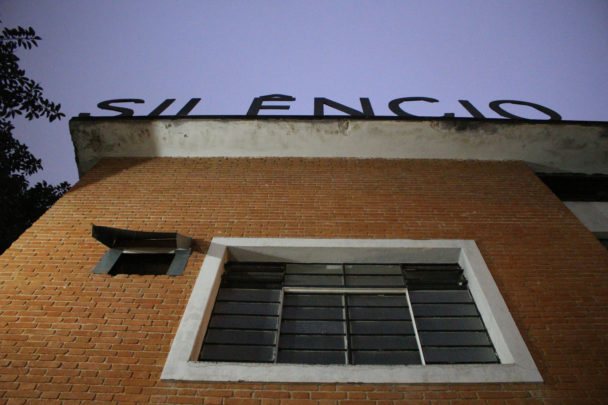

Suíte Parte #1, 2014
From two gestures that explore with new impetus its well-known verve, “Suíte” is born under the sign of silence. The first makes use of a literal appropriation that materializes the word to serve as a large installation at the top of the house, in a language game that ventilates more than one semantic possibility. (…)
[excerpt from the text written by curator Germano Dushá on the occasion of the exhibition]
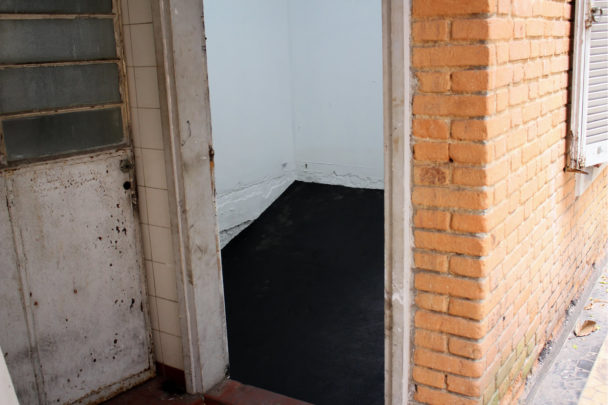
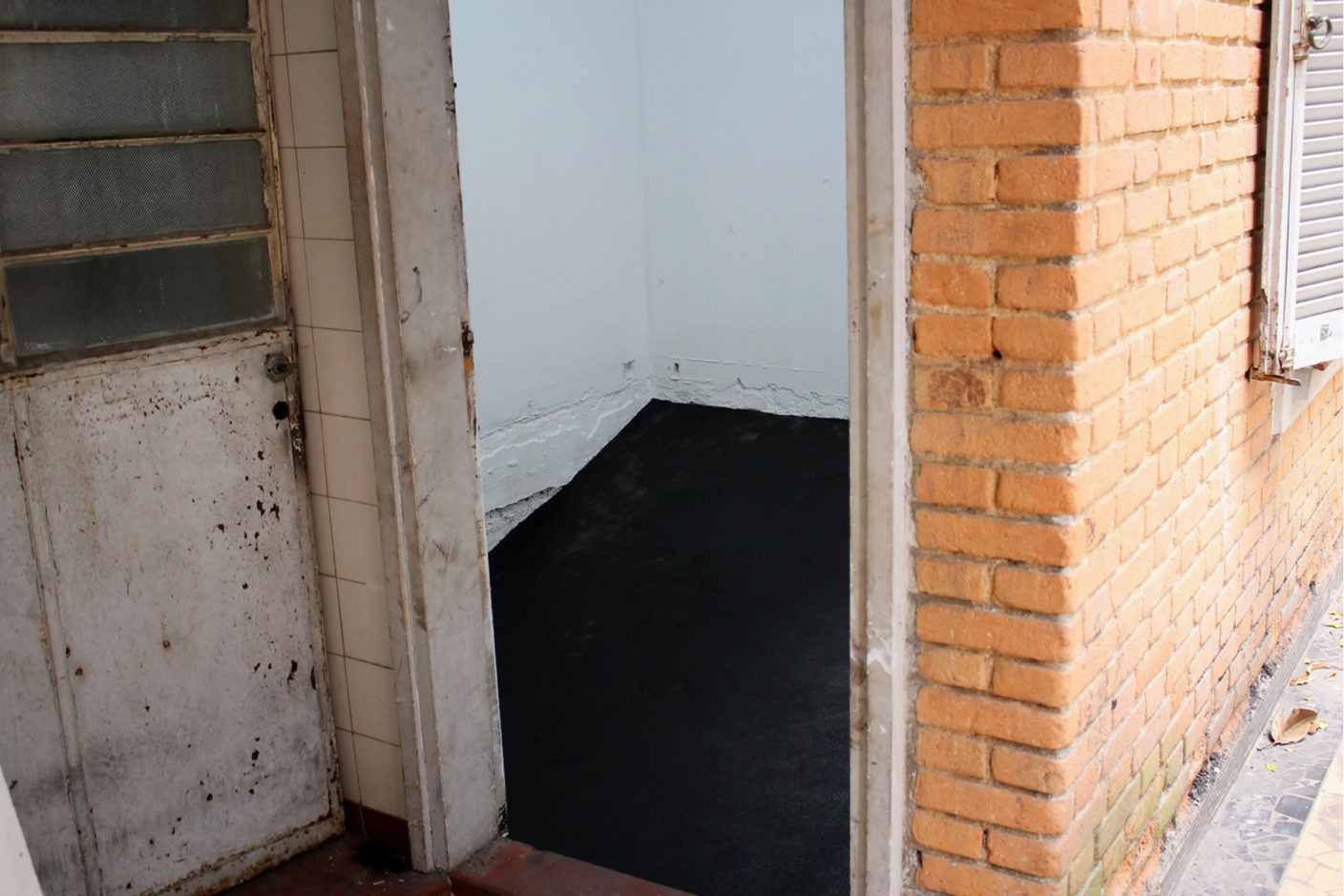
Suíte Parte #2, 2014
(…) The second intervenes in order to subtract architectural content, and eliminates possible answers by opening a disconcerting angle on the floor of a room. One rises above and carries the exhibition field to the entire surrounding region, while the other throws itself towards the ground and withdraws to a specific point.
If the actions that give shape to it reveal its negative elan, it makes clear from the beginning the attempt to think against itself. As soon as it acts, it is to suggest the need for a sharp aphonia and an oblique cut in what we take for granted. This tension throws us into an indissoluble clash between the inappropriateness of coming into the world and the temptation to exist. It is as if it were necessary to move to reach Nothing, in a balance that questions its own condition while allowing itself to be attracted by the brightness and amplitude of the void.
[excerpt from the text written by curator Germano Dushá on the occasion of the exhibition]

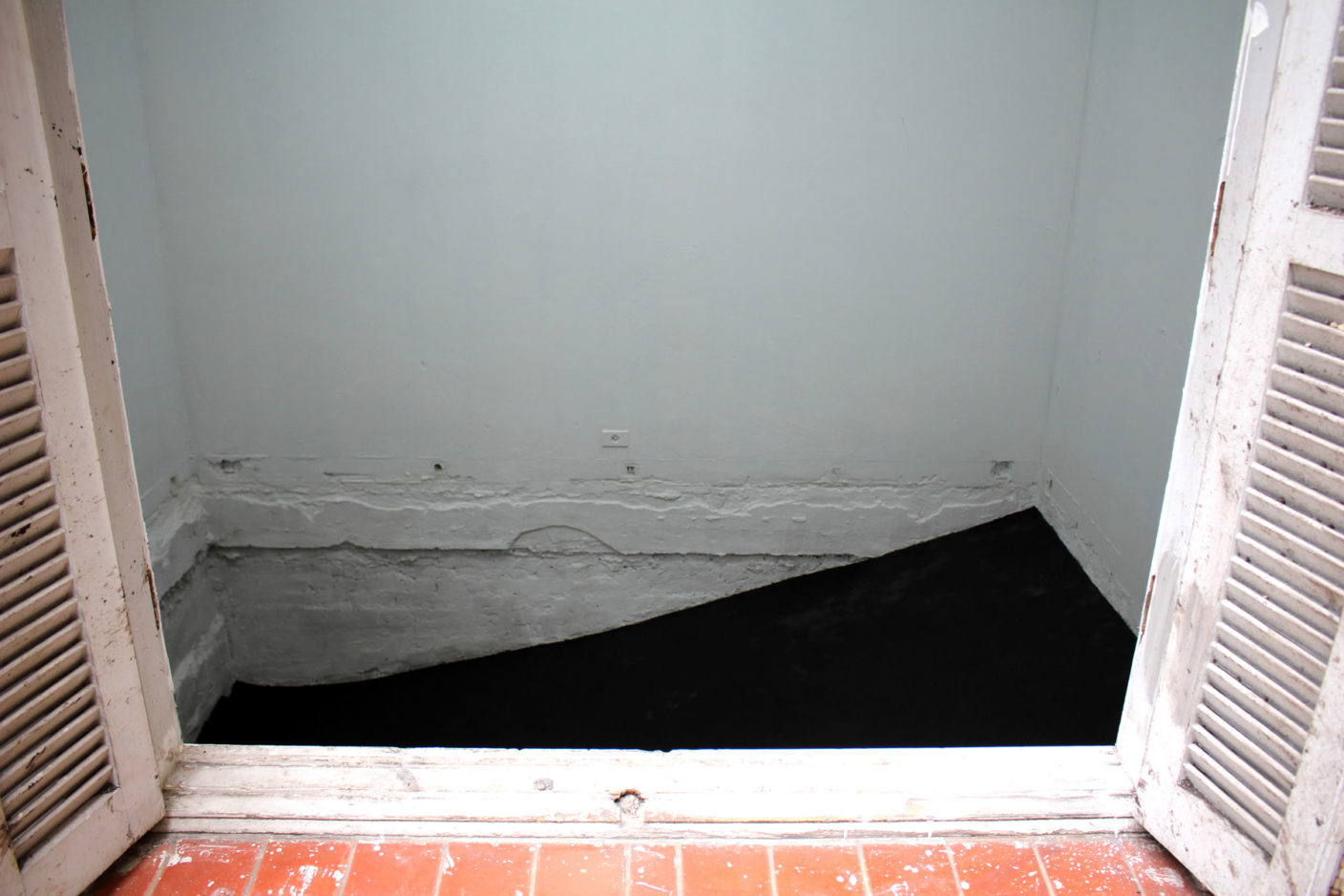
2_Coletor-Renata-De-Bonis-Suíte-Parte-2-31
(…) The second intervenes in order to subtract architectural content, and eliminates possible answers by opening a disconcerting angle on the floor of a room. One rises above and carries the exhibition field to the entire surrounding region, while the other throws itself towards the ground and withdraws to a specific point.
If the actions that give shape to it reveal its negative elan, it makes clear from the beginning the attempt to think against itself. As soon as it acts, it is to suggest the need for a sharp aphonia and an oblique cut in what we take for granted. This tension throws us into an indissoluble clash between the inappropriateness of coming into the world and the temptation to exist. It is as if it were necessary to move to reach Nothing, in a balance that questions its own condition while allowing itself to be attracted by the brightness and amplitude of the void.
[excerpt from the text written by curator Germano Dushá on the occasion of the exhibition]

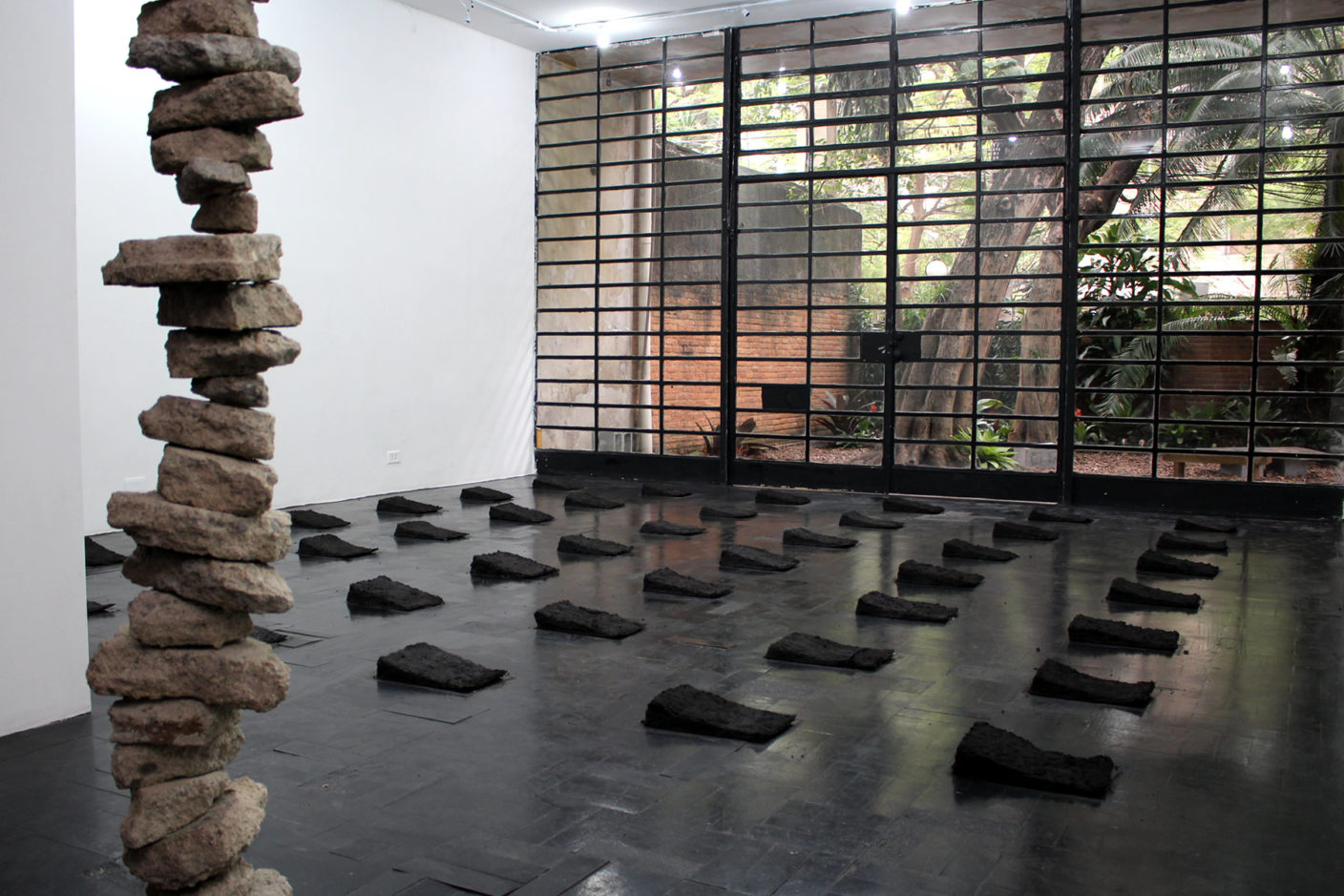
Suíte Parte #3 e Parte #4
The other works that make up this show appear in the crack that opens from these vertically opposite markings. “Parte #3” and “Parte #4” are collections of waste taken from the ground. The pieces of concrete and earth formerly used in the subterranean bones gain the surface in an operation that deliberately manages the construction and demolition cycles to reprogram the distribution of roles in the narrative of the common. They are volumes that at the same time refer to small geographic accidents and point to the future of the place in which they are located: a huge construction site that will later give rise to large buildings.
[excerpt from the text written by curator Germano Dushá on the occasion of the exhibition]
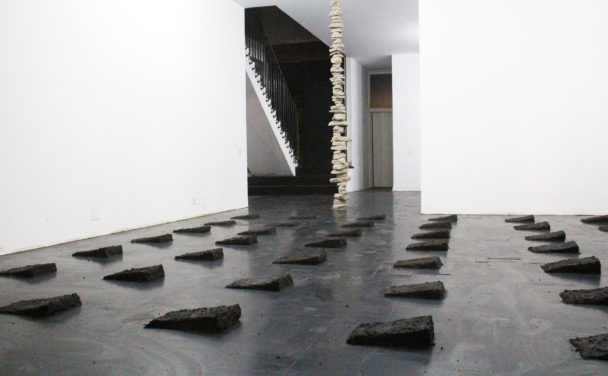
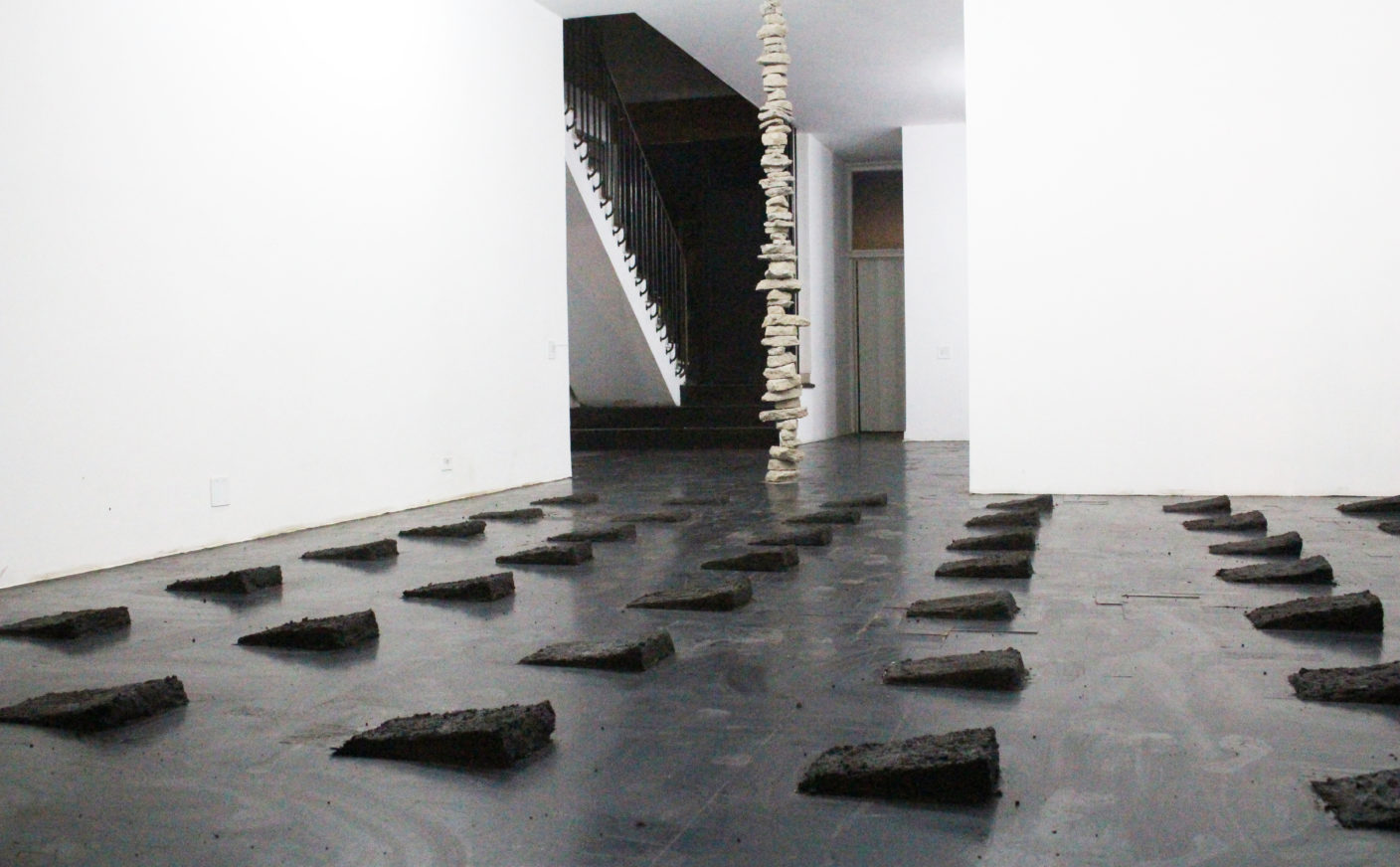
Suíte Parte #3 e Parte #4
The other works that make up this show appear in the crack that opens from these vertically opposite markings. “Parte #3” and “Parte #4” are collections of waste taken from the ground. The pieces of concrete and earth formerly used in the subterranean bones gain the surface in an operation that deliberately manages the construction and demolition cycles to reprogram the distribution of roles in the narrative of the common. They are volumes that at the same time refer to small geographic accidents and point to the future of the place in which they are located: a huge construction site that will later give rise to large buildings.
[excerpt from the text written by curator Germano Dushá on the occasion of the exhibition]
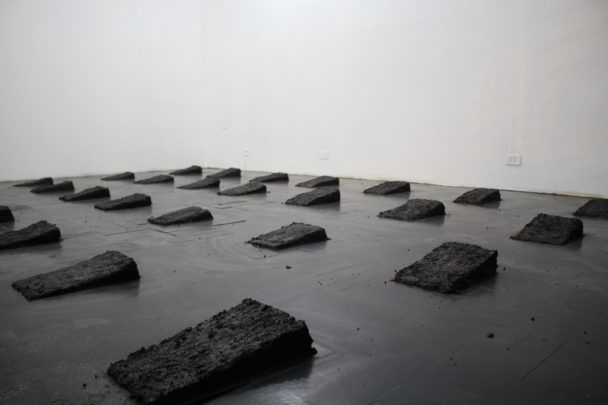

Suíte Parte #4
The other works that make up this show appear in the crack that opens from these vertically opposite markings. “Parte #3” and “Parte #4” are collections of waste taken from the ground. The pieces of concrete and earth formerly used in the subterranean bones gain the surface in an operation that deliberately manages the construction and demolition cycles to reprogram the distribution of roles in the narrative of the common. They are volumes that at the same time refer to small geographic accidents and point to the future of the place in which they are located: a huge construction site that will later give rise to large buildings.
[excerpt from the text written by curator Germano Dushá on the occasion of the exhibition]
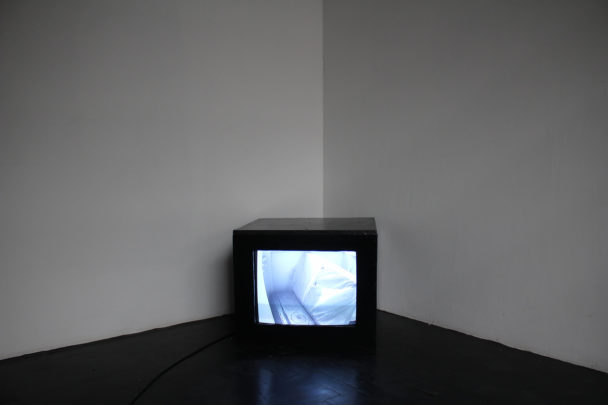
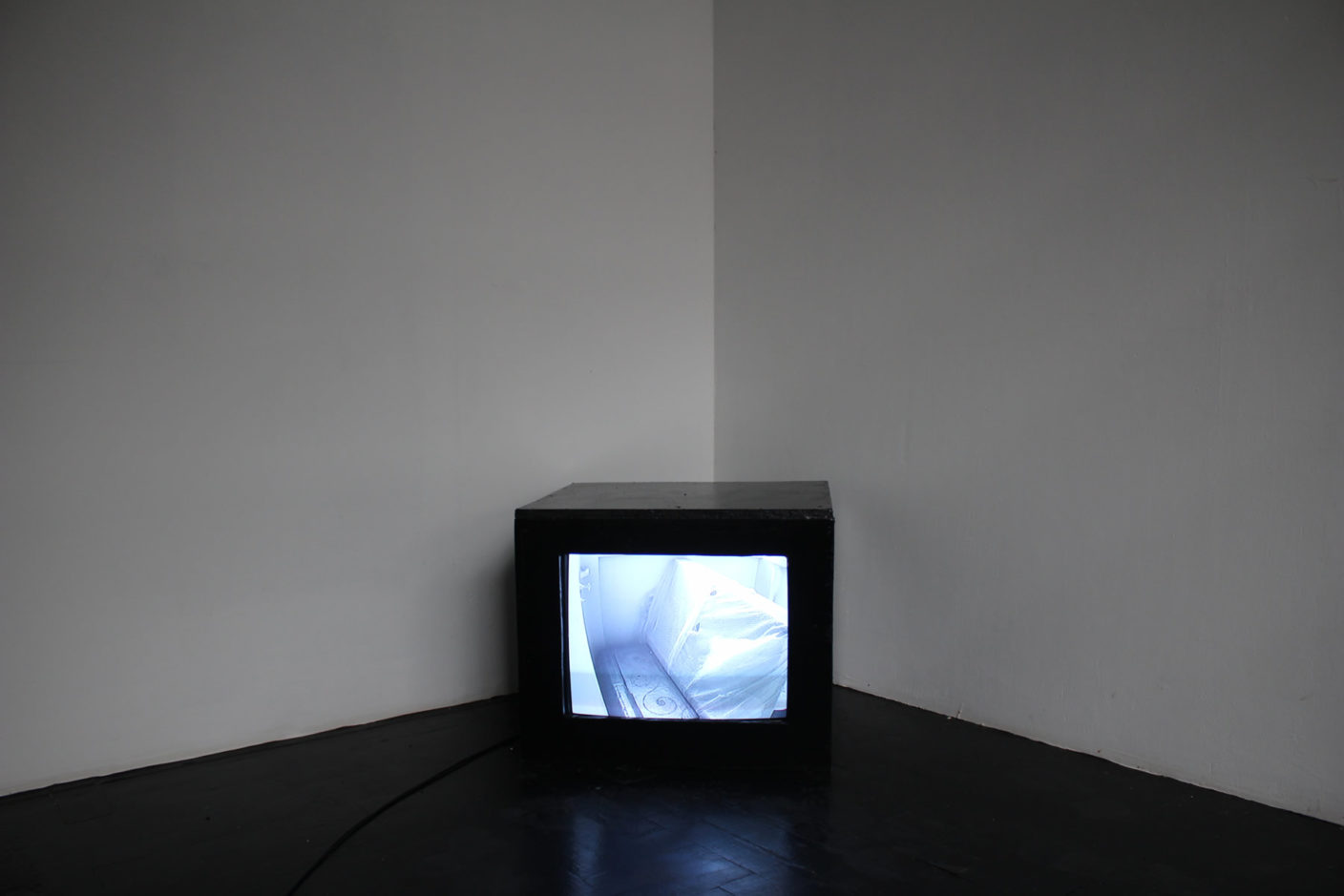
Suíte Parte #5, 2014
In “Parte #5” the cartographic notions of the house are mixed. The second floor, a space that remains hidden whenever there are visitors, is brought to the social center through the mediation of devices normally used as security instruments. On the monitors what we see is a mythology of oblivion, capable of creating a fabric in which it becomes possible to interpret the history of the place. In this sense, Renata makes known the prosaic details of an old house — loaned for a short period and to be sequentially demolished; and it brings out the negotiations that allow the exposure itself to take place.
[excerpt from the text written by curator Germano Dushá on the occasion of the exhibition]
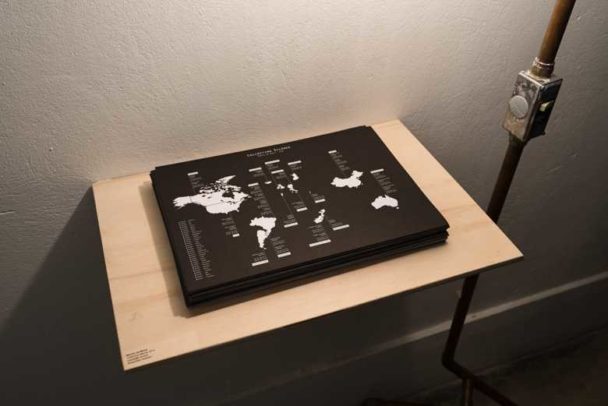

Collecting Silence, 2014
Collecting Silence is a sound installation that brings together “silent” recordings on five continents.
As an invitation from the artist, thirty-one people sent sound records that they would consider to be a moment of silence. A symbolic and romantic gesture, as it is scientifically impossible for man to be in contact with the total absence of sound.
The work was developed during the residency RedBull Station in downtown São Paulo and was shown at the end of the residency in the basement of the building, in a dark room, where the recordings were played at the exact moment they were recorded, divided into 5 speakers mapped through the space, one for each continent.
The map/infographic allowed navigation by region or time.
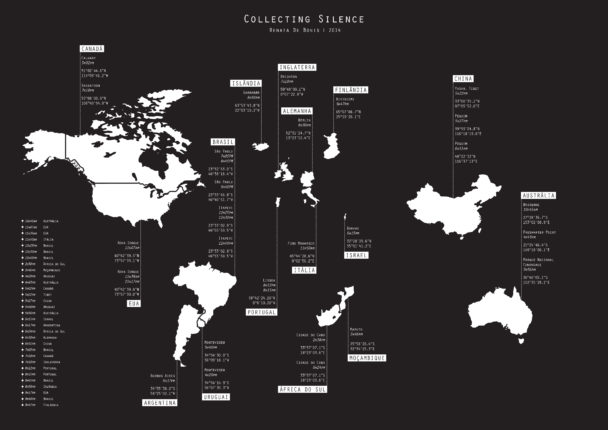
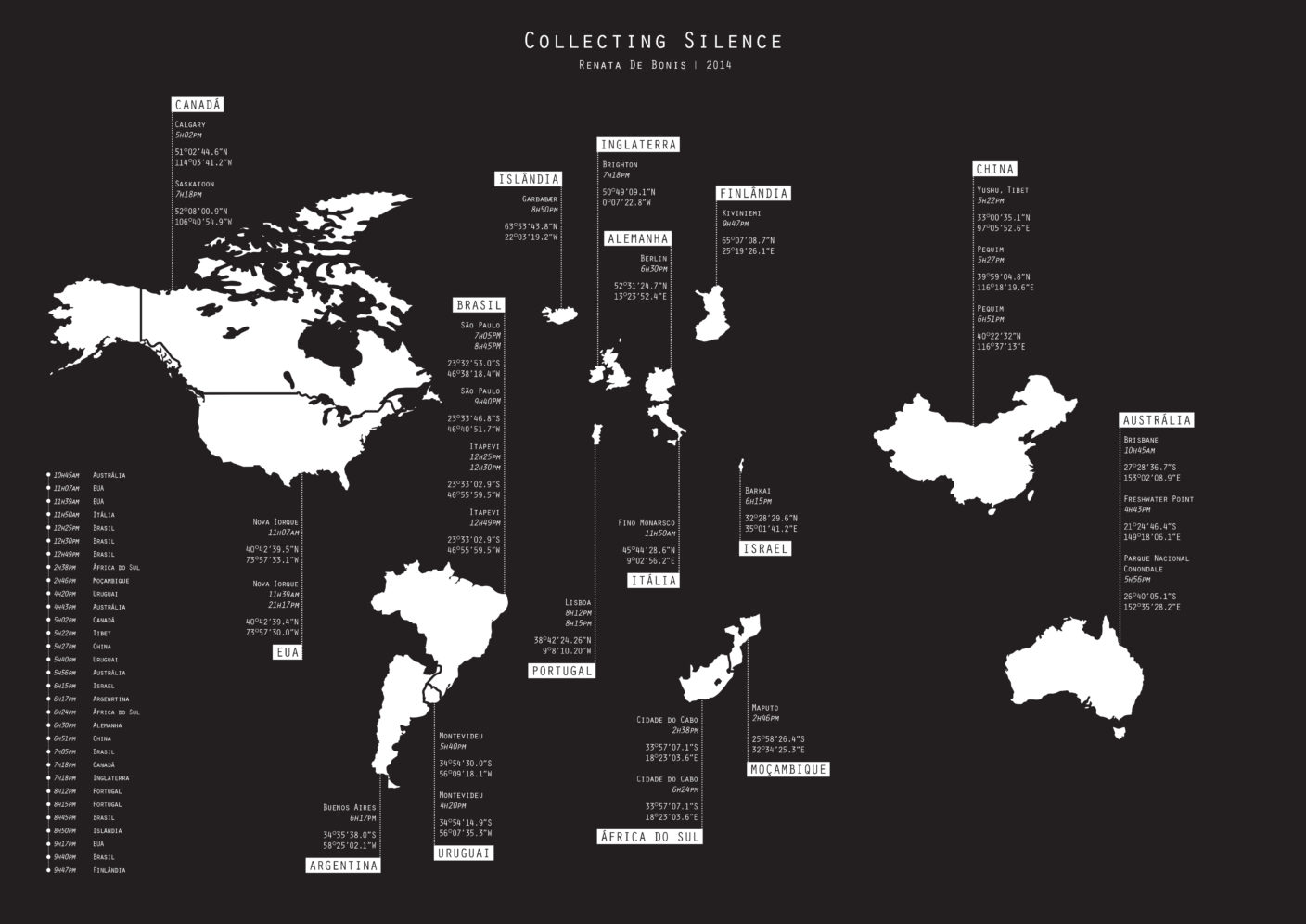
Collecting Silence, 2014
Collecting Silence is a sound installation that brings together “silent” recordings on five continents.
As an invitation from the artist, thirty-one people sent sound records that they would consider to be a moment of silence. A symbolic and romantic gesture, as it is scientifically impossible for man to be in contact with the total absence of sound.
The work was developed during the residency RedBull Station in downtown São Paulo and was shown at the end of the residency in the basement of the building, in a dark room, where the recordings were played at the exact moment they were recorded, divided into 5 speakers mapped through the space, one for each continent.
The map/infographic allowed navigation by region or time.


View of the “Norte” exhibition, which took place at CCSP, São Paulo, 2014.
Norte is intricately linked to the artist’s experience in Iceland, during an artist residency in 2013. Living in Skagaströnd, populated with 500 residents in the north of the country, brought her close to this unique, silent, somewhat indomitable environment, synthesized in Mount Spákonufell, which ends up guiding the exhibition’s audiovisual piece and also spilling over into the rest of the exhibition. “In the place, I began to perceive a more geological time”, reports the artist.
[excerpt from the text “Mapas de matéria”, written by Mario Gioia for the exhibition]

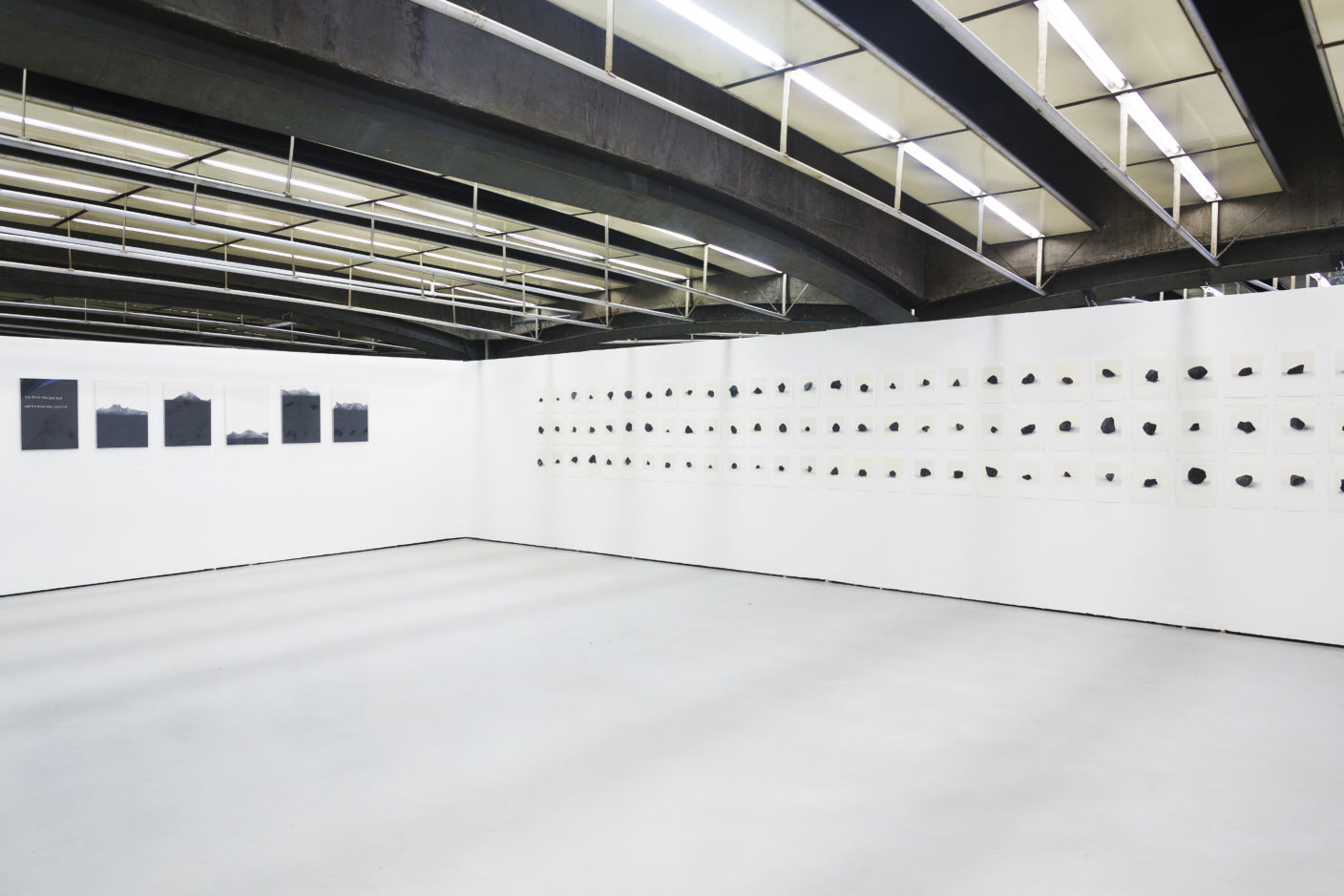
View of the “Norte” exhibition, which took place at CCSP, São Paulo, 2014.
Norte is intricately linked to the artist’s experience in Iceland, during an artist residency in 2013. Living in Skagaströnd, populated with 500 residents in the north of the country, brought her close to this unique, silent, somewhat indomitable environment, synthesized in Mount Spákonufell, which ends up guiding the exhibition’s audiovisual piece and also spilling over into the rest of the exhibition. “In the place, I began to perceive a more geological time”, reports the artist.
[excerpt from the text “Mapas de matéria”, written by Mario Gioia for the exhibition]
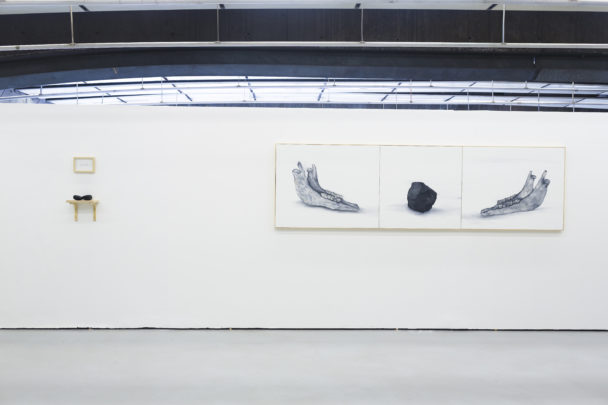

Anthitesis, 2013
Oil and wax on canvas
280 × 80cm
This work was part of the exhibition “Norte”, at CCSP, São Paulo, 2014.
Norte is intricately linked to the artist’s experience in Iceland, during an artist residency in 2013. Living in Skagaströnd, populated with 500 residents in the north of the country, brought her close to this unique, silent, somewhat indomitable environment, synthesized in Mount Spákonufell, which ends up guiding the exhibition’s audiovisual piece and also spilling over into the rest of the exhibition. “In the place, I began to perceive a more geological time”, reports the artist.
[excerpt from the text “Mapas de matéria”, written by Mario Gioia for the exhibition]
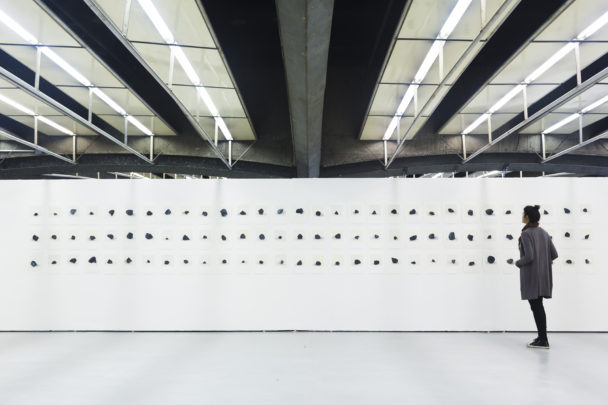

Monolito, 2013
Oil and wax on paper
Polyptych of 90
This work was part of the exhibition “Norte”, at CCSP, São Paulo, 2014.
Norte is intricately linked to the artist’s experience in Iceland, during an artist residency in 2013. Living in Skagaströnd, populated with 500 residents in the north of the country, brought her close to this unique, silent, somewhat indomitable environment, synthesized in Mount Spákonufell, which ends up guiding the exhibition’s audiovisual piece and also spilling over into the rest of the exhibition. “In the place, I began to perceive a more geological time”, reports the artist.
[excerpt from the text “Mapas de matéria”, written by Mario Gioia for the exhibition]
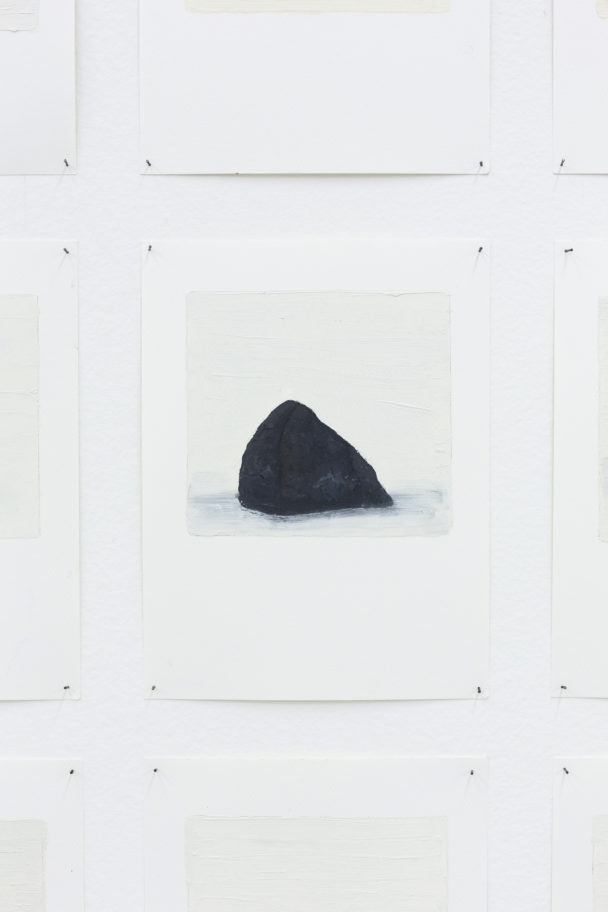

Monolito, 2013
Oil and wax on paper
Polyptych of 90
This work was part of the exhibition “Norte”, at CCSP, São Paulo, 2014.
Norte is intricately linked to the artist’s experience in Iceland, during an artist residency in 2013. Living in Skagaströnd, populated with 500 residents in the north of the country, brought her close to this unique, silent, somewhat indomitable environment, synthesized in Mount Spákonufell, which ends up guiding the exhibition’s audiovisual piece and also spilling over into the rest of the exhibition. “In the place, I began to perceive a more geological time”, reports the artist.
[excerpt from the text “Mapas de matéria”, written by Mario Gioia for the exhibition]

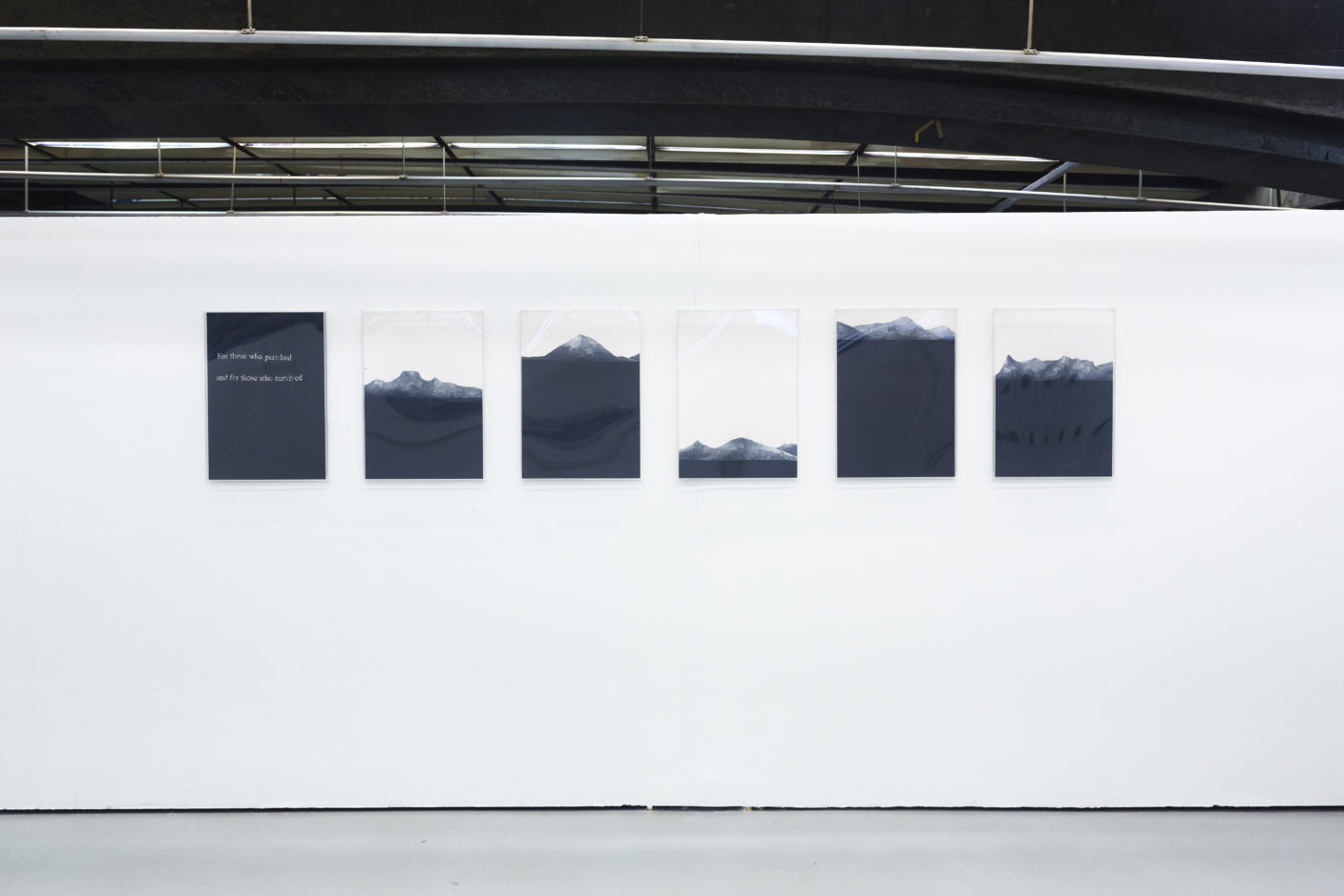
For those who perished, and for those who survived, 2013/2014
Oil and wax on paper
Mounted in 6 acrylic boxes
This work was part of the exhibition “Norte”, at CCSP, São Paulo, 2014.
Norte is intricately linked to the artist’s experience in Iceland, during an artist residency in 2013. Living in Skagaströnd, populated with 500 residents in the north of the country, brought her close to this unique, silent, somewhat indomitable environment, synthesized in Mount Spákonufell, which ends up guiding the exhibition’s audiovisual piece and also spilling over into the rest of the exhibition. “In the place, I began to perceive a more geological time”, reports the artist.
[excerpt from the text “Mapas de matéria”, written by Mario Gioia for the exhibition]


For those who perished, and for those who survived, 2013/2014
Oil and wax on paper
Mounted in 6 acrylic boxes
This work was part of the exhibition “Norte”, at CCSP, São Paulo, 2014.
Norte is intricately linked to the artist’s experience in Iceland, during an artist residency in 2013. Living in Skagaströnd, populated with 500 residents in the north of the country, brought her close to this unique, silent, somewhat indomitable environment, synthesized in Mount Spákonufell, which ends up guiding the exhibition’s audiovisual piece and also spilling over into the rest of the exhibition. “In the place, I began to perceive a more geological time”, reports the artist.
[excerpt from the text “Mapas de matéria”, written by Mario Gioia for the exhibition]


For those who perished, and for those who survived, 2013/2014
Oil and wax on paper
Mounted in 6 acrylic boxes
This work was part of the exhibition “Norte”, at CCSP, São Paulo, 2014.
Norte is intricately linked to the artist’s experience in Iceland, during an artist residency in 2013. Living in Skagaströnd, populated with 500 residents in the north of the country, brought her close to this unique, silent, somewhat indomitable environment, synthesized in Mount Spákonufell, which ends up guiding the exhibition’s audiovisual piece and also spilling over into the rest of the exhibition. “In the place, I began to perceive a more geological time”, reports the artist.
[excerpt from the text “Mapas de matéria”, written by Mario Gioia for the exhibition]

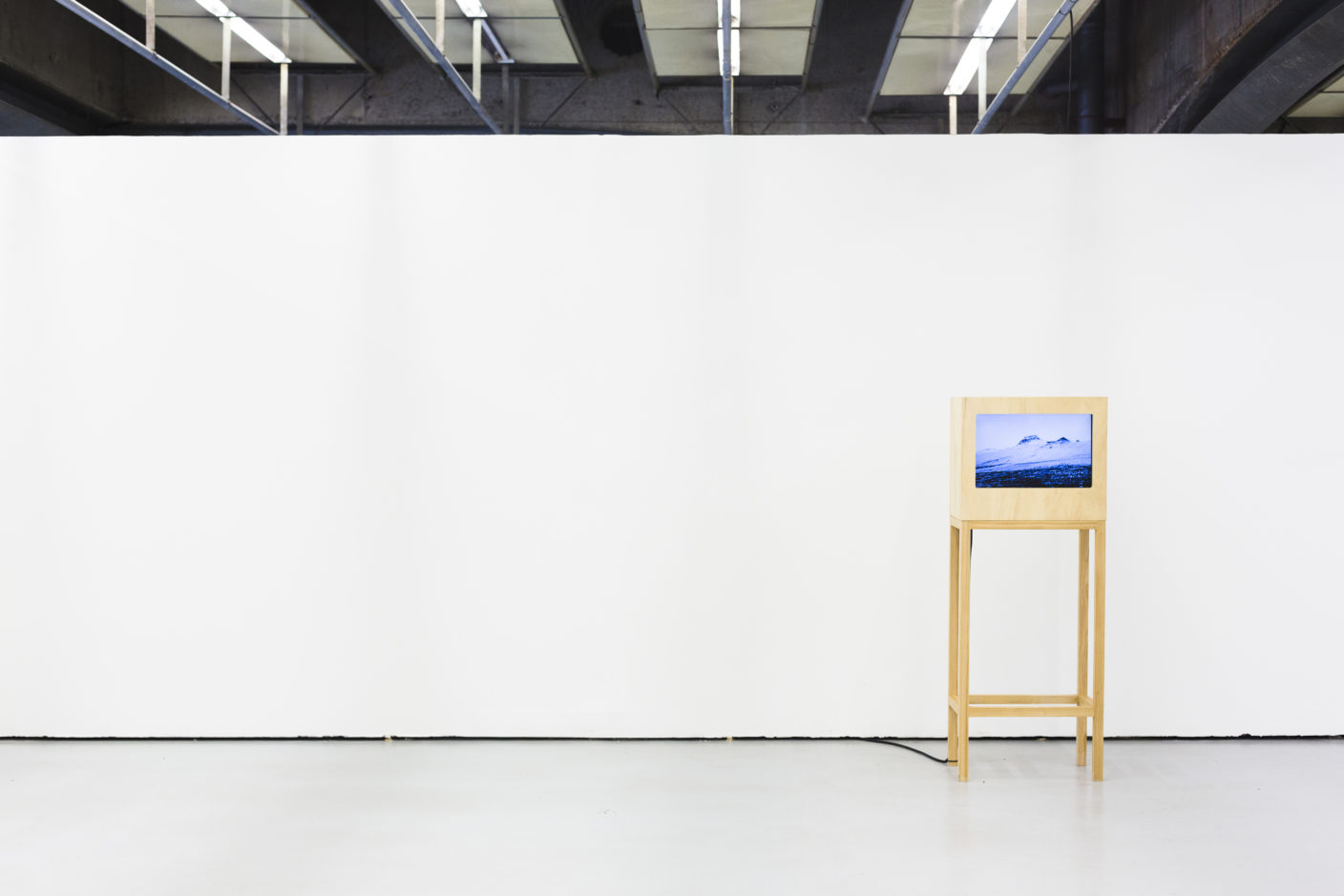
Mountains are Mountains, Men are Men, 2013
View of the “Norte” exhibition, which took place at CCSP, São Paulo, 2014.
Norte is intricately linked to the artist’s experience in Iceland, during an artist residency in 2013. Living in Skagaströnd, populated with 500 residents in the north of the country, brought her close to this unique, silent, somewhat indomitable environment, synthesized in Mount Spákonufell, which ends up guiding the exhibition’s audiovisual piece and also spilling over into the rest of the exhibition. “In the place, I began to perceive a more geological time”, reports the artist.
[excerpt from the text “Mapas de matéria”, written by Mario Gioia for the exhibition]

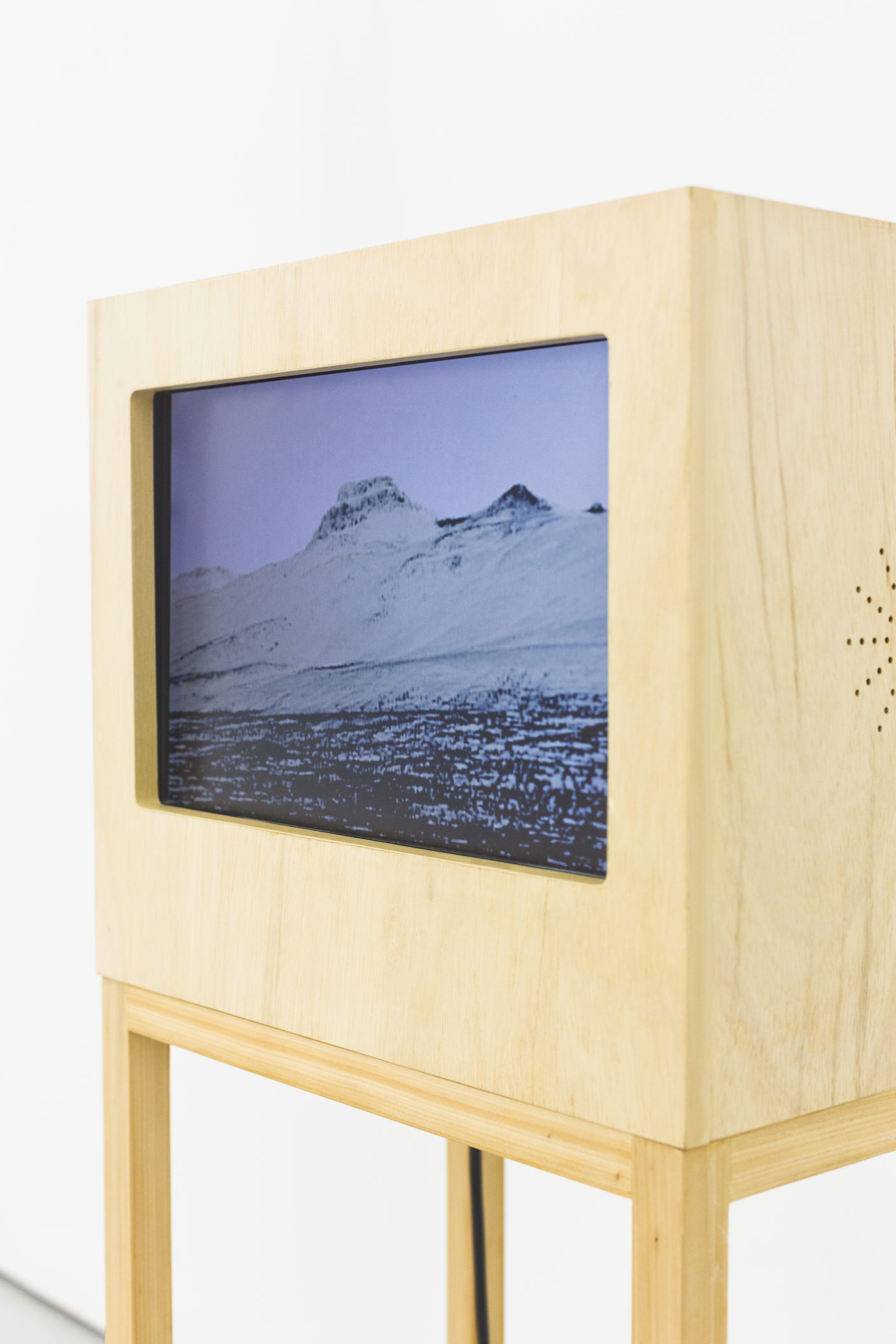
Mountains are Mountains, Men are Men, 2013
B&W, silent and in loop
This work was part of the exhibition “Norte”, at CCSP, São Paulo, 2014.
Norte is intricately linked to the artist’s experience in Iceland, during an artist residency in 2013. Living in Skagaströnd, populated with 500 residents in the north of the country, brought her close to this unique, silent, somewhat indomitable environment, synthesized in Mount Spákonufell, which ends up guiding the exhibition’s audiovisual piece and also spilling over into the rest of the exhibition. “In the place, I began to perceive a more geological time”, reports the artist.
[excerpt from the text “Mapas de matéria”, written by Mario Gioia for the exhibition]
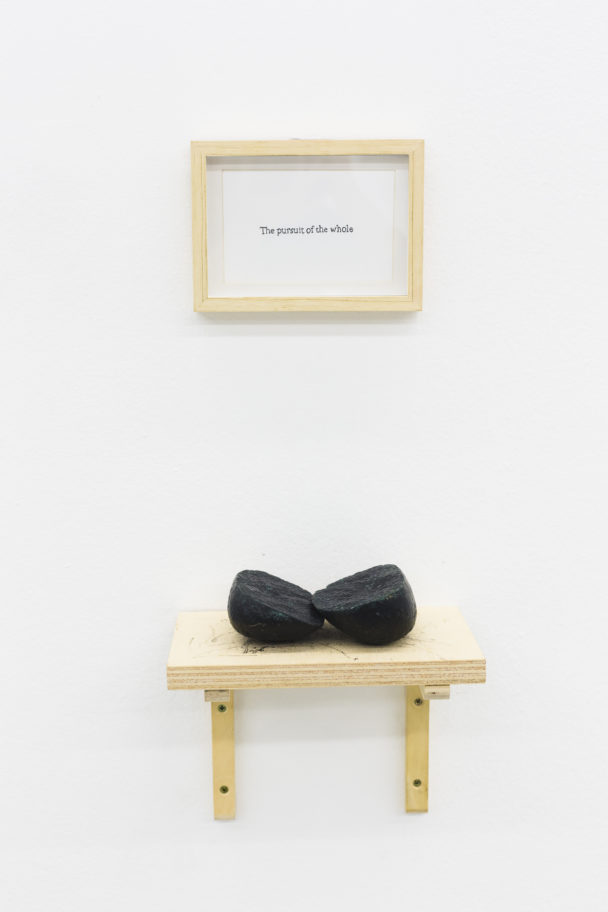
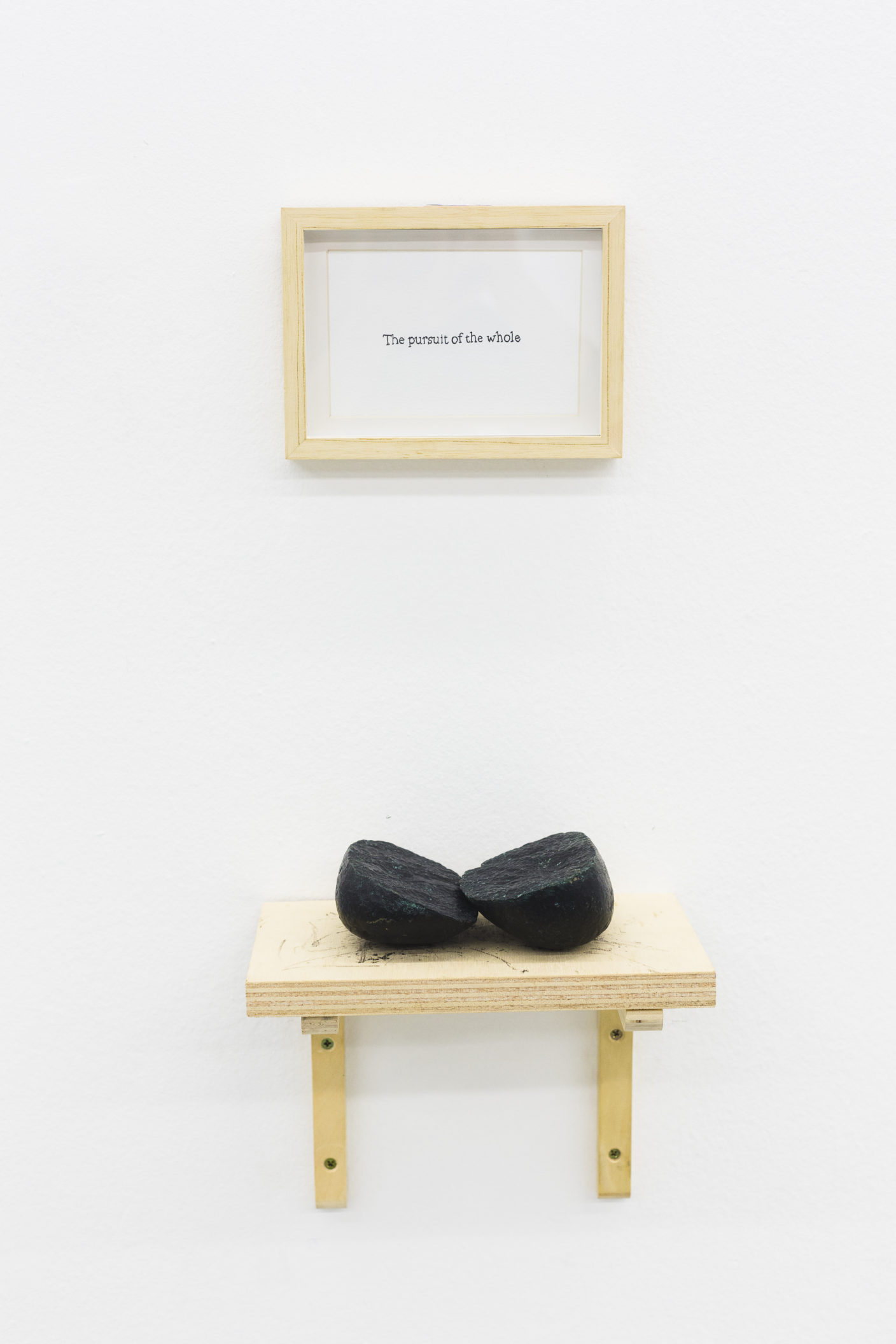
Pursuit of the whole, 2013/2014
Rock found divided in half, wooden shelf and graphite on paper.
This work was part of the exhibition “Norte”, at CCSP, São Paulo, 2014.
Norte is intricately linked to the artist’s experience in Iceland, during an artist residency in 2013. Living in Skagaströnd, populated with 500 residents in the north of the country, brought her close to this unique, silent, somewhat indomitable environment, synthesized in Mount Spákonufell, which ends up guiding the exhibition’s audiovisual piece and also spilling over into the rest of the exhibition. “In the place, I began to perceive a more geological time”, reports the artist.
[excerpt from the text “Mapas de matéria”, written by Mario Gioia for the exhibition]

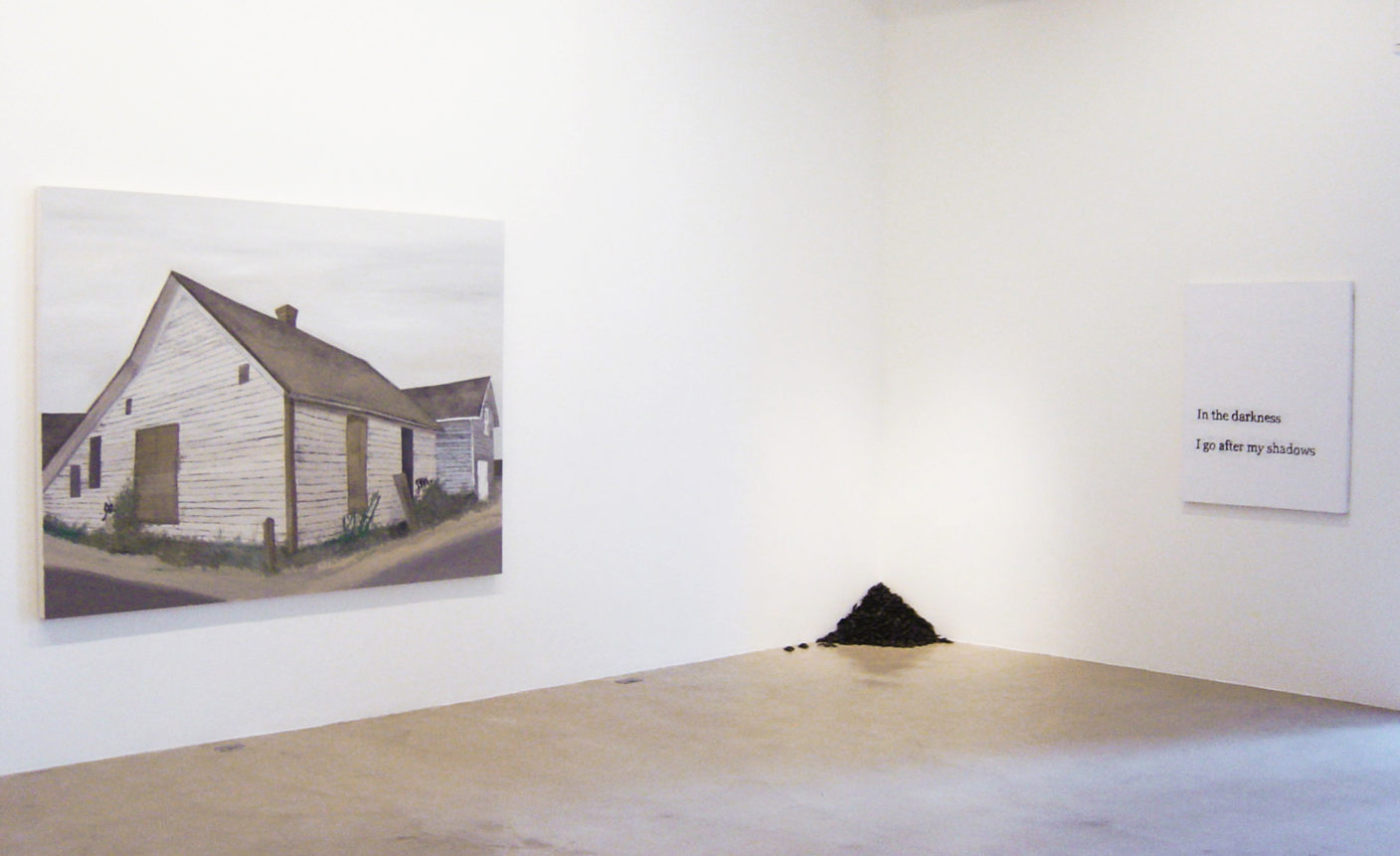
View of the exhibition The Damage Done, which took place at Galeria Laura Marsiaj, Rio de Janeiro, 2011.


The Damage Done, 2011
Installation
340 birds in bronze
This work was part of the exhibition The Damage Done, at Galeria Laura Marsiaj, Rio de Janeiro, 2011.
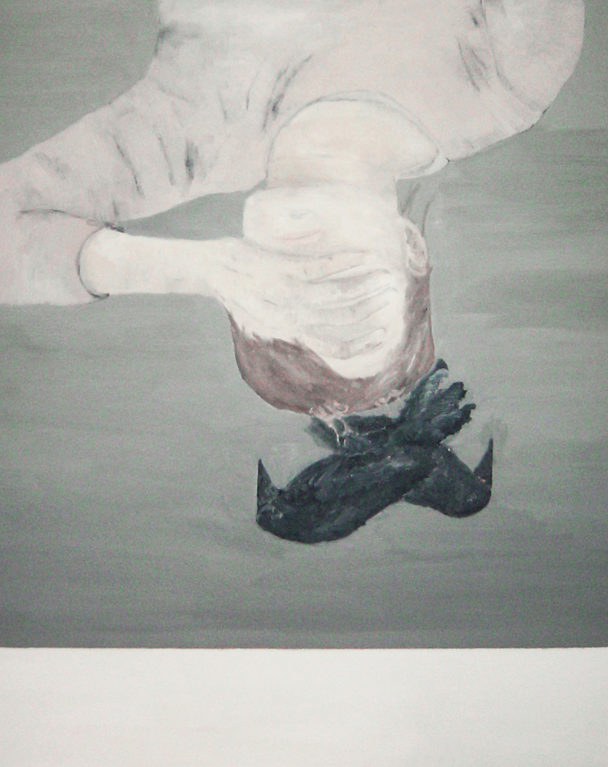
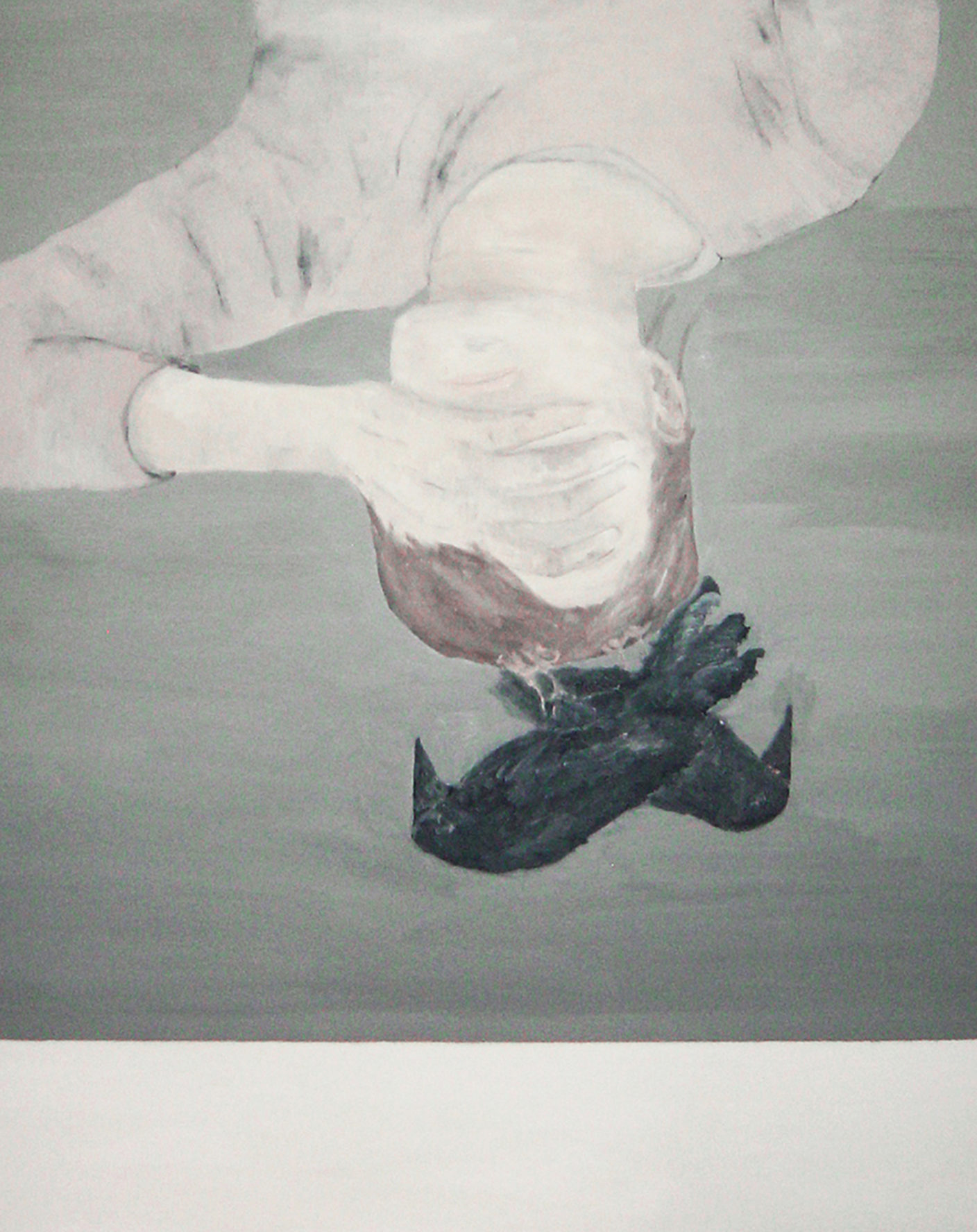
As tears go by II, 2011
Oil and wax on canvas
110 × 80 cm
This work was part of the exhibition The Damage Done, at Galeria Laura Marsiaj, Rio de Janeiro, 2011.
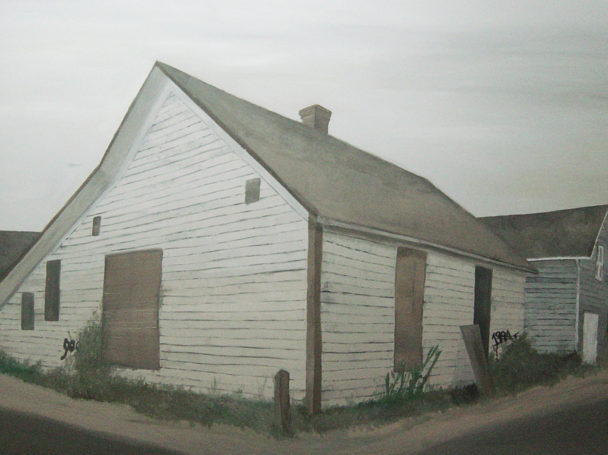
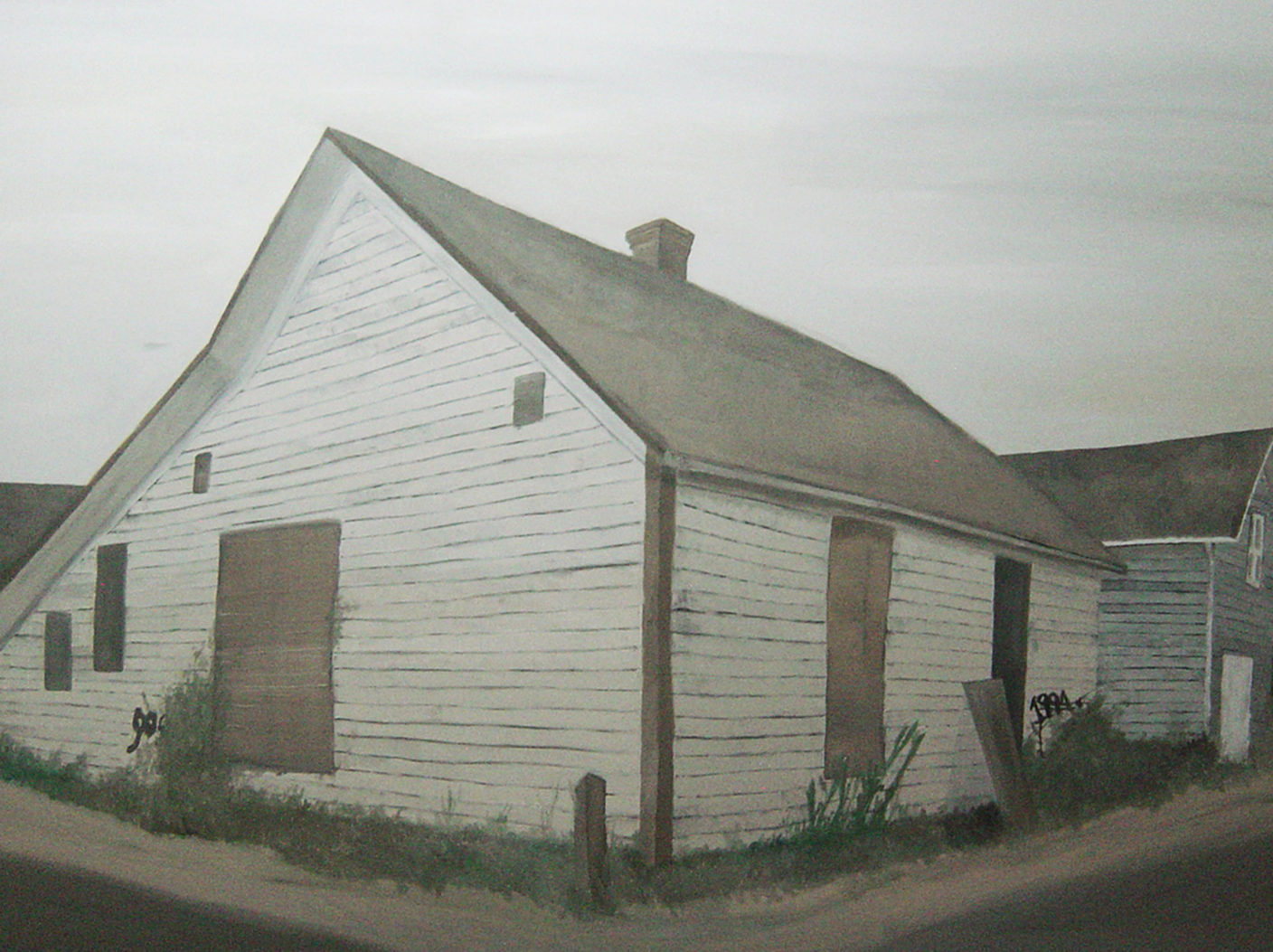
Aberdeen, 2011
Oil and wax on canvas
135 × 165 cm
This work was part of the exhibition The Damage Done, at Galeria Laura Marsiaj, Rio de Janeiro, 2011.


The Buried House, 2009
Oil and wax on canvas
90 × 90 cm
This work was part of the Harvest Memories exhibition, at Galeria Laura Marsiaj, Rio de Janeiro, 2010.
The works that Renata De Bonis presents in her solo show are the result of her residency at Highland Houses, in the desert of Joshua Tree, California. The heat bordering on unbearable, the loneliness and isolation, the wild animals, the light and the unique horizon of the desert resulted in paintings that mirror the artist’s experience in this inhospitable environment.
“The immensity of the scorching desert surprised me daily with a diversity of fauna and flora on my morning walks. It was impressive to realize that the desert is overflowing with life: coyotes, squirrels, rabbits, roadrunners, rattlesnakes, spiders, quail, cactus, creeping trees and even fruit trees appeared in my wanderings. The endless horizon made me think how small and powerless we are before the world.”


High Desert Notes, 2010
Oil and wax on canvas
80 × 80 cm
This work was part of the Harvest Memories exhibition, at Galeria Laura Marsiaj, Rio de Janeiro, 2010.
The works that Renata De Bonis presents in her solo show are the result of her residency at Highland Houses, in the desert of Joshua Tree, California. The heat bordering on unbearable, the loneliness and isolation, the wild animals, the light and the unique horizon of the desert resulted in paintings that mirror the artist’s experience in this inhospitable environment.
“The immensity of the scorching desert surprised me daily with a diversity of fauna and flora on my morning walks. It was impressive to realize that the desert is overflowing with life: coyotes, squirrels, rabbits, roadrunners, rattlesnakes, spiders, quail, cactus, creeping trees and even fruit trees appeared in my wanderings. The endless horizon made me think how small and powerless we are before the world.”


Yucca Valley, 2010
Oil and wax on canvas
90 × 110 cm
This work was part of the Harvest Memories exhibition, at Galeria Laura Marsiaj, Rio de Janeiro, 2010.
The works that Renata De Bonis presents in her solo show are the result of her residency at Highland Houses, in the desert of Joshua Tree, California. The heat bordering on unbearable, the loneliness and isolation, the wild animals, the light and the unique horizon of the desert resulted in paintings that mirror the artist’s experience in this inhospitable environment.
“The immensity of the scorching desert surprised me daily with a diversity of fauna and flora on my morning walks. It was impressive to realize that the desert is overflowing with life: coyotes, squirrels, rabbits, roadrunners, rattlesnakes, spiders, quail, cactus, creeping trees and even fruit trees appeared in my wanderings. The endless horizon made me think how small and powerless we are before the world.”


Noah’s washing machines, 2009
Oil and wax on canvas
90 × 90 cm
This work was part of the Harvest Memories exhibition, at Galeria Laura Marsiaj, Rio de Janeiro, 2010.
The works that Renata De Bonis presents in her solo show are the result of her residency at Highland Houses, in the desert of Joshua Tree, California. The heat bordering on unbearable, the loneliness and isolation, the wild animals, the light and the unique horizon of the desert resulted in paintings that mirror the artist’s experience in this inhospitable environment.
“The immensity of the scorching desert surprised me daily with a diversity of fauna and flora on my morning walks. It was impressive to realize that the desert is overflowing with life: coyotes, squirrels, rabbits, roadrunners, rattlesnakes, spiders, quail, cactus, creeping trees and even fruit trees appeared in my wanderings. The endless horizon made me think how small and powerless we are before the world.”


Coyote walk, 2010
Oil and wax on canvas
70 × 100 cm
This work was part of the Harvest Memories exhibition, at Galeria Laura Marsiaj, Rio de Janeiro, 2010.
The works that Renata De Bonis presents in her solo show are the result of her residency at Highland Houses, in the desert of Joshua Tree, California. The heat bordering on unbearable, the loneliness and isolation, the wild animals, the light and the unique horizon of the desert resulted in paintings that mirror the artist’s experience in this inhospitable environment.
“The immensity of the scorching desert surprised me daily with a diversity of fauna and flora on my morning walks. It was impressive to realize that the desert is overflowing with life: coyotes, squirrels, rabbits, roadrunners, rattlesnakes, spiders, quail, cactus, creeping trees and even fruit trees appeared in my wanderings. The endless horizon made me think how small and powerless we are before the world.”


 Português
Português